Drivers of Engagement Influencing Retention
VerifiedAdded on 2023/04/21
|70
|16285
|491
AI Summary
The aim of the research is to investigate the five drivers of employee engagement influencing employee retention. The five drivers to be analyzed are perceptions of job importance, clarity of job expectations, career advancement and improvement opportunities, regular feedback and dialogue with superiors, and quality of working relationships with peers, superiors and subordinates.
Contribute Materials
Your contribution can guide someone’s learning journey. Share your
documents today.
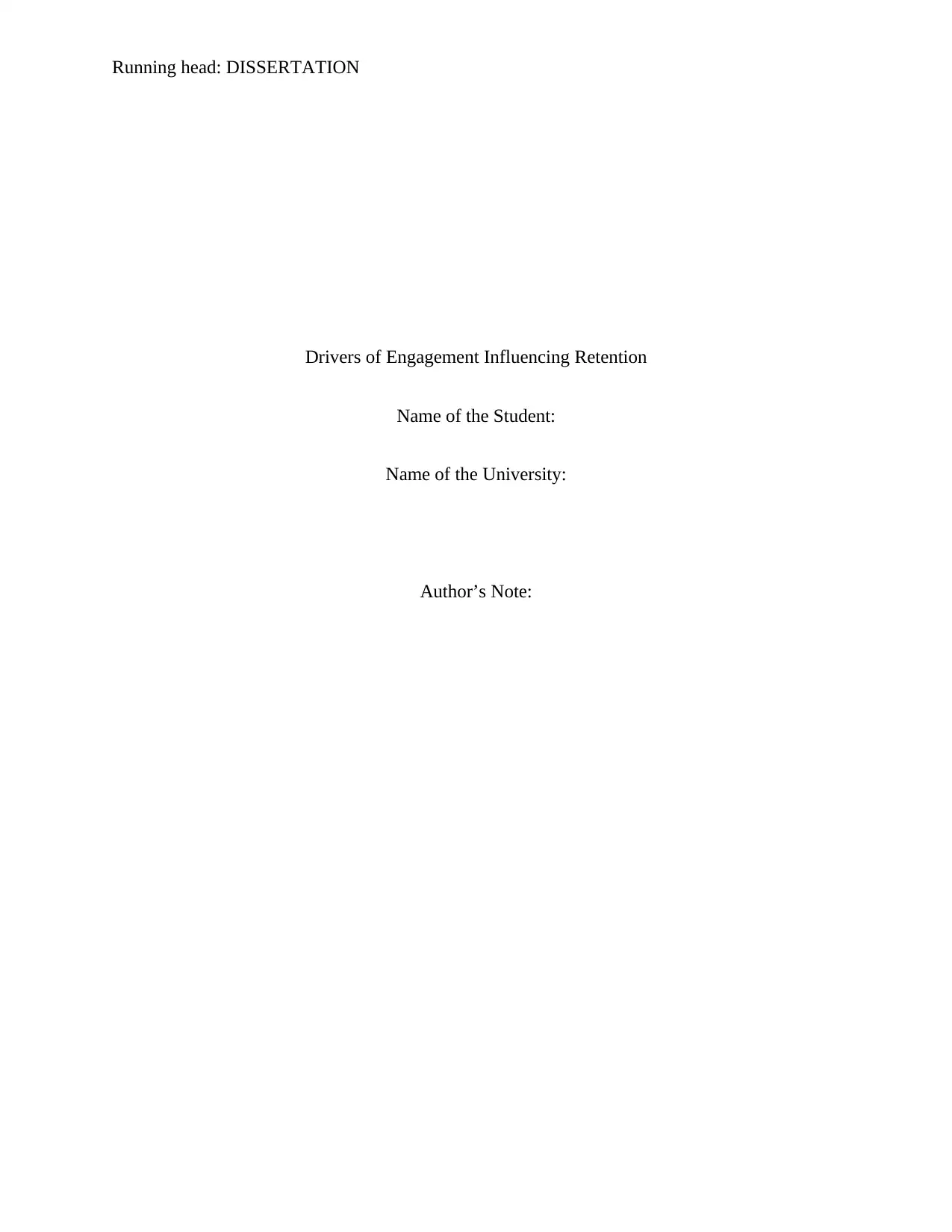
Running head: DISSERTATION
Drivers of Engagement Influencing Retention
Name of the Student:
Name of the University:
Author’s Note:
Drivers of Engagement Influencing Retention
Name of the Student:
Name of the University:
Author’s Note:
Secure Best Marks with AI Grader
Need help grading? Try our AI Grader for instant feedback on your assignments.
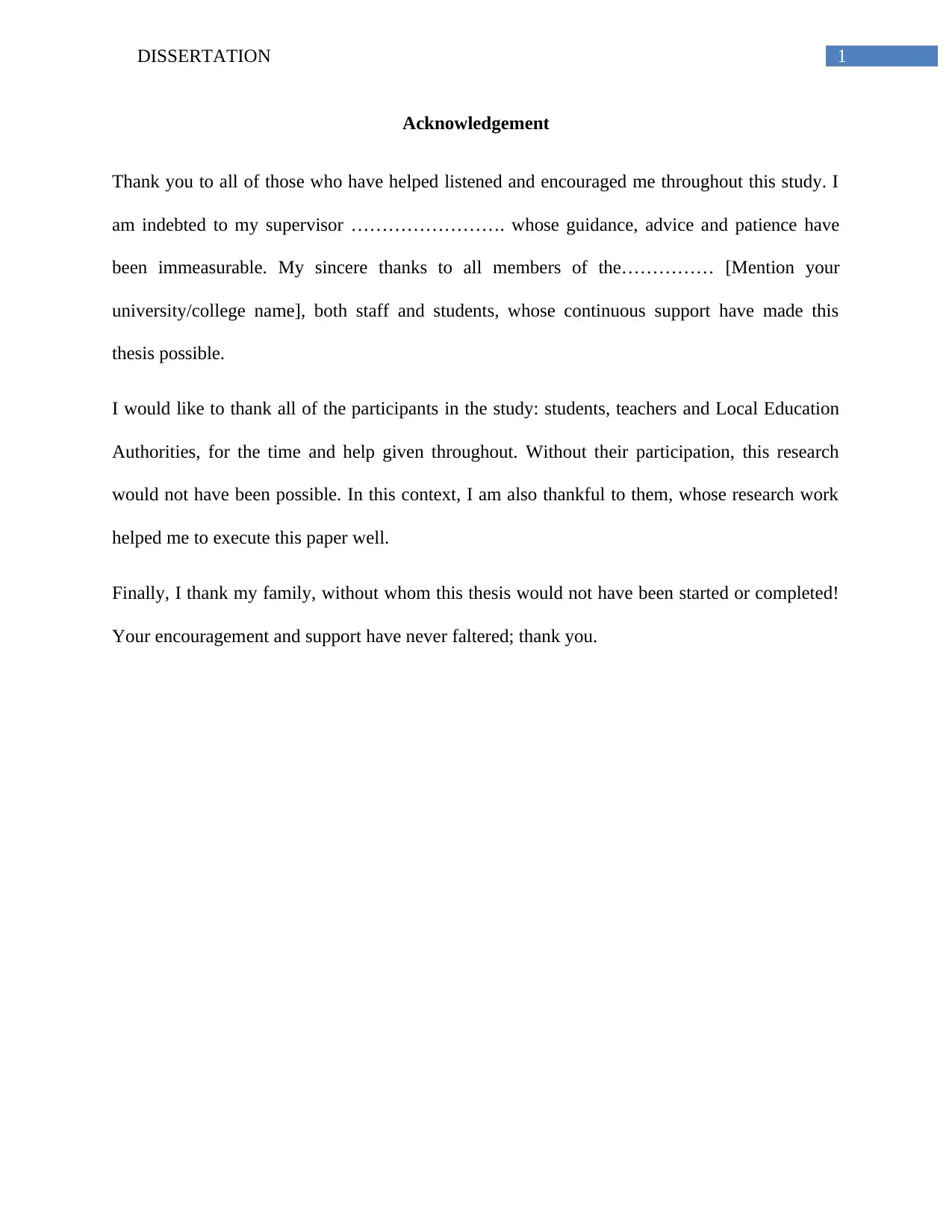
1DISSERTATION
Acknowledgement
Thank you to all of those who have helped listened and encouraged me throughout this study. I
am indebted to my supervisor ……………………. whose guidance, advice and patience have
been immeasurable. My sincere thanks to all members of the…………… [Mention your
university/college name], both staff and students, whose continuous support have made this
thesis possible.
I would like to thank all of the participants in the study: students, teachers and Local Education
Authorities, for the time and help given throughout. Without their participation, this research
would not have been possible. In this context, I am also thankful to them, whose research work
helped me to execute this paper well.
Finally, I thank my family, without whom this thesis would not have been started or completed!
Your encouragement and support have never faltered; thank you.
Acknowledgement
Thank you to all of those who have helped listened and encouraged me throughout this study. I
am indebted to my supervisor ……………………. whose guidance, advice and patience have
been immeasurable. My sincere thanks to all members of the…………… [Mention your
university/college name], both staff and students, whose continuous support have made this
thesis possible.
I would like to thank all of the participants in the study: students, teachers and Local Education
Authorities, for the time and help given throughout. Without their participation, this research
would not have been possible. In this context, I am also thankful to them, whose research work
helped me to execute this paper well.
Finally, I thank my family, without whom this thesis would not have been started or completed!
Your encouragement and support have never faltered; thank you.

2DISSERTATION
Abstract
The aim of the research is to investigate the five drivers of employee engagement influencing
employee retention. The five drivers to be analyzed are perceptions of job importance, clarity of
job expectations, career advancement and improvement opportunities, regular feedback and
dialogue with superiors, and quality of working relationships with peers, superiors and
subordinates. Engaging the employees successfully is a major issue, as the employees tend to
lose their interest and concentration due to similar and monotonous nature of their work. Lack of
employee engagement results in increased employee turnover rate for the business organizations
due to which the productivity is hampered.
It is difficult for the business organization retain the employees due to which the business
organization loose qualified and skilful employees that serve as assets. Analyzing the impact of
five drivers of employee engagement on employee retention is important, as this enables to
identify the potential gap of of employee engagement on employee retention. Identifying the
issues in the five factors of employee engagement will help in assessing the relationship between
the five factors of employee engagement and employee retention thereby, mitigating the
challenges that are faced by the business organizations.
In order to complete this research, positivism philosophy, deductive approach, descriptive design
and survey research strategy has been used. In accordance with the aforementioned
methodological tools, the researcher has selected 120 employees has been selected as the sample
size by using random probability sampling technique. The employees have been selected as the
sample size as this has helped in understanding the key drivers of employee engagement that
influences employee retention. As a result, primary data collection process and quantitative data
Abstract
The aim of the research is to investigate the five drivers of employee engagement influencing
employee retention. The five drivers to be analyzed are perceptions of job importance, clarity of
job expectations, career advancement and improvement opportunities, regular feedback and
dialogue with superiors, and quality of working relationships with peers, superiors and
subordinates. Engaging the employees successfully is a major issue, as the employees tend to
lose their interest and concentration due to similar and monotonous nature of their work. Lack of
employee engagement results in increased employee turnover rate for the business organizations
due to which the productivity is hampered.
It is difficult for the business organization retain the employees due to which the business
organization loose qualified and skilful employees that serve as assets. Analyzing the impact of
five drivers of employee engagement on employee retention is important, as this enables to
identify the potential gap of of employee engagement on employee retention. Identifying the
issues in the five factors of employee engagement will help in assessing the relationship between
the five factors of employee engagement and employee retention thereby, mitigating the
challenges that are faced by the business organizations.
In order to complete this research, positivism philosophy, deductive approach, descriptive design
and survey research strategy has been used. In accordance with the aforementioned
methodological tools, the researcher has selected 120 employees has been selected as the sample
size by using random probability sampling technique. The employees have been selected as the
sample size as this has helped in understanding the key drivers of employee engagement that
influences employee retention. As a result, primary data collection process and quantitative data
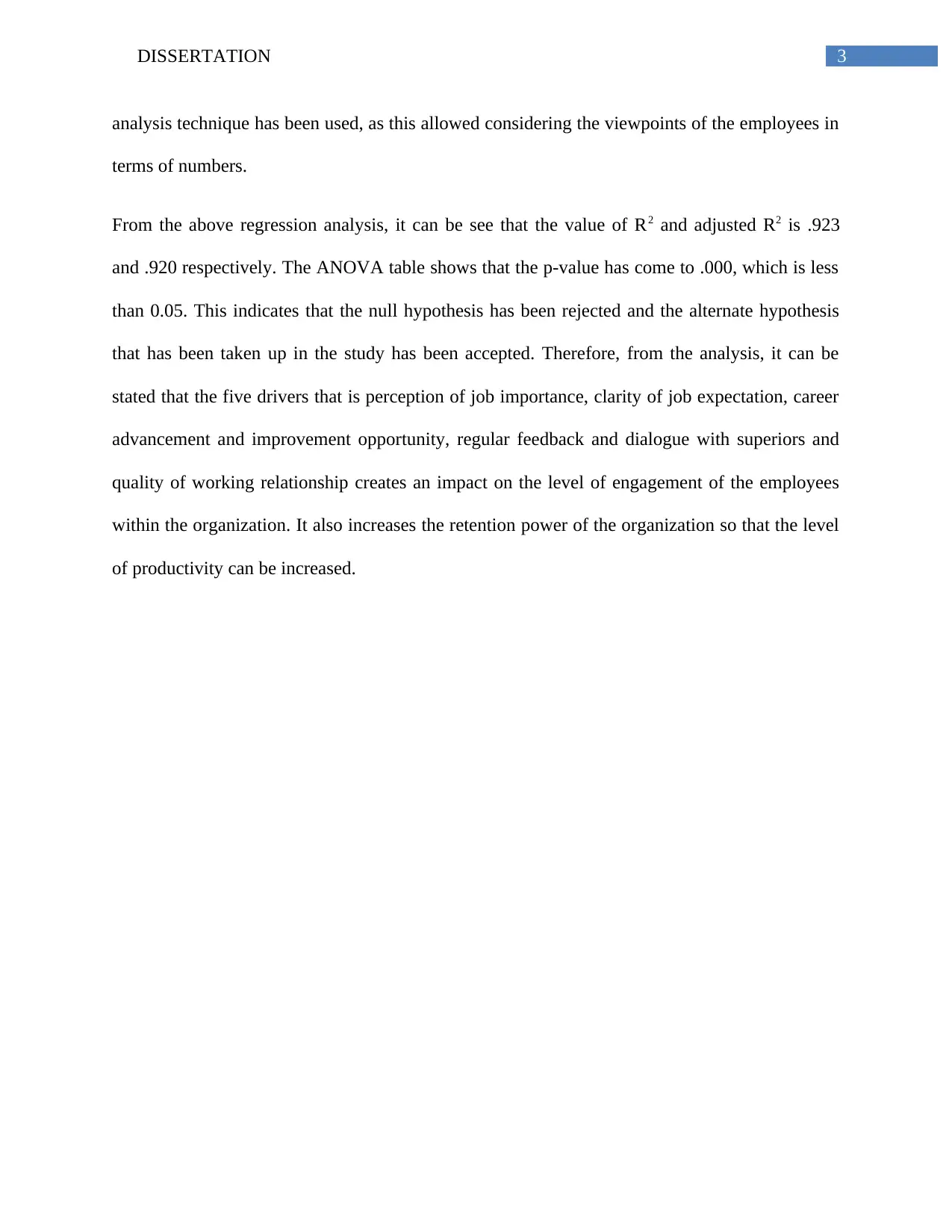
3DISSERTATION
analysis technique has been used, as this allowed considering the viewpoints of the employees in
terms of numbers.
From the above regression analysis, it can be see that the value of R2 and adjusted R2 is .923
and .920 respectively. The ANOVA table shows that the p-value has come to .000, which is less
than 0.05. This indicates that the null hypothesis has been rejected and the alternate hypothesis
that has been taken up in the study has been accepted. Therefore, from the analysis, it can be
stated that the five drivers that is perception of job importance, clarity of job expectation, career
advancement and improvement opportunity, regular feedback and dialogue with superiors and
quality of working relationship creates an impact on the level of engagement of the employees
within the organization. It also increases the retention power of the organization so that the level
of productivity can be increased.
analysis technique has been used, as this allowed considering the viewpoints of the employees in
terms of numbers.
From the above regression analysis, it can be see that the value of R2 and adjusted R2 is .923
and .920 respectively. The ANOVA table shows that the p-value has come to .000, which is less
than 0.05. This indicates that the null hypothesis has been rejected and the alternate hypothesis
that has been taken up in the study has been accepted. Therefore, from the analysis, it can be
stated that the five drivers that is perception of job importance, clarity of job expectation, career
advancement and improvement opportunity, regular feedback and dialogue with superiors and
quality of working relationship creates an impact on the level of engagement of the employees
within the organization. It also increases the retention power of the organization so that the level
of productivity can be increased.
Secure Best Marks with AI Grader
Need help grading? Try our AI Grader for instant feedback on your assignments.

4DISSERTATION
Table of Contents
Chapter 1: Introduction....................................................................................................................9
1.0 Overview...........................................................................................................................9
1.1 Problem statement.................................................................................................................9
1.2 Research aim........................................................................................................................10
1.3 Research objectives.............................................................................................................10
1.4 Research questions...............................................................................................................10
1.5 Research hypothesis.............................................................................................................11
1.6 Research rationale................................................................................................................12
1.7 Structure of the dissertation.................................................................................................12
1.8 Summary..............................................................................................................................13
Chapter 2: Literature review..........................................................................................................14
2.0 Overview..............................................................................................................................14
2.1 Concept of employee engagement.......................................................................................14
2.2 Factors affecting employee engagement.............................................................................14
2.2.1 Perceptions of job importance......................................................................................15
2.2.2 Clarity of job expectations............................................................................................15
2.2.3 Career advancement and improvement opportunities..................................................15
2.2.4 Regular feedback and dialogue with superiors.............................................................16
Table of Contents
Chapter 1: Introduction....................................................................................................................9
1.0 Overview...........................................................................................................................9
1.1 Problem statement.................................................................................................................9
1.2 Research aim........................................................................................................................10
1.3 Research objectives.............................................................................................................10
1.4 Research questions...............................................................................................................10
1.5 Research hypothesis.............................................................................................................11
1.6 Research rationale................................................................................................................12
1.7 Structure of the dissertation.................................................................................................12
1.8 Summary..............................................................................................................................13
Chapter 2: Literature review..........................................................................................................14
2.0 Overview..............................................................................................................................14
2.1 Concept of employee engagement.......................................................................................14
2.2 Factors affecting employee engagement.............................................................................14
2.2.1 Perceptions of job importance......................................................................................15
2.2.2 Clarity of job expectations............................................................................................15
2.2.3 Career advancement and improvement opportunities..................................................15
2.2.4 Regular feedback and dialogue with superiors.............................................................16
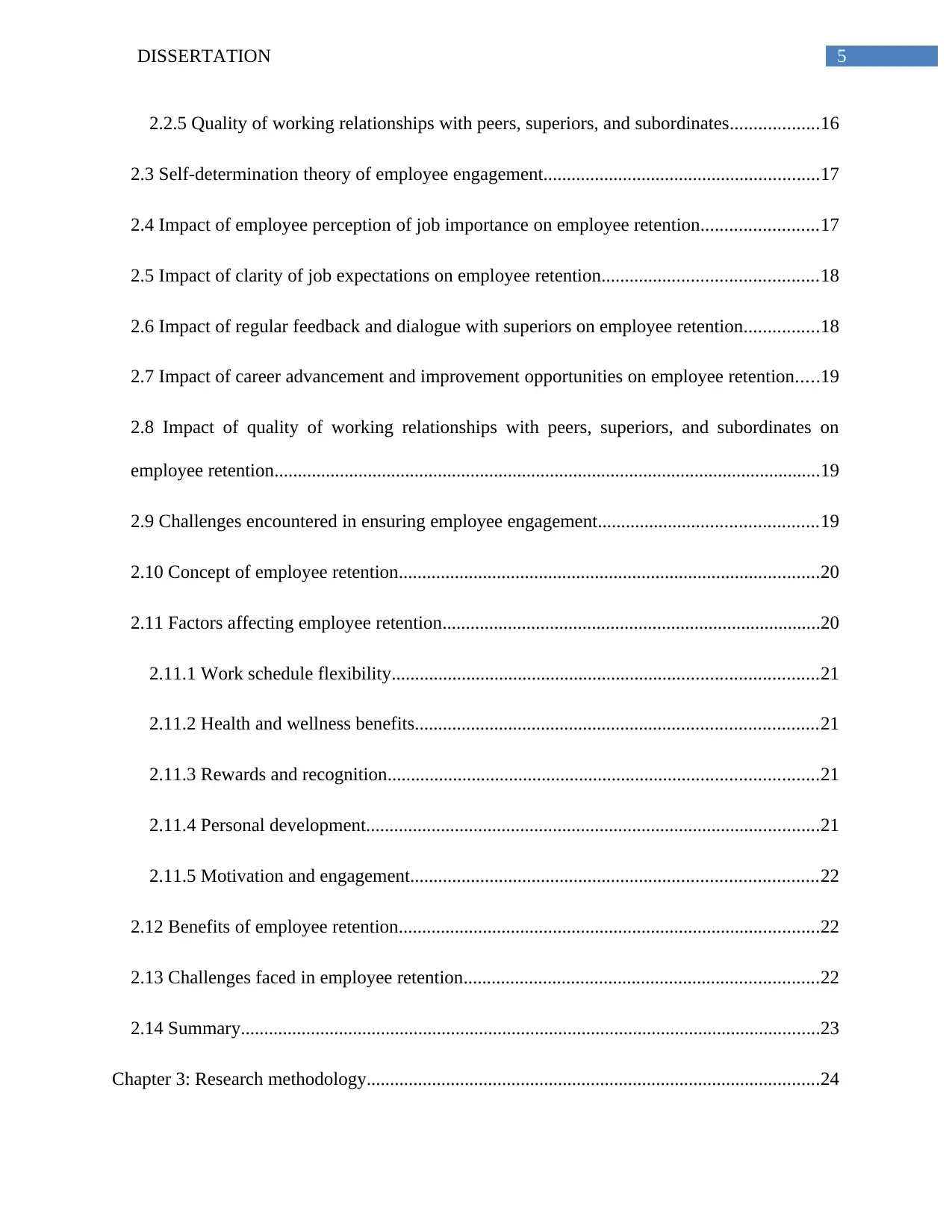
5DISSERTATION
2.2.5 Quality of working relationships with peers, superiors, and subordinates...................16
2.3 Self-determination theory of employee engagement...........................................................17
2.4 Impact of employee perception of job importance on employee retention.........................17
2.5 Impact of clarity of job expectations on employee retention..............................................18
2.6 Impact of regular feedback and dialogue with superiors on employee retention................18
2.7 Impact of career advancement and improvement opportunities on employee retention.....19
2.8 Impact of quality of working relationships with peers, superiors, and subordinates on
employee retention.....................................................................................................................19
2.9 Challenges encountered in ensuring employee engagement...............................................19
2.10 Concept of employee retention..........................................................................................20
2.11 Factors affecting employee retention.................................................................................20
2.11.1 Work schedule flexibility...........................................................................................21
2.11.2 Health and wellness benefits......................................................................................21
2.11.3 Rewards and recognition............................................................................................21
2.11.4 Personal development.................................................................................................21
2.11.5 Motivation and engagement.......................................................................................22
2.12 Benefits of employee retention..........................................................................................22
2.13 Challenges faced in employee retention............................................................................22
2.14 Summary............................................................................................................................23
Chapter 3: Research methodology.................................................................................................24
2.2.5 Quality of working relationships with peers, superiors, and subordinates...................16
2.3 Self-determination theory of employee engagement...........................................................17
2.4 Impact of employee perception of job importance on employee retention.........................17
2.5 Impact of clarity of job expectations on employee retention..............................................18
2.6 Impact of regular feedback and dialogue with superiors on employee retention................18
2.7 Impact of career advancement and improvement opportunities on employee retention.....19
2.8 Impact of quality of working relationships with peers, superiors, and subordinates on
employee retention.....................................................................................................................19
2.9 Challenges encountered in ensuring employee engagement...............................................19
2.10 Concept of employee retention..........................................................................................20
2.11 Factors affecting employee retention.................................................................................20
2.11.1 Work schedule flexibility...........................................................................................21
2.11.2 Health and wellness benefits......................................................................................21
2.11.3 Rewards and recognition............................................................................................21
2.11.4 Personal development.................................................................................................21
2.11.5 Motivation and engagement.......................................................................................22
2.12 Benefits of employee retention..........................................................................................22
2.13 Challenges faced in employee retention............................................................................22
2.14 Summary............................................................................................................................23
Chapter 3: Research methodology.................................................................................................24
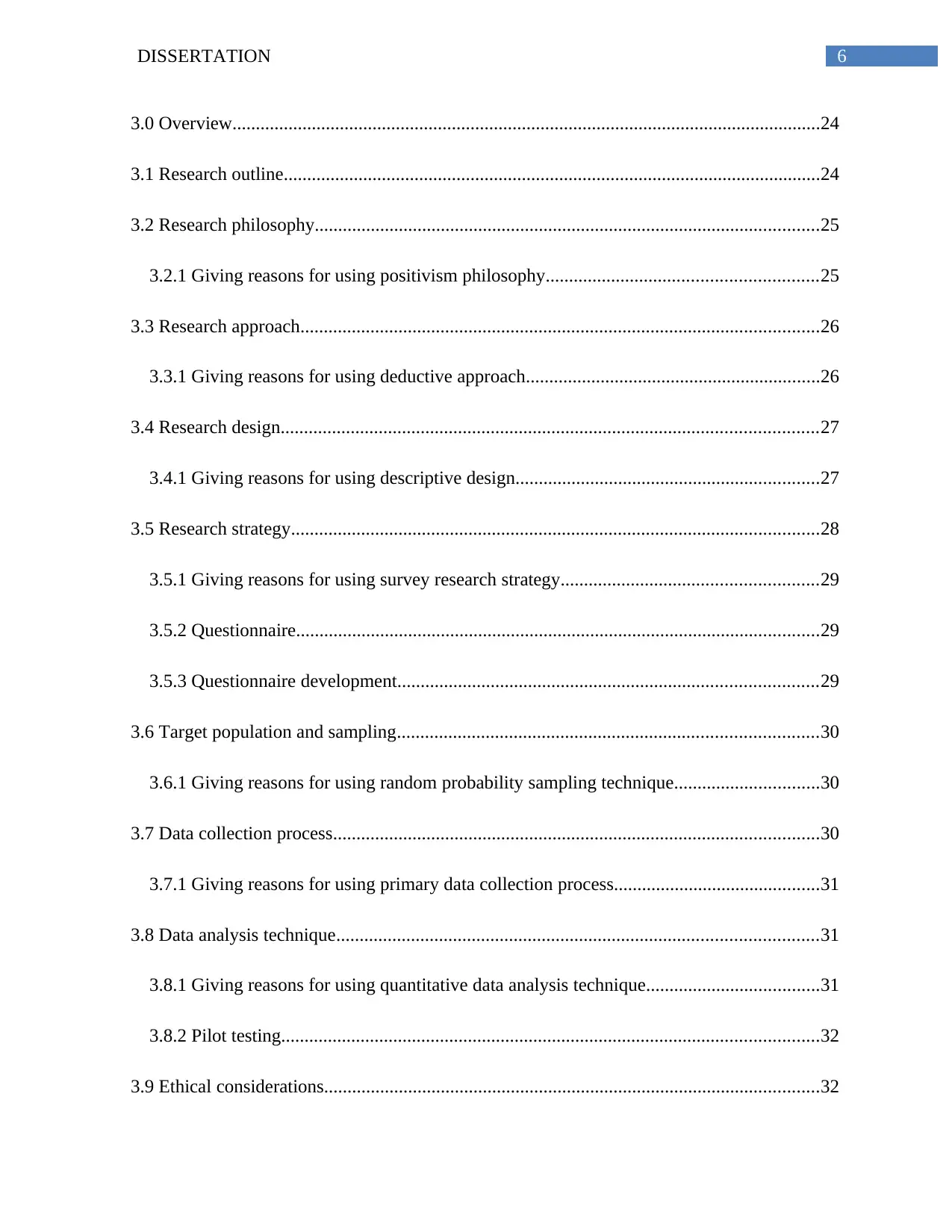
6DISSERTATION
3.0 Overview..............................................................................................................................24
3.1 Research outline...................................................................................................................24
3.2 Research philosophy............................................................................................................25
3.2.1 Giving reasons for using positivism philosophy..........................................................25
3.3 Research approach...............................................................................................................26
3.3.1 Giving reasons for using deductive approach...............................................................26
3.4 Research design...................................................................................................................27
3.4.1 Giving reasons for using descriptive design.................................................................27
3.5 Research strategy.................................................................................................................28
3.5.1 Giving reasons for using survey research strategy.......................................................29
3.5.2 Questionnaire................................................................................................................29
3.5.3 Questionnaire development..........................................................................................29
3.6 Target population and sampling..........................................................................................30
3.6.1 Giving reasons for using random probability sampling technique...............................30
3.7 Data collection process........................................................................................................30
3.7.1 Giving reasons for using primary data collection process............................................31
3.8 Data analysis technique.......................................................................................................31
3.8.1 Giving reasons for using quantitative data analysis technique.....................................31
3.8.2 Pilot testing...................................................................................................................32
3.9 Ethical considerations..........................................................................................................32
3.0 Overview..............................................................................................................................24
3.1 Research outline...................................................................................................................24
3.2 Research philosophy............................................................................................................25
3.2.1 Giving reasons for using positivism philosophy..........................................................25
3.3 Research approach...............................................................................................................26
3.3.1 Giving reasons for using deductive approach...............................................................26
3.4 Research design...................................................................................................................27
3.4.1 Giving reasons for using descriptive design.................................................................27
3.5 Research strategy.................................................................................................................28
3.5.1 Giving reasons for using survey research strategy.......................................................29
3.5.2 Questionnaire................................................................................................................29
3.5.3 Questionnaire development..........................................................................................29
3.6 Target population and sampling..........................................................................................30
3.6.1 Giving reasons for using random probability sampling technique...............................30
3.7 Data collection process........................................................................................................30
3.7.1 Giving reasons for using primary data collection process............................................31
3.8 Data analysis technique.......................................................................................................31
3.8.1 Giving reasons for using quantitative data analysis technique.....................................31
3.8.2 Pilot testing...................................................................................................................32
3.9 Ethical considerations..........................................................................................................32
Paraphrase This Document
Need a fresh take? Get an instant paraphrase of this document with our AI Paraphraser
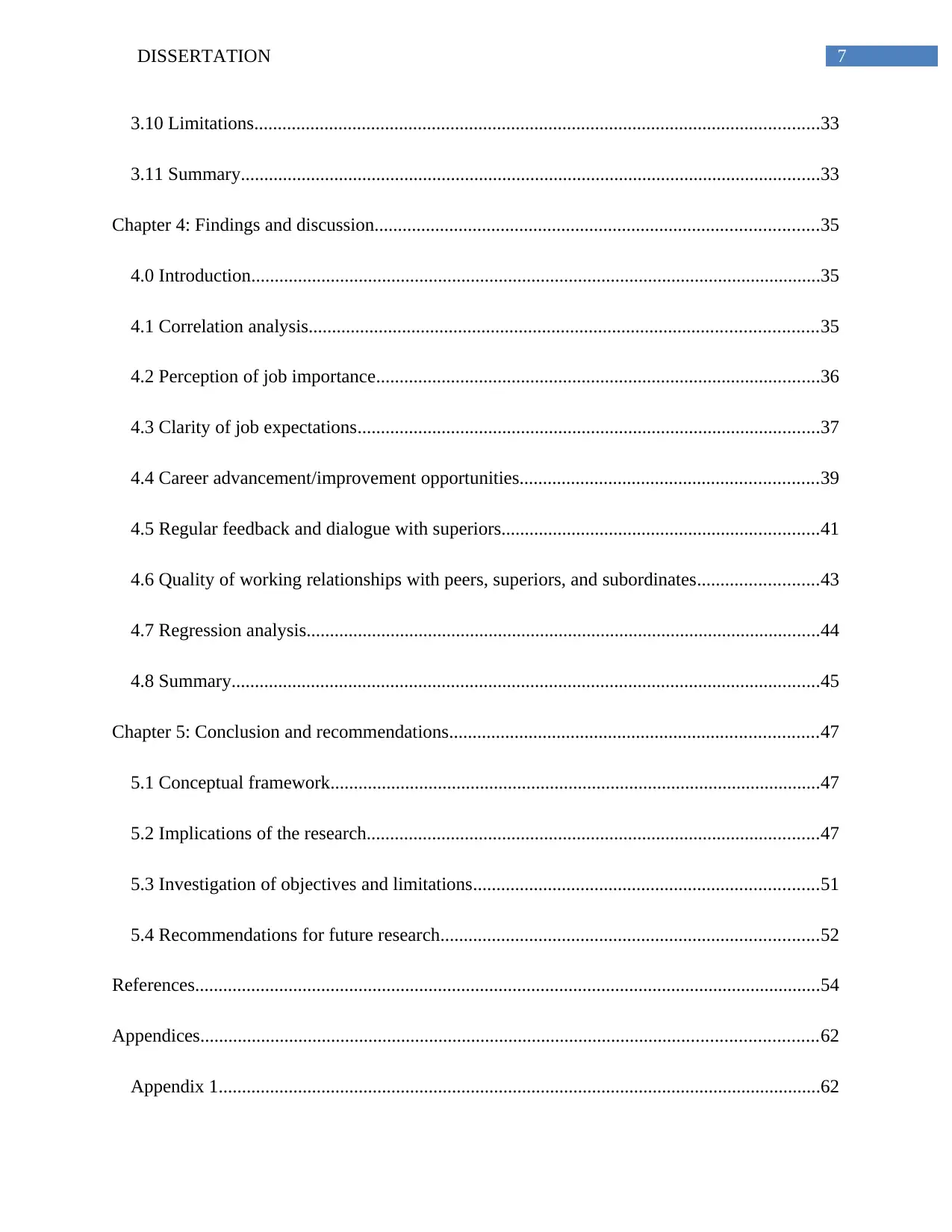
7DISSERTATION
3.10 Limitations.........................................................................................................................33
3.11 Summary............................................................................................................................33
Chapter 4: Findings and discussion...............................................................................................35
4.0 Introduction..........................................................................................................................35
4.1 Correlation analysis.............................................................................................................35
4.2 Perception of job importance...............................................................................................36
4.3 Clarity of job expectations...................................................................................................37
4.4 Career advancement/improvement opportunities................................................................39
4.5 Regular feedback and dialogue with superiors....................................................................41
4.6 Quality of working relationships with peers, superiors, and subordinates..........................43
4.7 Regression analysis..............................................................................................................44
4.8 Summary..............................................................................................................................45
Chapter 5: Conclusion and recommendations...............................................................................47
5.1 Conceptual framework.........................................................................................................47
5.2 Implications of the research.................................................................................................47
5.3 Investigation of objectives and limitations..........................................................................51
5.4 Recommendations for future research.................................................................................52
References......................................................................................................................................54
Appendices....................................................................................................................................62
Appendix 1.................................................................................................................................62
3.10 Limitations.........................................................................................................................33
3.11 Summary............................................................................................................................33
Chapter 4: Findings and discussion...............................................................................................35
4.0 Introduction..........................................................................................................................35
4.1 Correlation analysis.............................................................................................................35
4.2 Perception of job importance...............................................................................................36
4.3 Clarity of job expectations...................................................................................................37
4.4 Career advancement/improvement opportunities................................................................39
4.5 Regular feedback and dialogue with superiors....................................................................41
4.6 Quality of working relationships with peers, superiors, and subordinates..........................43
4.7 Regression analysis..............................................................................................................44
4.8 Summary..............................................................................................................................45
Chapter 5: Conclusion and recommendations...............................................................................47
5.1 Conceptual framework.........................................................................................................47
5.2 Implications of the research.................................................................................................47
5.3 Investigation of objectives and limitations..........................................................................51
5.4 Recommendations for future research.................................................................................52
References......................................................................................................................................54
Appendices....................................................................................................................................62
Appendix 1.................................................................................................................................62
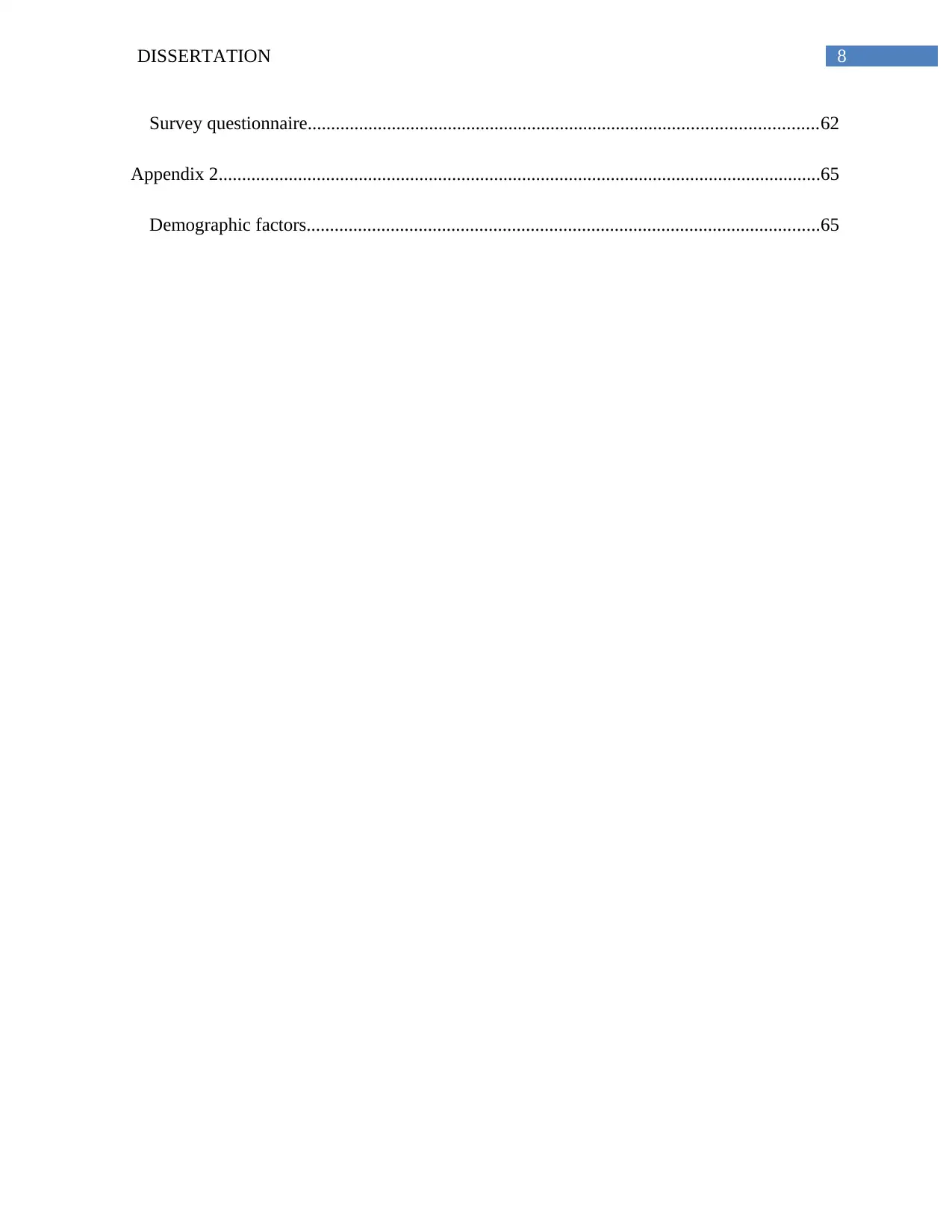
8DISSERTATION
Survey questionnaire.............................................................................................................62
Appendix 2.................................................................................................................................65
Demographic factors..............................................................................................................65
Survey questionnaire.............................................................................................................62
Appendix 2.................................................................................................................................65
Demographic factors..............................................................................................................65
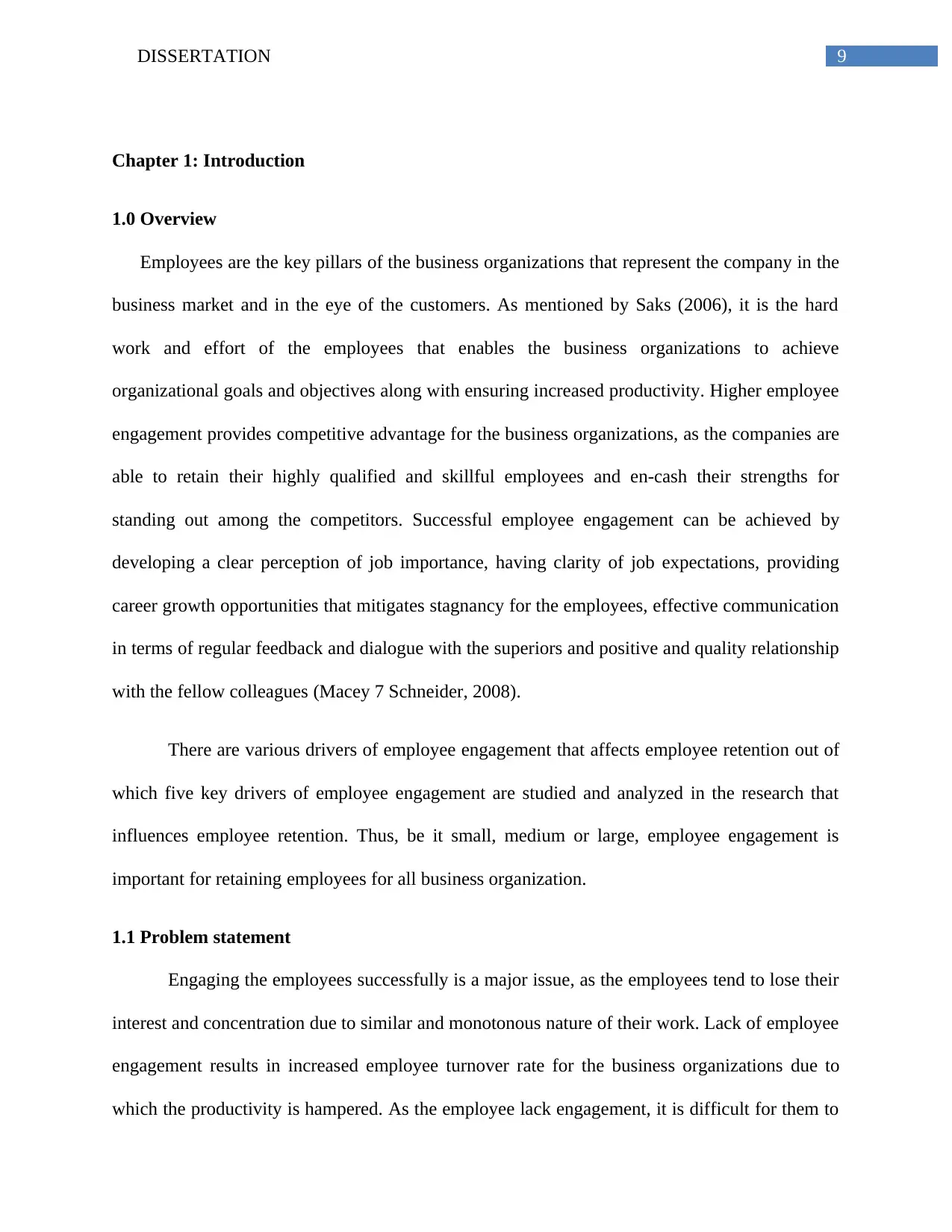
9DISSERTATION
Chapter 1: Introduction
1.0 Overview
Employees are the key pillars of the business organizations that represent the company in the
business market and in the eye of the customers. As mentioned by Saks (2006), it is the hard
work and effort of the employees that enables the business organizations to achieve
organizational goals and objectives along with ensuring increased productivity. Higher employee
engagement provides competitive advantage for the business organizations, as the companies are
able to retain their highly qualified and skillful employees and en-cash their strengths for
standing out among the competitors. Successful employee engagement can be achieved by
developing a clear perception of job importance, having clarity of job expectations, providing
career growth opportunities that mitigates stagnancy for the employees, effective communication
in terms of regular feedback and dialogue with the superiors and positive and quality relationship
with the fellow colleagues (Macey 7 Schneider, 2008).
There are various drivers of employee engagement that affects employee retention out of
which five key drivers of employee engagement are studied and analyzed in the research that
influences employee retention. Thus, be it small, medium or large, employee engagement is
important for retaining employees for all business organization.
1.1 Problem statement
Engaging the employees successfully is a major issue, as the employees tend to lose their
interest and concentration due to similar and monotonous nature of their work. Lack of employee
engagement results in increased employee turnover rate for the business organizations due to
which the productivity is hampered. As the employee lack engagement, it is difficult for them to
Chapter 1: Introduction
1.0 Overview
Employees are the key pillars of the business organizations that represent the company in the
business market and in the eye of the customers. As mentioned by Saks (2006), it is the hard
work and effort of the employees that enables the business organizations to achieve
organizational goals and objectives along with ensuring increased productivity. Higher employee
engagement provides competitive advantage for the business organizations, as the companies are
able to retain their highly qualified and skillful employees and en-cash their strengths for
standing out among the competitors. Successful employee engagement can be achieved by
developing a clear perception of job importance, having clarity of job expectations, providing
career growth opportunities that mitigates stagnancy for the employees, effective communication
in terms of regular feedback and dialogue with the superiors and positive and quality relationship
with the fellow colleagues (Macey 7 Schneider, 2008).
There are various drivers of employee engagement that affects employee retention out of
which five key drivers of employee engagement are studied and analyzed in the research that
influences employee retention. Thus, be it small, medium or large, employee engagement is
important for retaining employees for all business organization.
1.1 Problem statement
Engaging the employees successfully is a major issue, as the employees tend to lose their
interest and concentration due to similar and monotonous nature of their work. Lack of employee
engagement results in increased employee turnover rate for the business organizations due to
which the productivity is hampered. As the employee lack engagement, it is difficult for them to
Secure Best Marks with AI Grader
Need help grading? Try our AI Grader for instant feedback on your assignments.
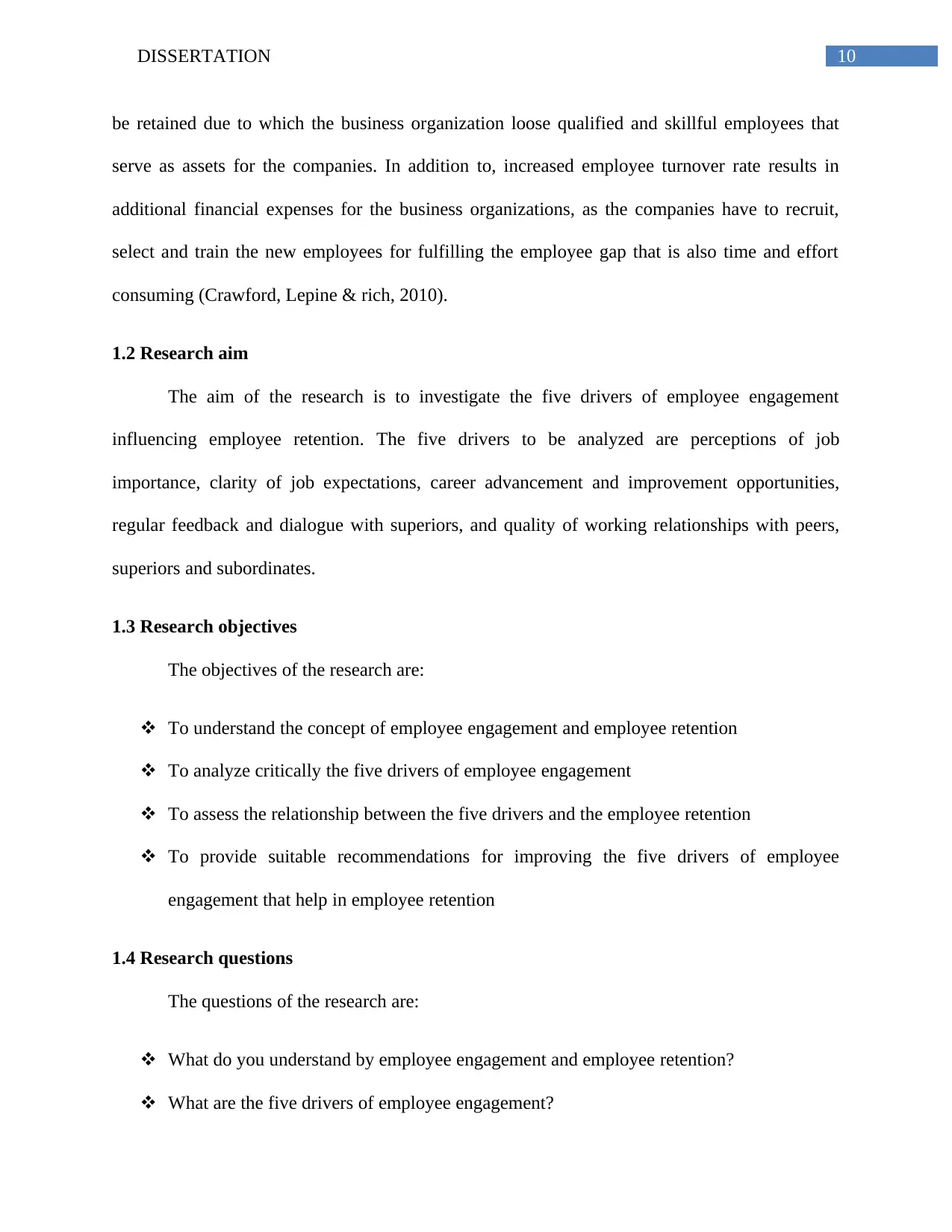
10DISSERTATION
be retained due to which the business organization loose qualified and skillful employees that
serve as assets for the companies. In addition to, increased employee turnover rate results in
additional financial expenses for the business organizations, as the companies have to recruit,
select and train the new employees for fulfilling the employee gap that is also time and effort
consuming (Crawford, Lepine & rich, 2010).
1.2 Research aim
The aim of the research is to investigate the five drivers of employee engagement
influencing employee retention. The five drivers to be analyzed are perceptions of job
importance, clarity of job expectations, career advancement and improvement opportunities,
regular feedback and dialogue with superiors, and quality of working relationships with peers,
superiors and subordinates.
1.3 Research objectives
The objectives of the research are:
To understand the concept of employee engagement and employee retention
To analyze critically the five drivers of employee engagement
To assess the relationship between the five drivers and the employee retention
To provide suitable recommendations for improving the five drivers of employee
engagement that help in employee retention
1.4 Research questions
The questions of the research are:
What do you understand by employee engagement and employee retention?
What are the five drivers of employee engagement?
be retained due to which the business organization loose qualified and skillful employees that
serve as assets for the companies. In addition to, increased employee turnover rate results in
additional financial expenses for the business organizations, as the companies have to recruit,
select and train the new employees for fulfilling the employee gap that is also time and effort
consuming (Crawford, Lepine & rich, 2010).
1.2 Research aim
The aim of the research is to investigate the five drivers of employee engagement
influencing employee retention. The five drivers to be analyzed are perceptions of job
importance, clarity of job expectations, career advancement and improvement opportunities,
regular feedback and dialogue with superiors, and quality of working relationships with peers,
superiors and subordinates.
1.3 Research objectives
The objectives of the research are:
To understand the concept of employee engagement and employee retention
To analyze critically the five drivers of employee engagement
To assess the relationship between the five drivers and the employee retention
To provide suitable recommendations for improving the five drivers of employee
engagement that help in employee retention
1.4 Research questions
The questions of the research are:
What do you understand by employee engagement and employee retention?
What are the five drivers of employee engagement?

11DISSERTATION
What is the relationship between the five drivers and employee retention?
What are the suitable recommendations for improving the five drivers of employee
engagement that help in employee retention?
1.5 Research hypothesis
The research hypotheses are:
Hypothesis 1:
H0: Perception of job importance does not affect employee retention
H1: Perception of job importance has an impact on employee retention
Hypothesis 2:
H0: Clarity of job expectation has no impact on employee retention
H2: Clarity of job expectation has an impact on employee retention
Hypothesis 3:
H0: Career advancement and improvement opportunity has no impact on employee retention
H3: Career advancement and improvement opportunity has an impact on employee retention
Hypothesis 4:
H0: Regular feedback and dialogue with superiors has no impact on employee retention
H4: Regular feedback and dialogue with superiors has an impact on employee retention
Hypothesis 5:
What is the relationship between the five drivers and employee retention?
What are the suitable recommendations for improving the five drivers of employee
engagement that help in employee retention?
1.5 Research hypothesis
The research hypotheses are:
Hypothesis 1:
H0: Perception of job importance does not affect employee retention
H1: Perception of job importance has an impact on employee retention
Hypothesis 2:
H0: Clarity of job expectation has no impact on employee retention
H2: Clarity of job expectation has an impact on employee retention
Hypothesis 3:
H0: Career advancement and improvement opportunity has no impact on employee retention
H3: Career advancement and improvement opportunity has an impact on employee retention
Hypothesis 4:
H0: Regular feedback and dialogue with superiors has no impact on employee retention
H4: Regular feedback and dialogue with superiors has an impact on employee retention
Hypothesis 5:
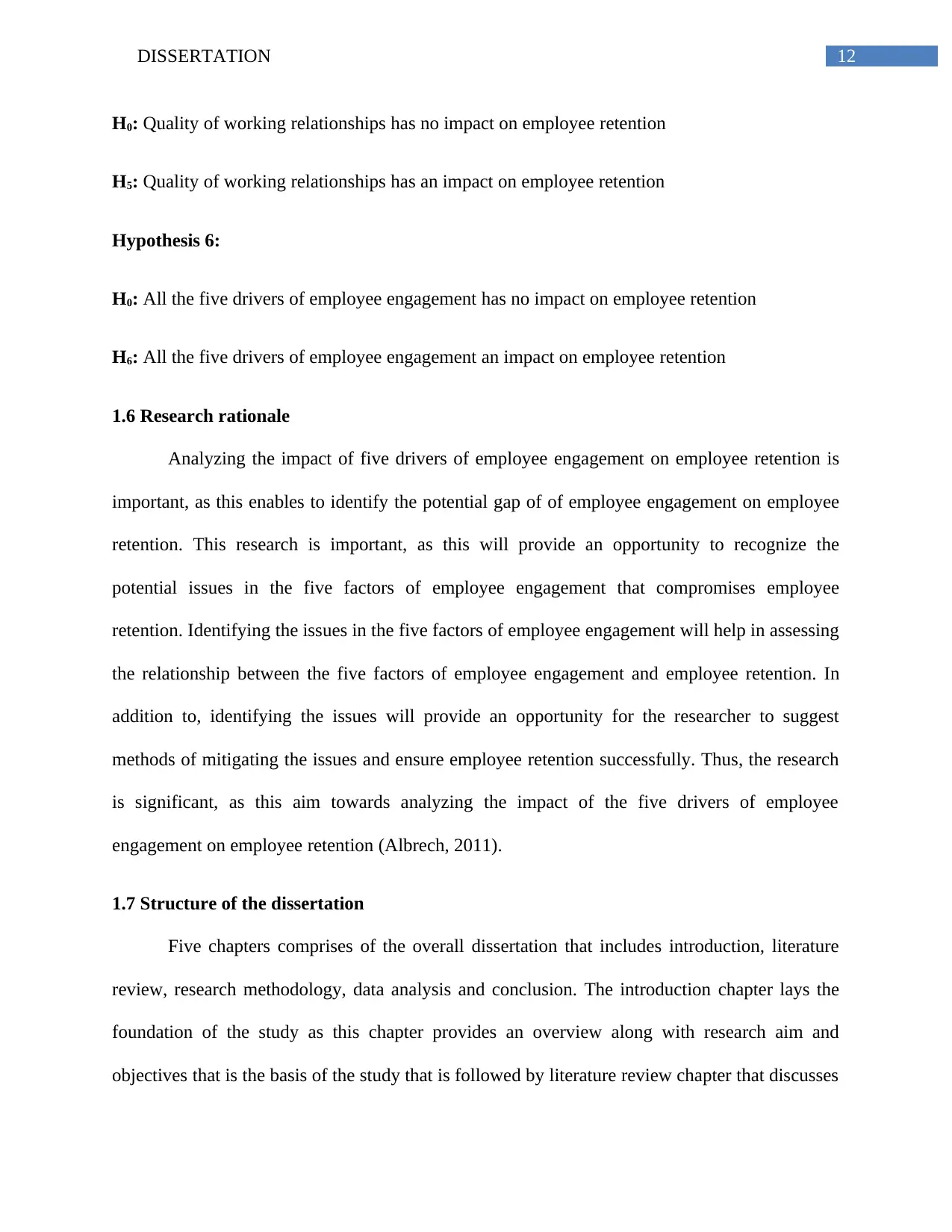
12DISSERTATION
H0: Quality of working relationships has no impact on employee retention
H5: Quality of working relationships has an impact on employee retention
Hypothesis 6:
H0: All the five drivers of employee engagement has no impact on employee retention
H6: All the five drivers of employee engagement an impact on employee retention
1.6 Research rationale
Analyzing the impact of five drivers of employee engagement on employee retention is
important, as this enables to identify the potential gap of of employee engagement on employee
retention. This research is important, as this will provide an opportunity to recognize the
potential issues in the five factors of employee engagement that compromises employee
retention. Identifying the issues in the five factors of employee engagement will help in assessing
the relationship between the five factors of employee engagement and employee retention. In
addition to, identifying the issues will provide an opportunity for the researcher to suggest
methods of mitigating the issues and ensure employee retention successfully. Thus, the research
is significant, as this aim towards analyzing the impact of the five drivers of employee
engagement on employee retention (Albrech, 2011).
1.7 Structure of the dissertation
Five chapters comprises of the overall dissertation that includes introduction, literature
review, research methodology, data analysis and conclusion. The introduction chapter lays the
foundation of the study as this chapter provides an overview along with research aim and
objectives that is the basis of the study that is followed by literature review chapter that discusses
H0: Quality of working relationships has no impact on employee retention
H5: Quality of working relationships has an impact on employee retention
Hypothesis 6:
H0: All the five drivers of employee engagement has no impact on employee retention
H6: All the five drivers of employee engagement an impact on employee retention
1.6 Research rationale
Analyzing the impact of five drivers of employee engagement on employee retention is
important, as this enables to identify the potential gap of of employee engagement on employee
retention. This research is important, as this will provide an opportunity to recognize the
potential issues in the five factors of employee engagement that compromises employee
retention. Identifying the issues in the five factors of employee engagement will help in assessing
the relationship between the five factors of employee engagement and employee retention. In
addition to, identifying the issues will provide an opportunity for the researcher to suggest
methods of mitigating the issues and ensure employee retention successfully. Thus, the research
is significant, as this aim towards analyzing the impact of the five drivers of employee
engagement on employee retention (Albrech, 2011).
1.7 Structure of the dissertation
Five chapters comprises of the overall dissertation that includes introduction, literature
review, research methodology, data analysis and conclusion. The introduction chapter lays the
foundation of the study as this chapter provides an overview along with research aim and
objectives that is the basis of the study that is followed by literature review chapter that discusses
Paraphrase This Document
Need a fresh take? Get an instant paraphrase of this document with our AI Paraphraser

13DISSERTATION
the five drivers of employee engagement separately. This chapter highlights critical evaluation
along with mentioning the concept of both the variables by referring to relevant theories and
models. The research methodology chapter that talks about the different methodological tools
and justifies the selection of the ones used for this study follows the second chapter. The fourth
chapter analyzes the data based on the selected methodology and is interpreted accordingly
followed by deducing conclusion and proposing recommendations for improving employee
engagement.
1.8 Summary
Thus, in this chapter, it can be summarized that it is essential for the business
organizations to engage their employees actively that help in retaining them. Adequate employee
retention results in decreased employee turnover rate and offers additional benefits for the
organizations in terms of productivity and profit. The five drivers of employee engagement such
as perception, clarity, career opportunity, regular feedback and relationship with fellow
colleagues thereby, ensuing increased and improved employee motivation, commitment and
dedication. As a result, the employees feel that their presence, effort and hard work is valued and
acknowledged by the business organizations and influences their decision to stick around with
the company for longer period.
the five drivers of employee engagement separately. This chapter highlights critical evaluation
along with mentioning the concept of both the variables by referring to relevant theories and
models. The research methodology chapter that talks about the different methodological tools
and justifies the selection of the ones used for this study follows the second chapter. The fourth
chapter analyzes the data based on the selected methodology and is interpreted accordingly
followed by deducing conclusion and proposing recommendations for improving employee
engagement.
1.8 Summary
Thus, in this chapter, it can be summarized that it is essential for the business
organizations to engage their employees actively that help in retaining them. Adequate employee
retention results in decreased employee turnover rate and offers additional benefits for the
organizations in terms of productivity and profit. The five drivers of employee engagement such
as perception, clarity, career opportunity, regular feedback and relationship with fellow
colleagues thereby, ensuing increased and improved employee motivation, commitment and
dedication. As a result, the employees feel that their presence, effort and hard work is valued and
acknowledged by the business organizations and influences their decision to stick around with
the company for longer period.

14DISSERTATION
Chapter 2: Literature review
2.0 Overview
The literature review chapter provides an overview of the concepts and analyses critically
the factors that affects the independent and dependent variables separately. For this study, the
five drivers of employee engagement are considered as the independent variable and employee
retention is the dependent variable that studied by referring to relevant data and information.
2.1 Concept of employee engagement
Successful employee engagement is necessary for the business organizations, as this
shows greater level of commitment and dedication from the employees towards their job roles
and responsibilities. As mentioned by Shuck and Wollard (2010), employee engagement is
defined as the extent the employees feel passionate about their job roles and responsibilities and
put required effort into their work. However, as argued by Gruman and Saks (2011), employee
engagement is considered as the fundamental concept that helps in accessing both qualitative and
quantitative nature of the relationship between the employees and the business organizations.
Thus, an engaged employee is defined as the one that is highly enthusiastic and fully absorbed
about his or her own job roles and responsibilities and use a positive approach for enhancing the
reputation and interest of the business organizations.
2.2 Factors affecting employee engagement
The five key drivers of employee engagement that is studied in this section are
perceptions of job importance, clarity of job expectations, career advancement and improvement
opportunities, regular feedback and dialogue with superiors, and quality of working relationships
with peers, superiors and subordinates.
Chapter 2: Literature review
2.0 Overview
The literature review chapter provides an overview of the concepts and analyses critically
the factors that affects the independent and dependent variables separately. For this study, the
five drivers of employee engagement are considered as the independent variable and employee
retention is the dependent variable that studied by referring to relevant data and information.
2.1 Concept of employee engagement
Successful employee engagement is necessary for the business organizations, as this
shows greater level of commitment and dedication from the employees towards their job roles
and responsibilities. As mentioned by Shuck and Wollard (2010), employee engagement is
defined as the extent the employees feel passionate about their job roles and responsibilities and
put required effort into their work. However, as argued by Gruman and Saks (2011), employee
engagement is considered as the fundamental concept that helps in accessing both qualitative and
quantitative nature of the relationship between the employees and the business organizations.
Thus, an engaged employee is defined as the one that is highly enthusiastic and fully absorbed
about his or her own job roles and responsibilities and use a positive approach for enhancing the
reputation and interest of the business organizations.
2.2 Factors affecting employee engagement
The five key drivers of employee engagement that is studied in this section are
perceptions of job importance, clarity of job expectations, career advancement and improvement
opportunities, regular feedback and dialogue with superiors, and quality of working relationships
with peers, superiors and subordinates.
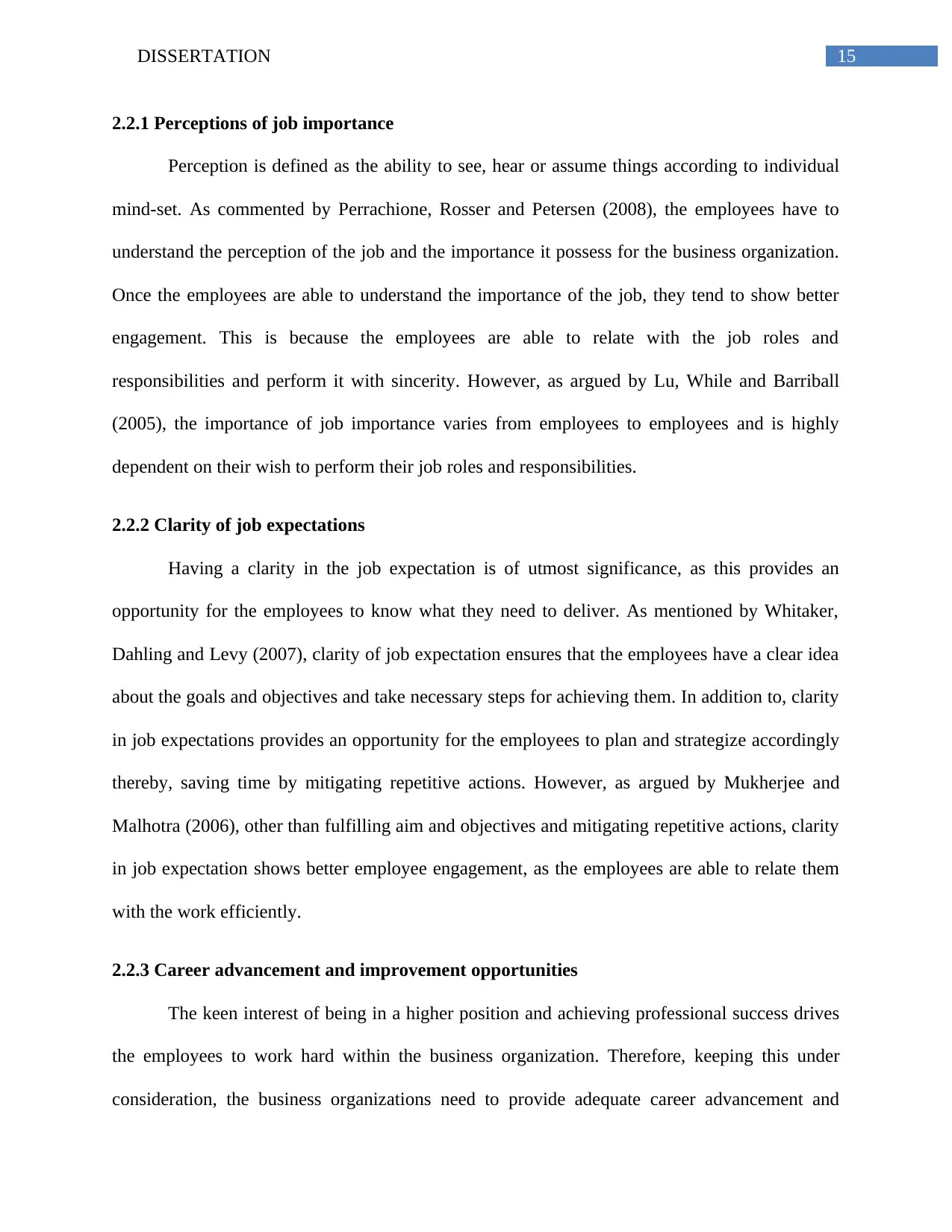
15DISSERTATION
2.2.1 Perceptions of job importance
Perception is defined as the ability to see, hear or assume things according to individual
mind-set. As commented by Perrachione, Rosser and Petersen (2008), the employees have to
understand the perception of the job and the importance it possess for the business organization.
Once the employees are able to understand the importance of the job, they tend to show better
engagement. This is because the employees are able to relate with the job roles and
responsibilities and perform it with sincerity. However, as argued by Lu, While and Barriball
(2005), the importance of job importance varies from employees to employees and is highly
dependent on their wish to perform their job roles and responsibilities.
2.2.2 Clarity of job expectations
Having a clarity in the job expectation is of utmost significance, as this provides an
opportunity for the employees to know what they need to deliver. As mentioned by Whitaker,
Dahling and Levy (2007), clarity of job expectation ensures that the employees have a clear idea
about the goals and objectives and take necessary steps for achieving them. In addition to, clarity
in job expectations provides an opportunity for the employees to plan and strategize accordingly
thereby, saving time by mitigating repetitive actions. However, as argued by Mukherjee and
Malhotra (2006), other than fulfilling aim and objectives and mitigating repetitive actions, clarity
in job expectation shows better employee engagement, as the employees are able to relate them
with the work efficiently.
2.2.3 Career advancement and improvement opportunities
The keen interest of being in a higher position and achieving professional success drives
the employees to work hard within the business organization. Therefore, keeping this under
consideration, the business organizations need to provide adequate career advancement and
2.2.1 Perceptions of job importance
Perception is defined as the ability to see, hear or assume things according to individual
mind-set. As commented by Perrachione, Rosser and Petersen (2008), the employees have to
understand the perception of the job and the importance it possess for the business organization.
Once the employees are able to understand the importance of the job, they tend to show better
engagement. This is because the employees are able to relate with the job roles and
responsibilities and perform it with sincerity. However, as argued by Lu, While and Barriball
(2005), the importance of job importance varies from employees to employees and is highly
dependent on their wish to perform their job roles and responsibilities.
2.2.2 Clarity of job expectations
Having a clarity in the job expectation is of utmost significance, as this provides an
opportunity for the employees to know what they need to deliver. As mentioned by Whitaker,
Dahling and Levy (2007), clarity of job expectation ensures that the employees have a clear idea
about the goals and objectives and take necessary steps for achieving them. In addition to, clarity
in job expectations provides an opportunity for the employees to plan and strategize accordingly
thereby, saving time by mitigating repetitive actions. However, as argued by Mukherjee and
Malhotra (2006), other than fulfilling aim and objectives and mitigating repetitive actions, clarity
in job expectation shows better employee engagement, as the employees are able to relate them
with the work efficiently.
2.2.3 Career advancement and improvement opportunities
The keen interest of being in a higher position and achieving professional success drives
the employees to work hard within the business organization. Therefore, keeping this under
consideration, the business organizations need to provide adequate career advancement and
Secure Best Marks with AI Grader
Need help grading? Try our AI Grader for instant feedback on your assignments.
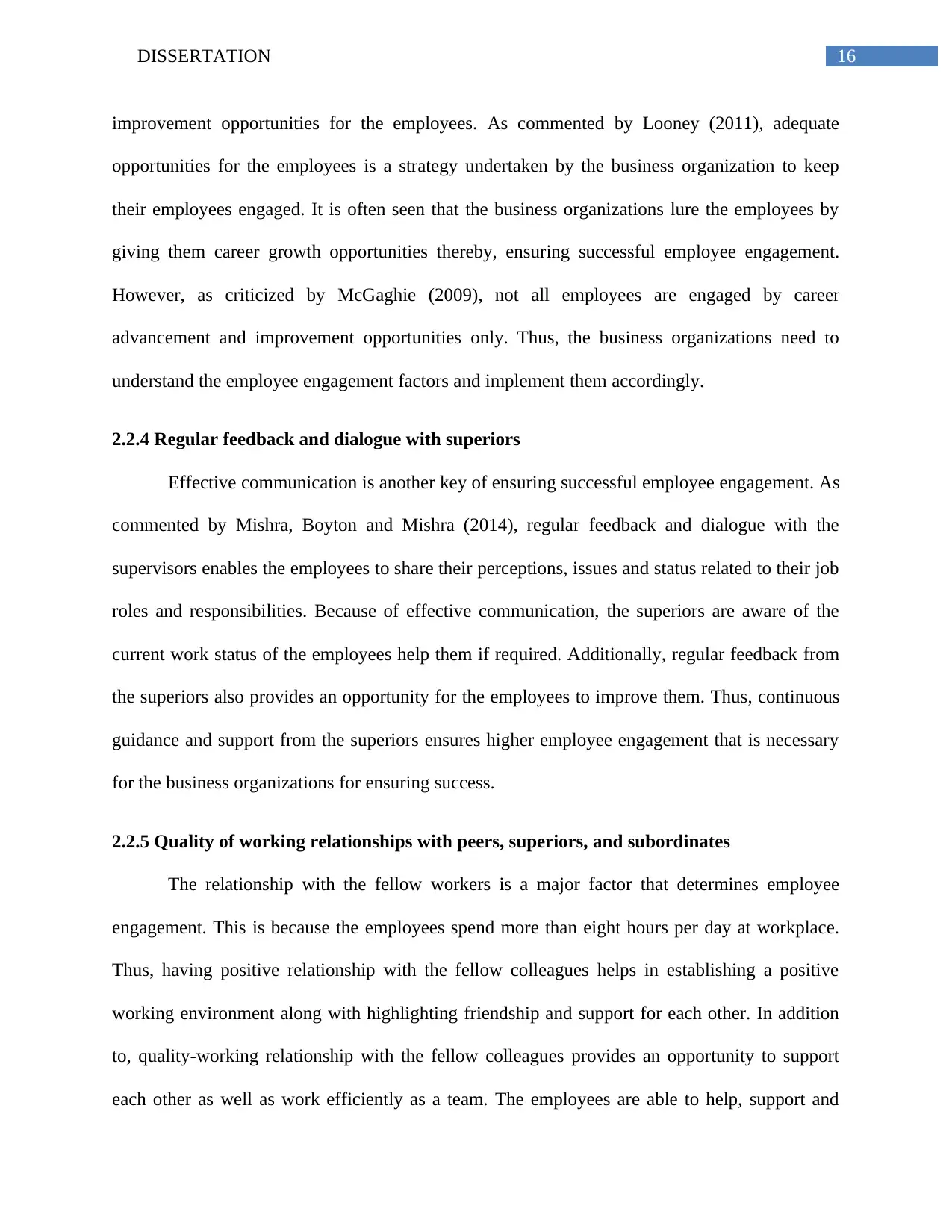
16DISSERTATION
improvement opportunities for the employees. As commented by Looney (2011), adequate
opportunities for the employees is a strategy undertaken by the business organization to keep
their employees engaged. It is often seen that the business organizations lure the employees by
giving them career growth opportunities thereby, ensuring successful employee engagement.
However, as criticized by McGaghie (2009), not all employees are engaged by career
advancement and improvement opportunities only. Thus, the business organizations need to
understand the employee engagement factors and implement them accordingly.
2.2.4 Regular feedback and dialogue with superiors
Effective communication is another key of ensuring successful employee engagement. As
commented by Mishra, Boyton and Mishra (2014), regular feedback and dialogue with the
supervisors enables the employees to share their perceptions, issues and status related to their job
roles and responsibilities. Because of effective communication, the superiors are aware of the
current work status of the employees help them if required. Additionally, regular feedback from
the superiors also provides an opportunity for the employees to improve them. Thus, continuous
guidance and support from the superiors ensures higher employee engagement that is necessary
for the business organizations for ensuring success.
2.2.5 Quality of working relationships with peers, superiors, and subordinates
The relationship with the fellow workers is a major factor that determines employee
engagement. This is because the employees spend more than eight hours per day at workplace.
Thus, having positive relationship with the fellow colleagues helps in establishing a positive
working environment along with highlighting friendship and support for each other. In addition
to, quality-working relationship with the fellow colleagues provides an opportunity to support
each other as well as work efficiently as a team. The employees are able to help, support and
improvement opportunities for the employees. As commented by Looney (2011), adequate
opportunities for the employees is a strategy undertaken by the business organization to keep
their employees engaged. It is often seen that the business organizations lure the employees by
giving them career growth opportunities thereby, ensuring successful employee engagement.
However, as criticized by McGaghie (2009), not all employees are engaged by career
advancement and improvement opportunities only. Thus, the business organizations need to
understand the employee engagement factors and implement them accordingly.
2.2.4 Regular feedback and dialogue with superiors
Effective communication is another key of ensuring successful employee engagement. As
commented by Mishra, Boyton and Mishra (2014), regular feedback and dialogue with the
supervisors enables the employees to share their perceptions, issues and status related to their job
roles and responsibilities. Because of effective communication, the superiors are aware of the
current work status of the employees help them if required. Additionally, regular feedback from
the superiors also provides an opportunity for the employees to improve them. Thus, continuous
guidance and support from the superiors ensures higher employee engagement that is necessary
for the business organizations for ensuring success.
2.2.5 Quality of working relationships with peers, superiors, and subordinates
The relationship with the fellow workers is a major factor that determines employee
engagement. This is because the employees spend more than eight hours per day at workplace.
Thus, having positive relationship with the fellow colleagues helps in establishing a positive
working environment along with highlighting friendship and support for each other. In addition
to, quality-working relationship with the fellow colleagues provides an opportunity to support
each other as well as work efficiently as a team. The employees are able to help, support and
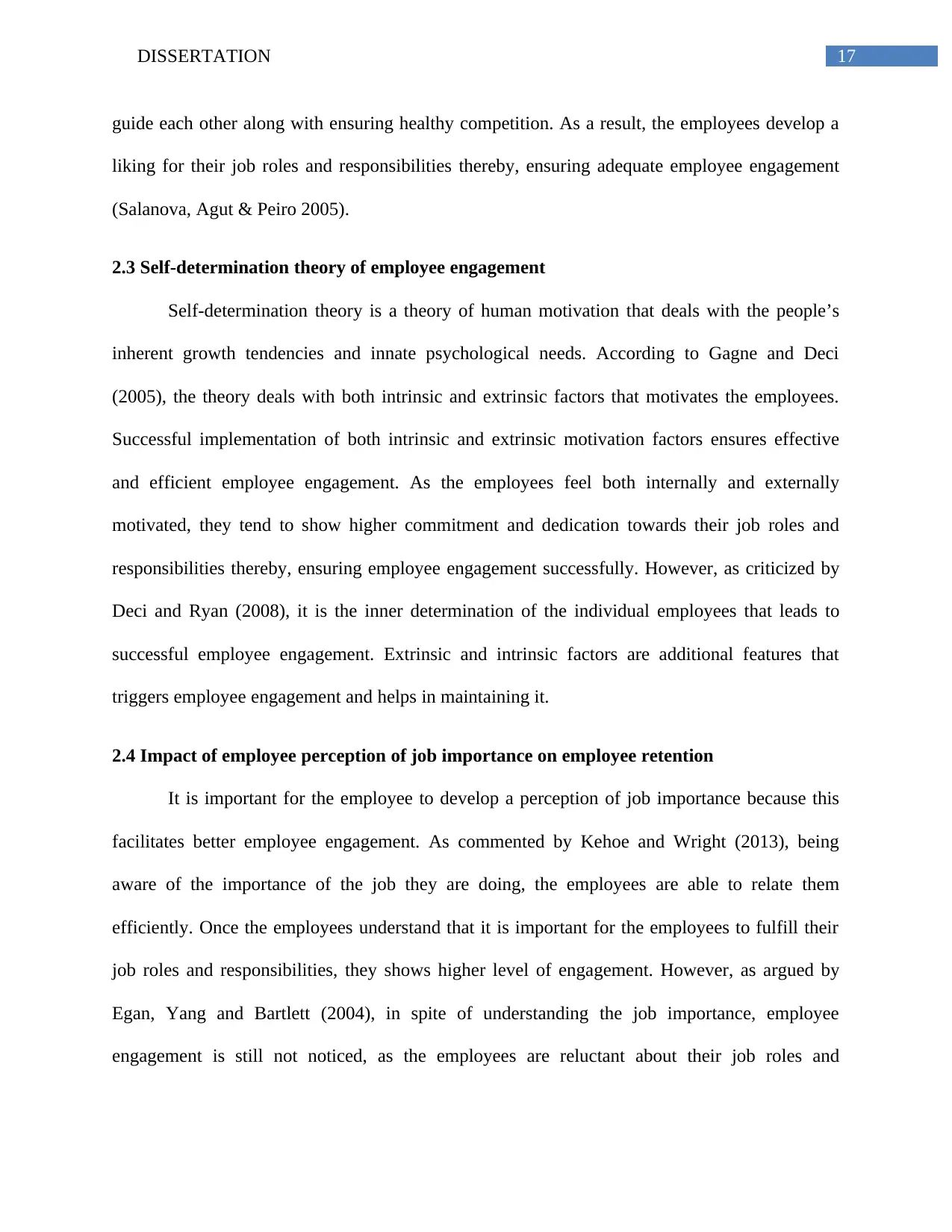
17DISSERTATION
guide each other along with ensuring healthy competition. As a result, the employees develop a
liking for their job roles and responsibilities thereby, ensuring adequate employee engagement
(Salanova, Agut & Peiro 2005).
2.3 Self-determination theory of employee engagement
Self-determination theory is a theory of human motivation that deals with the people’s
inherent growth tendencies and innate psychological needs. According to Gagne and Deci
(2005), the theory deals with both intrinsic and extrinsic factors that motivates the employees.
Successful implementation of both intrinsic and extrinsic motivation factors ensures effective
and efficient employee engagement. As the employees feel both internally and externally
motivated, they tend to show higher commitment and dedication towards their job roles and
responsibilities thereby, ensuring employee engagement successfully. However, as criticized by
Deci and Ryan (2008), it is the inner determination of the individual employees that leads to
successful employee engagement. Extrinsic and intrinsic factors are additional features that
triggers employee engagement and helps in maintaining it.
2.4 Impact of employee perception of job importance on employee retention
It is important for the employee to develop a perception of job importance because this
facilitates better employee engagement. As commented by Kehoe and Wright (2013), being
aware of the importance of the job they are doing, the employees are able to relate them
efficiently. Once the employees understand that it is important for the employees to fulfill their
job roles and responsibilities, they shows higher level of engagement. However, as argued by
Egan, Yang and Bartlett (2004), in spite of understanding the job importance, employee
engagement is still not noticed, as the employees are reluctant about their job roles and
guide each other along with ensuring healthy competition. As a result, the employees develop a
liking for their job roles and responsibilities thereby, ensuring adequate employee engagement
(Salanova, Agut & Peiro 2005).
2.3 Self-determination theory of employee engagement
Self-determination theory is a theory of human motivation that deals with the people’s
inherent growth tendencies and innate psychological needs. According to Gagne and Deci
(2005), the theory deals with both intrinsic and extrinsic factors that motivates the employees.
Successful implementation of both intrinsic and extrinsic motivation factors ensures effective
and efficient employee engagement. As the employees feel both internally and externally
motivated, they tend to show higher commitment and dedication towards their job roles and
responsibilities thereby, ensuring employee engagement successfully. However, as criticized by
Deci and Ryan (2008), it is the inner determination of the individual employees that leads to
successful employee engagement. Extrinsic and intrinsic factors are additional features that
triggers employee engagement and helps in maintaining it.
2.4 Impact of employee perception of job importance on employee retention
It is important for the employee to develop a perception of job importance because this
facilitates better employee engagement. As commented by Kehoe and Wright (2013), being
aware of the importance of the job they are doing, the employees are able to relate them
efficiently. Once the employees understand that it is important for the employees to fulfill their
job roles and responsibilities, they shows higher level of engagement. However, as argued by
Egan, Yang and Bartlett (2004), in spite of understanding the job importance, employee
engagement is still not noticed, as the employees are reluctant about their job roles and
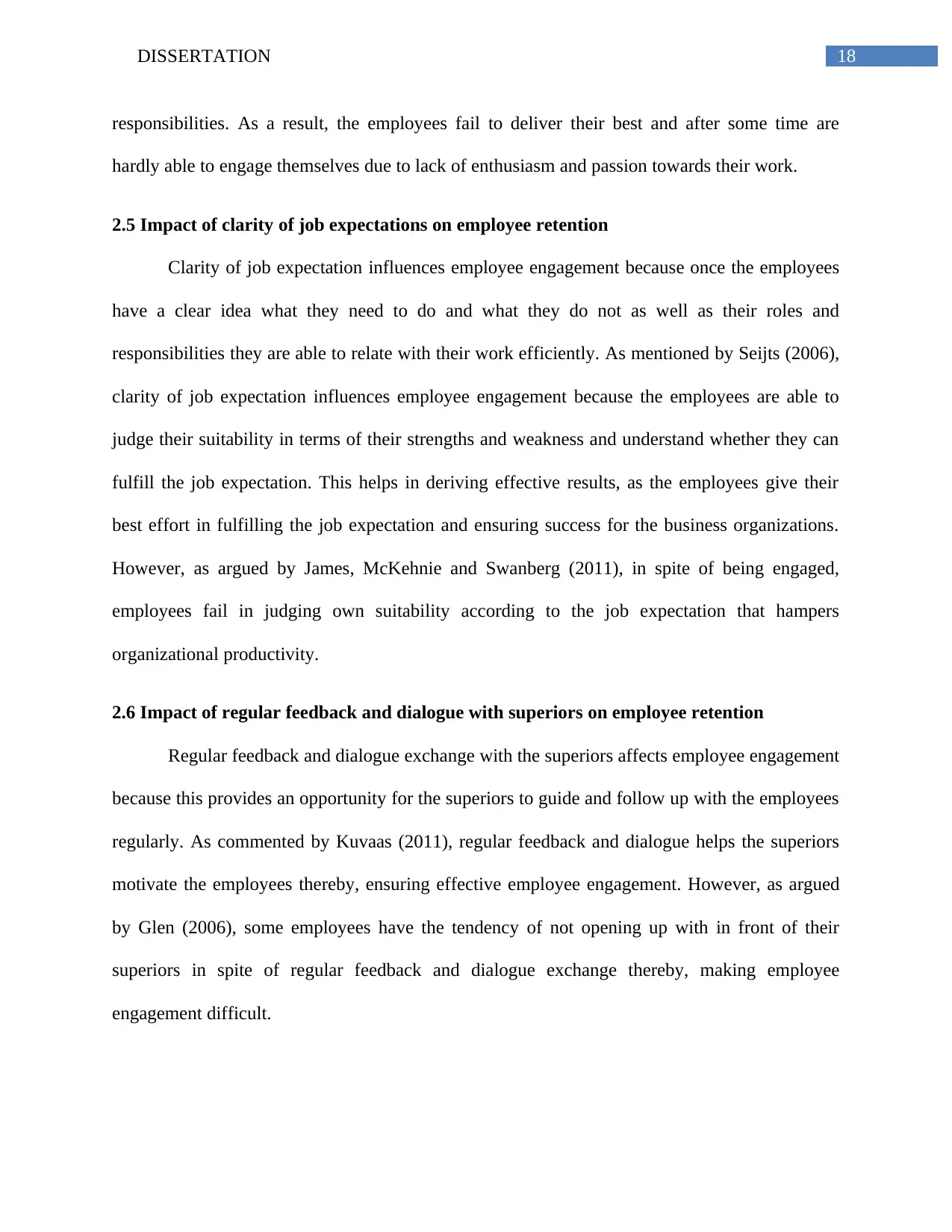
18DISSERTATION
responsibilities. As a result, the employees fail to deliver their best and after some time are
hardly able to engage themselves due to lack of enthusiasm and passion towards their work.
2.5 Impact of clarity of job expectations on employee retention
Clarity of job expectation influences employee engagement because once the employees
have a clear idea what they need to do and what they do not as well as their roles and
responsibilities they are able to relate with their work efficiently. As mentioned by Seijts (2006),
clarity of job expectation influences employee engagement because the employees are able to
judge their suitability in terms of their strengths and weakness and understand whether they can
fulfill the job expectation. This helps in deriving effective results, as the employees give their
best effort in fulfilling the job expectation and ensuring success for the business organizations.
However, as argued by James, McKehnie and Swanberg (2011), in spite of being engaged,
employees fail in judging own suitability according to the job expectation that hampers
organizational productivity.
2.6 Impact of regular feedback and dialogue with superiors on employee retention
Regular feedback and dialogue exchange with the superiors affects employee engagement
because this provides an opportunity for the superiors to guide and follow up with the employees
regularly. As commented by Kuvaas (2011), regular feedback and dialogue helps the superiors
motivate the employees thereby, ensuring effective employee engagement. However, as argued
by Glen (2006), some employees have the tendency of not opening up with in front of their
superiors in spite of regular feedback and dialogue exchange thereby, making employee
engagement difficult.
responsibilities. As a result, the employees fail to deliver their best and after some time are
hardly able to engage themselves due to lack of enthusiasm and passion towards their work.
2.5 Impact of clarity of job expectations on employee retention
Clarity of job expectation influences employee engagement because once the employees
have a clear idea what they need to do and what they do not as well as their roles and
responsibilities they are able to relate with their work efficiently. As mentioned by Seijts (2006),
clarity of job expectation influences employee engagement because the employees are able to
judge their suitability in terms of their strengths and weakness and understand whether they can
fulfill the job expectation. This helps in deriving effective results, as the employees give their
best effort in fulfilling the job expectation and ensuring success for the business organizations.
However, as argued by James, McKehnie and Swanberg (2011), in spite of being engaged,
employees fail in judging own suitability according to the job expectation that hampers
organizational productivity.
2.6 Impact of regular feedback and dialogue with superiors on employee retention
Regular feedback and dialogue exchange with the superiors affects employee engagement
because this provides an opportunity for the superiors to guide and follow up with the employees
regularly. As commented by Kuvaas (2011), regular feedback and dialogue helps the superiors
motivate the employees thereby, ensuring effective employee engagement. However, as argued
by Glen (2006), some employees have the tendency of not opening up with in front of their
superiors in spite of regular feedback and dialogue exchange thereby, making employee
engagement difficult.
Paraphrase This Document
Need a fresh take? Get an instant paraphrase of this document with our AI Paraphraser

19DISSERTATION
2.7 Impact of career advancement and improvement opportunities on employee retention
According to Anitha (2014), majority of the employees aim towards achieving higher
professional career and for that, they tend to move from organization to organization. The
employees believe that in order to achieve professional success they have to change
organizations. This is because business organizations fail to give adequate career advancement
and improvement opportunities to the employees adequately. It has also been seen achieving
professional success in a same organization takes longer time compared to if the employee
change their organization. Giving career improvement and growth opportunities at regular
interval helps in effective employee engagement, as the employees feel there is something new
always coming up for professional advancement (Bakker & Demerouti 2008).
2.8 Impact of quality of working relationships with peers, superiors, and subordinates on
employee retention
Relationship with fellow colleagues ensures effective employee engagement because
positive and healthy relationship enables the employees to focus more on the work. As
commented by Cartwright and Holmes (2006), support, guidance and motivation from fellow
colleagues makes work fun for the employees thereby, showing greater level of employee
engagement. Higher level of employee engagement offers many benefits for the business
organizations in terms of productivity, profit, maximized revenue and competitive advantage.
2.9 Challenges encountered in ensuring employee engagement
In spite of being significant, ensuring employee engagement is challenging at times. As
commented by Albrech (2011), effective communication is one of the major challenge that
business organizations face while engaging their employees. This is because the both the
employees and their superiors might be uncomfortable in communicating with each other. In
2.7 Impact of career advancement and improvement opportunities on employee retention
According to Anitha (2014), majority of the employees aim towards achieving higher
professional career and for that, they tend to move from organization to organization. The
employees believe that in order to achieve professional success they have to change
organizations. This is because business organizations fail to give adequate career advancement
and improvement opportunities to the employees adequately. It has also been seen achieving
professional success in a same organization takes longer time compared to if the employee
change their organization. Giving career improvement and growth opportunities at regular
interval helps in effective employee engagement, as the employees feel there is something new
always coming up for professional advancement (Bakker & Demerouti 2008).
2.8 Impact of quality of working relationships with peers, superiors, and subordinates on
employee retention
Relationship with fellow colleagues ensures effective employee engagement because
positive and healthy relationship enables the employees to focus more on the work. As
commented by Cartwright and Holmes (2006), support, guidance and motivation from fellow
colleagues makes work fun for the employees thereby, showing greater level of employee
engagement. Higher level of employee engagement offers many benefits for the business
organizations in terms of productivity, profit, maximized revenue and competitive advantage.
2.9 Challenges encountered in ensuring employee engagement
In spite of being significant, ensuring employee engagement is challenging at times. As
commented by Albrech (2011), effective communication is one of the major challenge that
business organizations face while engaging their employees. This is because the both the
employees and their superiors might be uncomfortable in communicating with each other. In
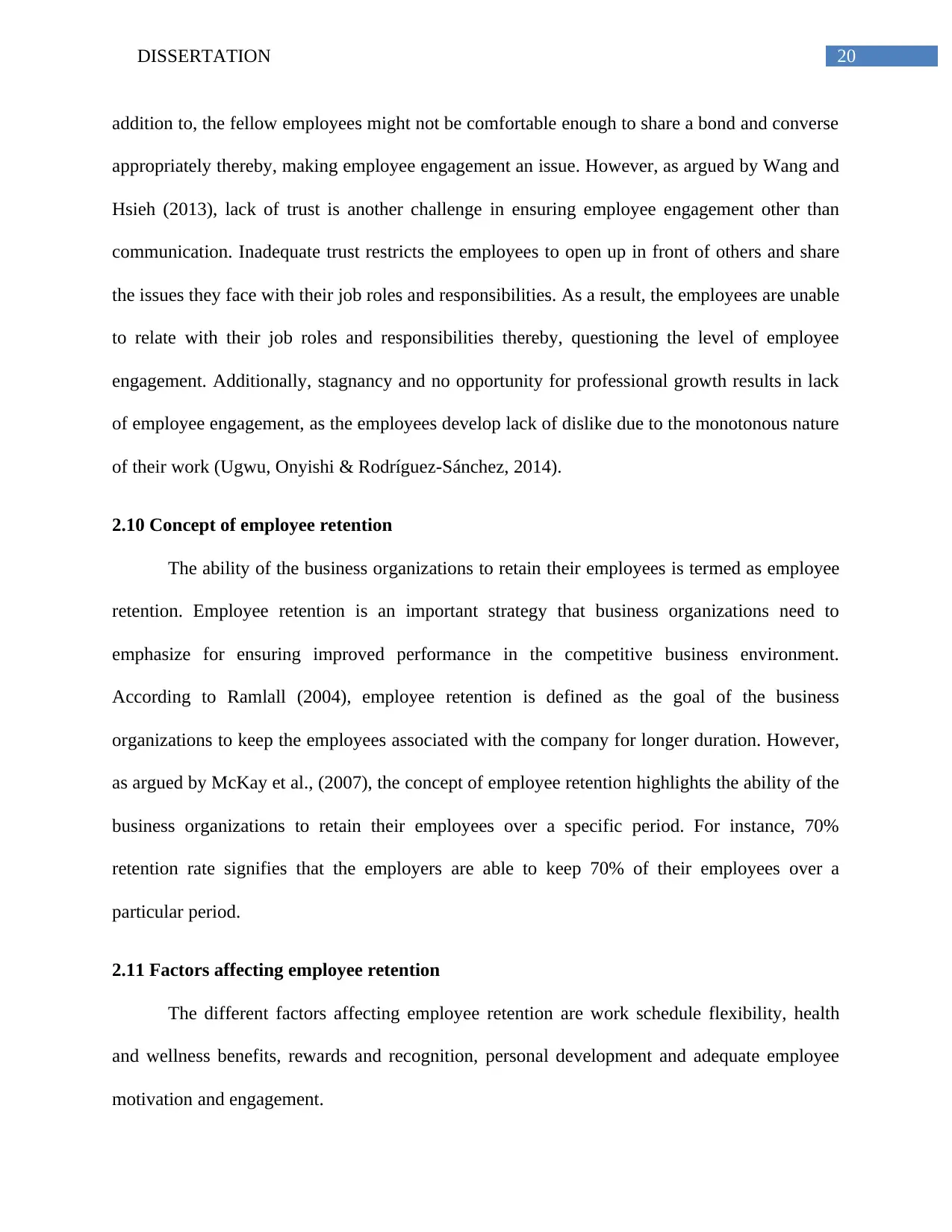
20DISSERTATION
addition to, the fellow employees might not be comfortable enough to share a bond and converse
appropriately thereby, making employee engagement an issue. However, as argued by Wang and
Hsieh (2013), lack of trust is another challenge in ensuring employee engagement other than
communication. Inadequate trust restricts the employees to open up in front of others and share
the issues they face with their job roles and responsibilities. As a result, the employees are unable
to relate with their job roles and responsibilities thereby, questioning the level of employee
engagement. Additionally, stagnancy and no opportunity for professional growth results in lack
of employee engagement, as the employees develop lack of dislike due to the monotonous nature
of their work (Ugwu, Onyishi & Rodríguez-Sánchez, 2014).
2.10 Concept of employee retention
The ability of the business organizations to retain their employees is termed as employee
retention. Employee retention is an important strategy that business organizations need to
emphasize for ensuring improved performance in the competitive business environment.
According to Ramlall (2004), employee retention is defined as the goal of the business
organizations to keep the employees associated with the company for longer duration. However,
as argued by McKay et al., (2007), the concept of employee retention highlights the ability of the
business organizations to retain their employees over a specific period. For instance, 70%
retention rate signifies that the employers are able to keep 70% of their employees over a
particular period.
2.11 Factors affecting employee retention
The different factors affecting employee retention are work schedule flexibility, health
and wellness benefits, rewards and recognition, personal development and adequate employee
motivation and engagement.
addition to, the fellow employees might not be comfortable enough to share a bond and converse
appropriately thereby, making employee engagement an issue. However, as argued by Wang and
Hsieh (2013), lack of trust is another challenge in ensuring employee engagement other than
communication. Inadequate trust restricts the employees to open up in front of others and share
the issues they face with their job roles and responsibilities. As a result, the employees are unable
to relate with their job roles and responsibilities thereby, questioning the level of employee
engagement. Additionally, stagnancy and no opportunity for professional growth results in lack
of employee engagement, as the employees develop lack of dislike due to the monotonous nature
of their work (Ugwu, Onyishi & Rodríguez-Sánchez, 2014).
2.10 Concept of employee retention
The ability of the business organizations to retain their employees is termed as employee
retention. Employee retention is an important strategy that business organizations need to
emphasize for ensuring improved performance in the competitive business environment.
According to Ramlall (2004), employee retention is defined as the goal of the business
organizations to keep the employees associated with the company for longer duration. However,
as argued by McKay et al., (2007), the concept of employee retention highlights the ability of the
business organizations to retain their employees over a specific period. For instance, 70%
retention rate signifies that the employers are able to keep 70% of their employees over a
particular period.
2.11 Factors affecting employee retention
The different factors affecting employee retention are work schedule flexibility, health
and wellness benefits, rewards and recognition, personal development and adequate employee
motivation and engagement.

21DISSERTATION
2.11.1 Work schedule flexibility
According to Richman et al., (2008), today’s employees value flexibility in their working
schedule. This provides an opportunity for the employee according to their convenience and
achieve better and greater results, as they are able to ensure better and improved concentration.
However, as argued by Hausknecht, Rodda and Howard (2009), work schedule flexibility is not
the best option for all the employees, as some of them deliver best under pressure.
2.11.2 Health and wellness benefits
Apart from the other benefits at workplace, group health benefits has become one of the
notable factor that influences employee retention. It has been seen that the business organizations
offer free gym membership for the employees that allows them to be fit while working. Health
and wellness benefits influences employee retention, as the employees feel that the companies
ensure healthy workforce (Noe et al., 2006).
2.11.3 Rewards and recognition
As mentioned by Glen (2006), the employees give their best effort and work hard for
ensuring success for the business organizations. Thus, rewarding and recognizing the effort and
hard work of the employees promotes employee retention, as they feel that the business
organizations value their contribution and hard work. The sense of being significant and
important helps in improved employee retention.
2.11.4 Personal development
According to Kyndt et al., (2009), the employees are easily bored due to the monotonous
nature of their work. Thus, the scope of development for the employees personally provides an
opportunity for the employees to learn more and use that knowledge for career growth and
2.11.1 Work schedule flexibility
According to Richman et al., (2008), today’s employees value flexibility in their working
schedule. This provides an opportunity for the employee according to their convenience and
achieve better and greater results, as they are able to ensure better and improved concentration.
However, as argued by Hausknecht, Rodda and Howard (2009), work schedule flexibility is not
the best option for all the employees, as some of them deliver best under pressure.
2.11.2 Health and wellness benefits
Apart from the other benefits at workplace, group health benefits has become one of the
notable factor that influences employee retention. It has been seen that the business organizations
offer free gym membership for the employees that allows them to be fit while working. Health
and wellness benefits influences employee retention, as the employees feel that the companies
ensure healthy workforce (Noe et al., 2006).
2.11.3 Rewards and recognition
As mentioned by Glen (2006), the employees give their best effort and work hard for
ensuring success for the business organizations. Thus, rewarding and recognizing the effort and
hard work of the employees promotes employee retention, as they feel that the business
organizations value their contribution and hard work. The sense of being significant and
important helps in improved employee retention.
2.11.4 Personal development
According to Kyndt et al., (2009), the employees are easily bored due to the monotonous
nature of their work. Thus, the scope of development for the employees personally provides an
opportunity for the employees to learn more and use that knowledge for career growth and
Secure Best Marks with AI Grader
Need help grading? Try our AI Grader for instant feedback on your assignments.
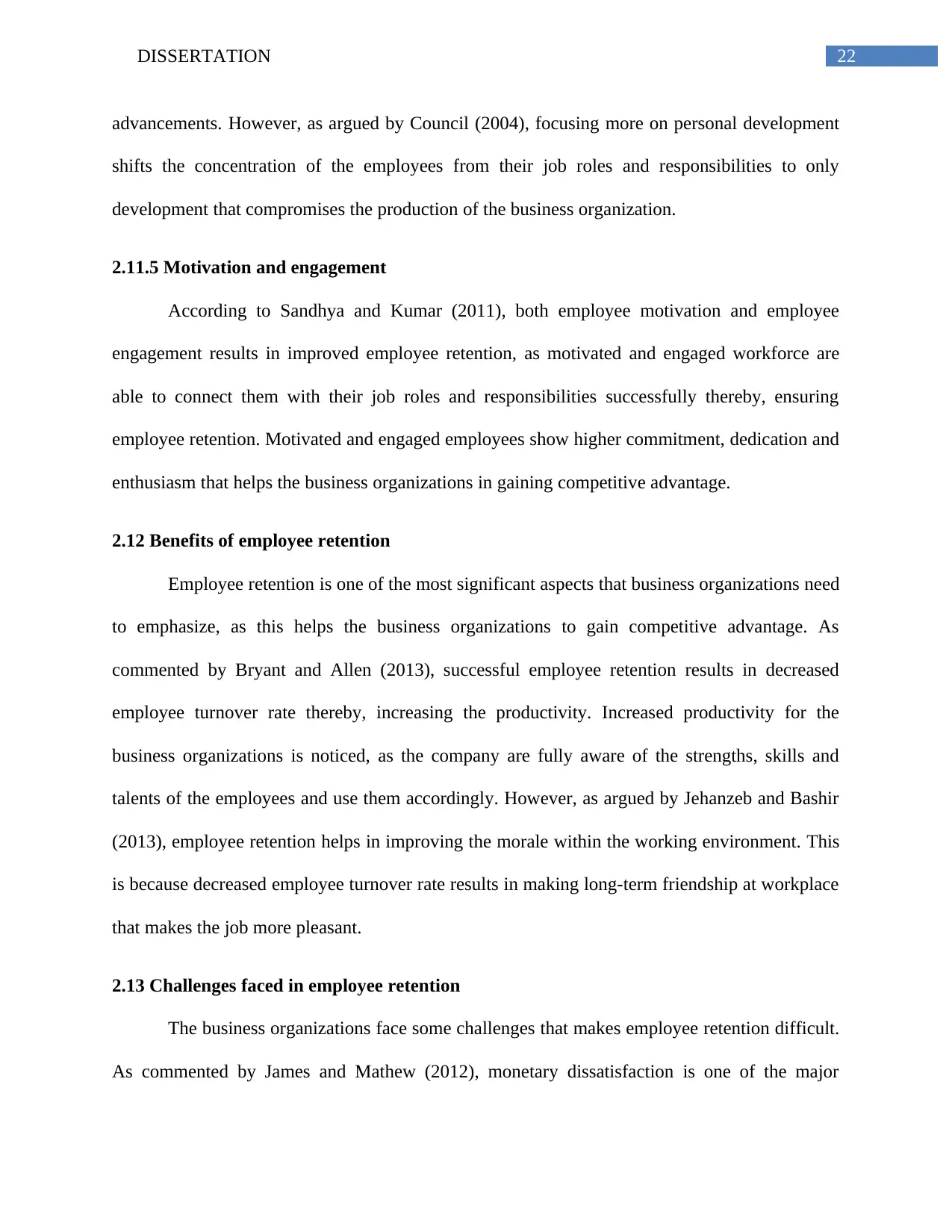
22DISSERTATION
advancements. However, as argued by Council (2004), focusing more on personal development
shifts the concentration of the employees from their job roles and responsibilities to only
development that compromises the production of the business organization.
2.11.5 Motivation and engagement
According to Sandhya and Kumar (2011), both employee motivation and employee
engagement results in improved employee retention, as motivated and engaged workforce are
able to connect them with their job roles and responsibilities successfully thereby, ensuring
employee retention. Motivated and engaged employees show higher commitment, dedication and
enthusiasm that helps the business organizations in gaining competitive advantage.
2.12 Benefits of employee retention
Employee retention is one of the most significant aspects that business organizations need
to emphasize, as this helps the business organizations to gain competitive advantage. As
commented by Bryant and Allen (2013), successful employee retention results in decreased
employee turnover rate thereby, increasing the productivity. Increased productivity for the
business organizations is noticed, as the company are fully aware of the strengths, skills and
talents of the employees and use them accordingly. However, as argued by Jehanzeb and Bashir
(2013), employee retention helps in improving the morale within the working environment. This
is because decreased employee turnover rate results in making long-term friendship at workplace
that makes the job more pleasant.
2.13 Challenges faced in employee retention
The business organizations face some challenges that makes employee retention difficult.
As commented by James and Mathew (2012), monetary dissatisfaction is one of the major
advancements. However, as argued by Council (2004), focusing more on personal development
shifts the concentration of the employees from their job roles and responsibilities to only
development that compromises the production of the business organization.
2.11.5 Motivation and engagement
According to Sandhya and Kumar (2011), both employee motivation and employee
engagement results in improved employee retention, as motivated and engaged workforce are
able to connect them with their job roles and responsibilities successfully thereby, ensuring
employee retention. Motivated and engaged employees show higher commitment, dedication and
enthusiasm that helps the business organizations in gaining competitive advantage.
2.12 Benefits of employee retention
Employee retention is one of the most significant aspects that business organizations need
to emphasize, as this helps the business organizations to gain competitive advantage. As
commented by Bryant and Allen (2013), successful employee retention results in decreased
employee turnover rate thereby, increasing the productivity. Increased productivity for the
business organizations is noticed, as the company are fully aware of the strengths, skills and
talents of the employees and use them accordingly. However, as argued by Jehanzeb and Bashir
(2013), employee retention helps in improving the morale within the working environment. This
is because decreased employee turnover rate results in making long-term friendship at workplace
that makes the job more pleasant.
2.13 Challenges faced in employee retention
The business organizations face some challenges that makes employee retention difficult.
As commented by James and Mathew (2012), monetary dissatisfaction is one of the major
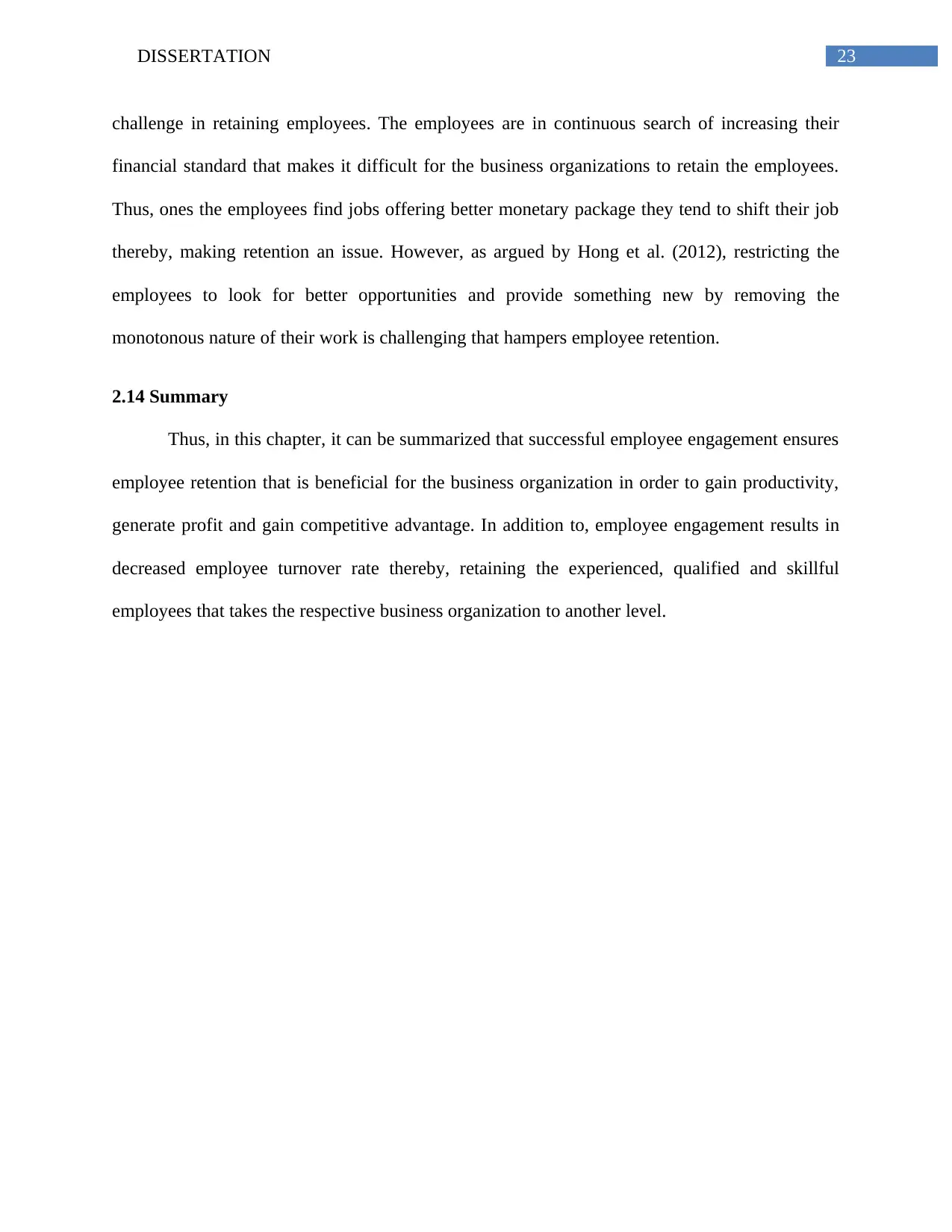
23DISSERTATION
challenge in retaining employees. The employees are in continuous search of increasing their
financial standard that makes it difficult for the business organizations to retain the employees.
Thus, ones the employees find jobs offering better monetary package they tend to shift their job
thereby, making retention an issue. However, as argued by Hong et al. (2012), restricting the
employees to look for better opportunities and provide something new by removing the
monotonous nature of their work is challenging that hampers employee retention.
2.14 Summary
Thus, in this chapter, it can be summarized that successful employee engagement ensures
employee retention that is beneficial for the business organization in order to gain productivity,
generate profit and gain competitive advantage. In addition to, employee engagement results in
decreased employee turnover rate thereby, retaining the experienced, qualified and skillful
employees that takes the respective business organization to another level.
challenge in retaining employees. The employees are in continuous search of increasing their
financial standard that makes it difficult for the business organizations to retain the employees.
Thus, ones the employees find jobs offering better monetary package they tend to shift their job
thereby, making retention an issue. However, as argued by Hong et al. (2012), restricting the
employees to look for better opportunities and provide something new by removing the
monotonous nature of their work is challenging that hampers employee retention.
2.14 Summary
Thus, in this chapter, it can be summarized that successful employee engagement ensures
employee retention that is beneficial for the business organization in order to gain productivity,
generate profit and gain competitive advantage. In addition to, employee engagement results in
decreased employee turnover rate thereby, retaining the experienced, qualified and skillful
employees that takes the respective business organization to another level.
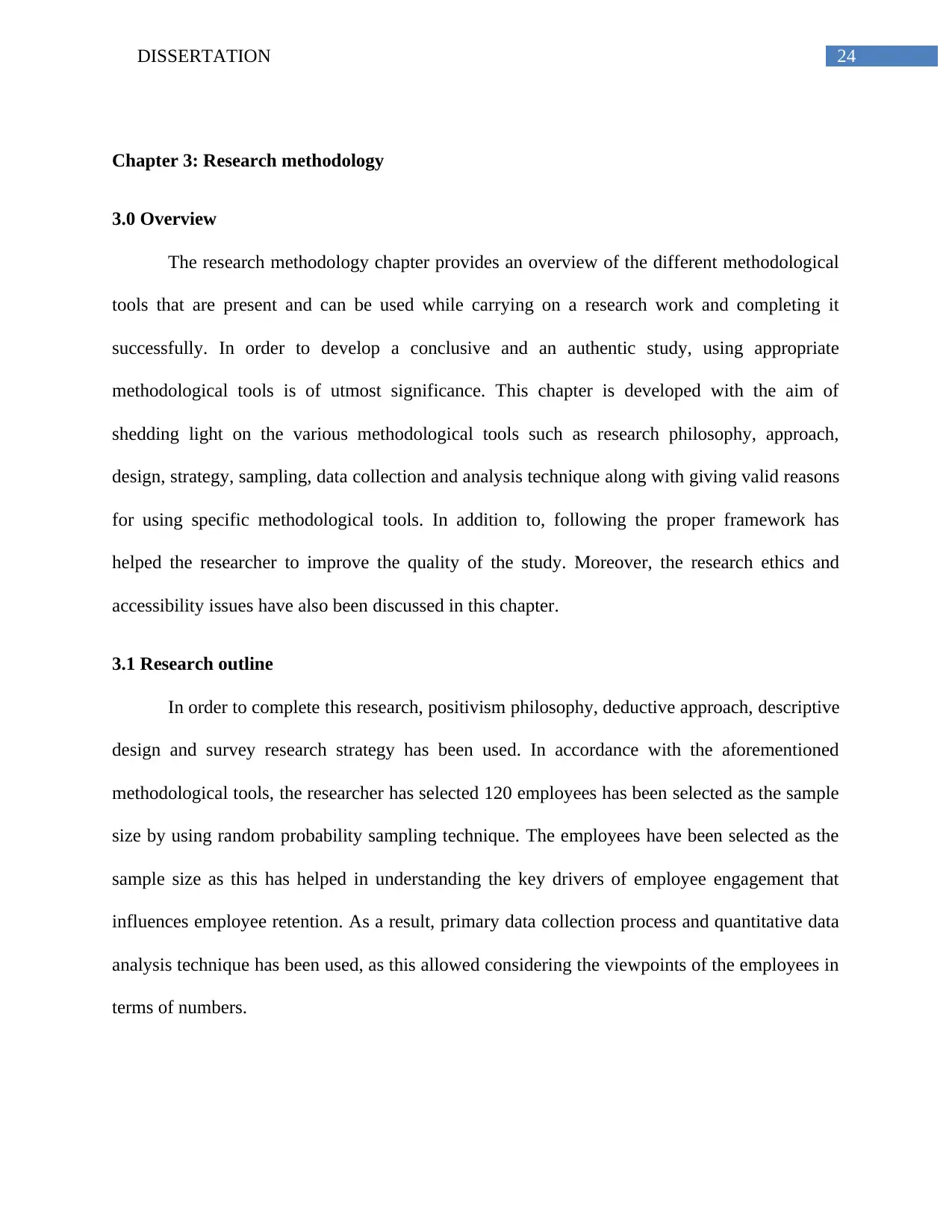
24DISSERTATION
Chapter 3: Research methodology
3.0 Overview
The research methodology chapter provides an overview of the different methodological
tools that are present and can be used while carrying on a research work and completing it
successfully. In order to develop a conclusive and an authentic study, using appropriate
methodological tools is of utmost significance. This chapter is developed with the aim of
shedding light on the various methodological tools such as research philosophy, approach,
design, strategy, sampling, data collection and analysis technique along with giving valid reasons
for using specific methodological tools. In addition to, following the proper framework has
helped the researcher to improve the quality of the study. Moreover, the research ethics and
accessibility issues have also been discussed in this chapter.
3.1 Research outline
In order to complete this research, positivism philosophy, deductive approach, descriptive
design and survey research strategy has been used. In accordance with the aforementioned
methodological tools, the researcher has selected 120 employees has been selected as the sample
size by using random probability sampling technique. The employees have been selected as the
sample size as this has helped in understanding the key drivers of employee engagement that
influences employee retention. As a result, primary data collection process and quantitative data
analysis technique has been used, as this allowed considering the viewpoints of the employees in
terms of numbers.
Chapter 3: Research methodology
3.0 Overview
The research methodology chapter provides an overview of the different methodological
tools that are present and can be used while carrying on a research work and completing it
successfully. In order to develop a conclusive and an authentic study, using appropriate
methodological tools is of utmost significance. This chapter is developed with the aim of
shedding light on the various methodological tools such as research philosophy, approach,
design, strategy, sampling, data collection and analysis technique along with giving valid reasons
for using specific methodological tools. In addition to, following the proper framework has
helped the researcher to improve the quality of the study. Moreover, the research ethics and
accessibility issues have also been discussed in this chapter.
3.1 Research outline
In order to complete this research, positivism philosophy, deductive approach, descriptive
design and survey research strategy has been used. In accordance with the aforementioned
methodological tools, the researcher has selected 120 employees has been selected as the sample
size by using random probability sampling technique. The employees have been selected as the
sample size as this has helped in understanding the key drivers of employee engagement that
influences employee retention. As a result, primary data collection process and quantitative data
analysis technique has been used, as this allowed considering the viewpoints of the employees in
terms of numbers.
Paraphrase This Document
Need a fresh take? Get an instant paraphrase of this document with our AI Paraphraser
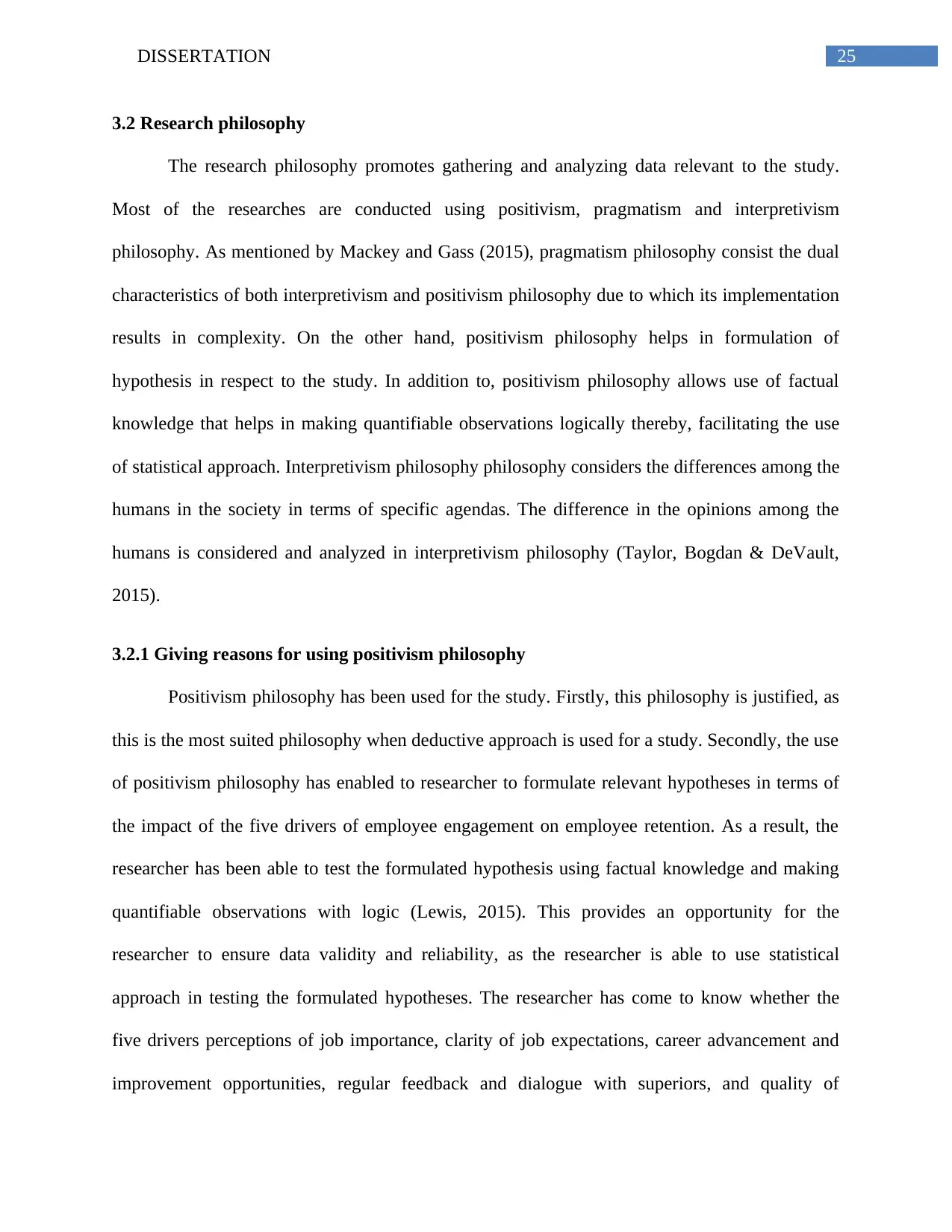
25DISSERTATION
3.2 Research philosophy
The research philosophy promotes gathering and analyzing data relevant to the study.
Most of the researches are conducted using positivism, pragmatism and interpretivism
philosophy. As mentioned by Mackey and Gass (2015), pragmatism philosophy consist the dual
characteristics of both interpretivism and positivism philosophy due to which its implementation
results in complexity. On the other hand, positivism philosophy helps in formulation of
hypothesis in respect to the study. In addition to, positivism philosophy allows use of factual
knowledge that helps in making quantifiable observations logically thereby, facilitating the use
of statistical approach. Interpretivism philosophy philosophy considers the differences among the
humans in the society in terms of specific agendas. The difference in the opinions among the
humans is considered and analyzed in interpretivism philosophy (Taylor, Bogdan & DeVault,
2015).
3.2.1 Giving reasons for using positivism philosophy
Positivism philosophy has been used for the study. Firstly, this philosophy is justified, as
this is the most suited philosophy when deductive approach is used for a study. Secondly, the use
of positivism philosophy has enabled to researcher to formulate relevant hypotheses in terms of
the impact of the five drivers of employee engagement on employee retention. As a result, the
researcher has been able to test the formulated hypothesis using factual knowledge and making
quantifiable observations with logic (Lewis, 2015). This provides an opportunity for the
researcher to ensure data validity and reliability, as the researcher is able to use statistical
approach in testing the formulated hypotheses. The researcher has come to know whether the
five drivers perceptions of job importance, clarity of job expectations, career advancement and
improvement opportunities, regular feedback and dialogue with superiors, and quality of
3.2 Research philosophy
The research philosophy promotes gathering and analyzing data relevant to the study.
Most of the researches are conducted using positivism, pragmatism and interpretivism
philosophy. As mentioned by Mackey and Gass (2015), pragmatism philosophy consist the dual
characteristics of both interpretivism and positivism philosophy due to which its implementation
results in complexity. On the other hand, positivism philosophy helps in formulation of
hypothesis in respect to the study. In addition to, positivism philosophy allows use of factual
knowledge that helps in making quantifiable observations logically thereby, facilitating the use
of statistical approach. Interpretivism philosophy philosophy considers the differences among the
humans in the society in terms of specific agendas. The difference in the opinions among the
humans is considered and analyzed in interpretivism philosophy (Taylor, Bogdan & DeVault,
2015).
3.2.1 Giving reasons for using positivism philosophy
Positivism philosophy has been used for the study. Firstly, this philosophy is justified, as
this is the most suited philosophy when deductive approach is used for a study. Secondly, the use
of positivism philosophy has enabled to researcher to formulate relevant hypotheses in terms of
the impact of the five drivers of employee engagement on employee retention. As a result, the
researcher has been able to test the formulated hypothesis using factual knowledge and making
quantifiable observations with logic (Lewis, 2015). This provides an opportunity for the
researcher to ensure data validity and reliability, as the researcher is able to use statistical
approach in testing the formulated hypotheses. The researcher has come to know whether the
five drivers perceptions of job importance, clarity of job expectations, career advancement and
improvement opportunities, regular feedback and dialogue with superiors, and quality of

26DISSERTATION
working relationships with peers, superiors and subordinates plays a significant role in ensuring
employee retention (Vaioleti, 2016).
3.3 Research approach
Two types of research approaches are used while conducting a research. Inductive and
deductive are the most widely used approaches while conducting research. As mentioned by
Silverman (2016), the idea of inductive approach promotes developing new theories and models
based on the observations made by the research. Inductive approach is time-consuming as well
as error prone. This is because incorrect observations lead to the development of incorrect
theories and models that hinders the successful completion of the research. On the other hand,
deductive approach is based on making observations by referring to already existing theories and
models. As a result, the researcher in this case is able to refer to past theories that have already
been tested and make suitable observations. This is time effective and not error prone, as the
theories and models are already formulated and tested (Flick, 2015).
3.3.1 Giving reasons for using deductive approach
Deductive approach has been used for the study. Firstly, the use of deductive approach is
most suited because positivism philosophy has been used. Secondly, this approach is justified
because the use of this approach provides an opportunity for the researcher to refer to different
concepts, theories and models of employee engagement, employee retention and the five drivers
of employee engagement (Smith, 2015). Referring to relevant information enables the researcher
to analyze critically each of the drivers of employee engagement and determine the factor that
has the maximum influence in retaining employees. In addition to, the use of deductive approach
allowed the researcher to refer to past theories and models of employee retention and employee
engagement thereby, providing an in-depth knowledge and understanding about the identified
working relationships with peers, superiors and subordinates plays a significant role in ensuring
employee retention (Vaioleti, 2016).
3.3 Research approach
Two types of research approaches are used while conducting a research. Inductive and
deductive are the most widely used approaches while conducting research. As mentioned by
Silverman (2016), the idea of inductive approach promotes developing new theories and models
based on the observations made by the research. Inductive approach is time-consuming as well
as error prone. This is because incorrect observations lead to the development of incorrect
theories and models that hinders the successful completion of the research. On the other hand,
deductive approach is based on making observations by referring to already existing theories and
models. As a result, the researcher in this case is able to refer to past theories that have already
been tested and make suitable observations. This is time effective and not error prone, as the
theories and models are already formulated and tested (Flick, 2015).
3.3.1 Giving reasons for using deductive approach
Deductive approach has been used for the study. Firstly, the use of deductive approach is
most suited because positivism philosophy has been used. Secondly, this approach is justified
because the use of this approach provides an opportunity for the researcher to refer to different
concepts, theories and models of employee engagement, employee retention and the five drivers
of employee engagement (Smith, 2015). Referring to relevant information enables the researcher
to analyze critically each of the drivers of employee engagement and determine the factor that
has the maximum influence in retaining employees. In addition to, the use of deductive approach
allowed the researcher to refer to past theories and models of employee retention and employee
engagement thereby, providing an in-depth knowledge and understanding about the identified
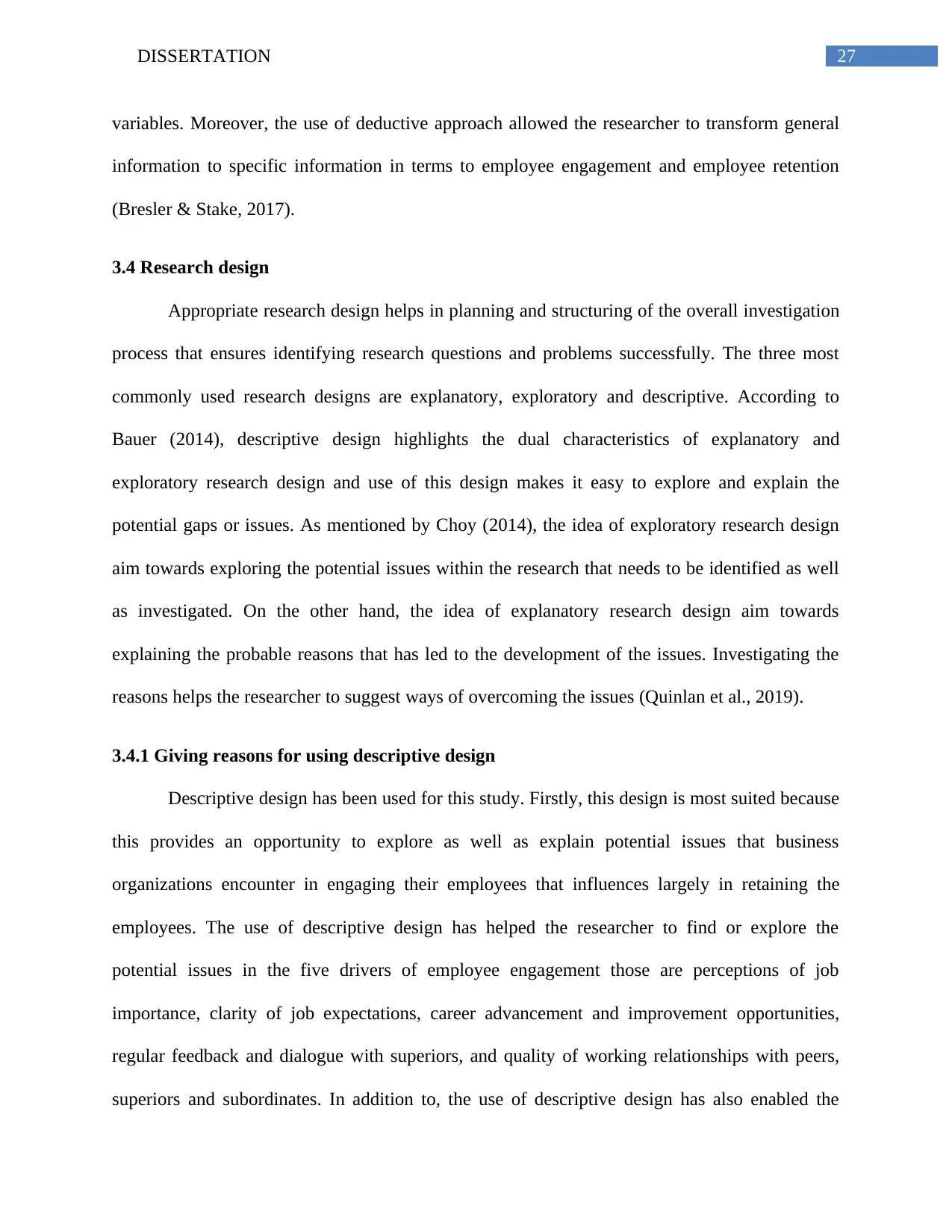
27DISSERTATION
variables. Moreover, the use of deductive approach allowed the researcher to transform general
information to specific information in terms to employee engagement and employee retention
(Bresler & Stake, 2017).
3.4 Research design
Appropriate research design helps in planning and structuring of the overall investigation
process that ensures identifying research questions and problems successfully. The three most
commonly used research designs are explanatory, exploratory and descriptive. According to
Bauer (2014), descriptive design highlights the dual characteristics of explanatory and
exploratory research design and use of this design makes it easy to explore and explain the
potential gaps or issues. As mentioned by Choy (2014), the idea of exploratory research design
aim towards exploring the potential issues within the research that needs to be identified as well
as investigated. On the other hand, the idea of explanatory research design aim towards
explaining the probable reasons that has led to the development of the issues. Investigating the
reasons helps the researcher to suggest ways of overcoming the issues (Quinlan et al., 2019).
3.4.1 Giving reasons for using descriptive design
Descriptive design has been used for this study. Firstly, this design is most suited because
this provides an opportunity to explore as well as explain potential issues that business
organizations encounter in engaging their employees that influences largely in retaining the
employees. The use of descriptive design has helped the researcher to find or explore the
potential issues in the five drivers of employee engagement those are perceptions of job
importance, clarity of job expectations, career advancement and improvement opportunities,
regular feedback and dialogue with superiors, and quality of working relationships with peers,
superiors and subordinates. In addition to, the use of descriptive design has also enabled the
variables. Moreover, the use of deductive approach allowed the researcher to transform general
information to specific information in terms to employee engagement and employee retention
(Bresler & Stake, 2017).
3.4 Research design
Appropriate research design helps in planning and structuring of the overall investigation
process that ensures identifying research questions and problems successfully. The three most
commonly used research designs are explanatory, exploratory and descriptive. According to
Bauer (2014), descriptive design highlights the dual characteristics of explanatory and
exploratory research design and use of this design makes it easy to explore and explain the
potential gaps or issues. As mentioned by Choy (2014), the idea of exploratory research design
aim towards exploring the potential issues within the research that needs to be identified as well
as investigated. On the other hand, the idea of explanatory research design aim towards
explaining the probable reasons that has led to the development of the issues. Investigating the
reasons helps the researcher to suggest ways of overcoming the issues (Quinlan et al., 2019).
3.4.1 Giving reasons for using descriptive design
Descriptive design has been used for this study. Firstly, this design is most suited because
this provides an opportunity to explore as well as explain potential issues that business
organizations encounter in engaging their employees that influences largely in retaining the
employees. The use of descriptive design has helped the researcher to find or explore the
potential issues in the five drivers of employee engagement those are perceptions of job
importance, clarity of job expectations, career advancement and improvement opportunities,
regular feedback and dialogue with superiors, and quality of working relationships with peers,
superiors and subordinates. In addition to, the use of descriptive design has also enabled the
Secure Best Marks with AI Grader
Need help grading? Try our AI Grader for instant feedback on your assignments.

28DISSERTATION
researcher to investigate the reasons that has led to issues among the five drivers of employee
engagement thereby, hampering the employee retention abilities for the business organizations
(Jamshed, 2014). As descriptive design has the dual characteristics of explanatory and
exploratory research design, using this design minimizes the complexity of using explanatory
and exploratory design separately.
3.5 Research strategy
Research strategy provides an action plan for the researcher that can be used for
completing the research successfully. The four main types of research strategies are action
research, case study, interview and survey. As mentioned by Humphries (2017), case study
research strategy signifies referring to case studies that is relevant to the selected research topic
and act as a valuable source of data and information. On the other hand, action research strategy
enables the researcher to produce results in a manner that it is valuable to the people for whom
the research is being conducted. The use of action research strategy aims towards building
theoretical knowledge thereby, offering required solution to the participants.
As opined by Dang and Pheng (2015), survey research strategy facilitates the researcher
to collect data based on the particular situation by using questionnaires and interviews. As a
result, the researcher is able to deduce inferences about the data by analyzing the existing
relationships. Use of survey research strategy helps the researcher to study more than one
variable at a single time. On the other hand, interview signifies personal communication between
the researcher and the participant and considers viewpoint and opinions regarding the research
topic from the participant.
researcher to investigate the reasons that has led to issues among the five drivers of employee
engagement thereby, hampering the employee retention abilities for the business organizations
(Jamshed, 2014). As descriptive design has the dual characteristics of explanatory and
exploratory research design, using this design minimizes the complexity of using explanatory
and exploratory design separately.
3.5 Research strategy
Research strategy provides an action plan for the researcher that can be used for
completing the research successfully. The four main types of research strategies are action
research, case study, interview and survey. As mentioned by Humphries (2017), case study
research strategy signifies referring to case studies that is relevant to the selected research topic
and act as a valuable source of data and information. On the other hand, action research strategy
enables the researcher to produce results in a manner that it is valuable to the people for whom
the research is being conducted. The use of action research strategy aims towards building
theoretical knowledge thereby, offering required solution to the participants.
As opined by Dang and Pheng (2015), survey research strategy facilitates the researcher
to collect data based on the particular situation by using questionnaires and interviews. As a
result, the researcher is able to deduce inferences about the data by analyzing the existing
relationships. Use of survey research strategy helps the researcher to study more than one
variable at a single time. On the other hand, interview signifies personal communication between
the researcher and the participant and considers viewpoint and opinions regarding the research
topic from the participant.
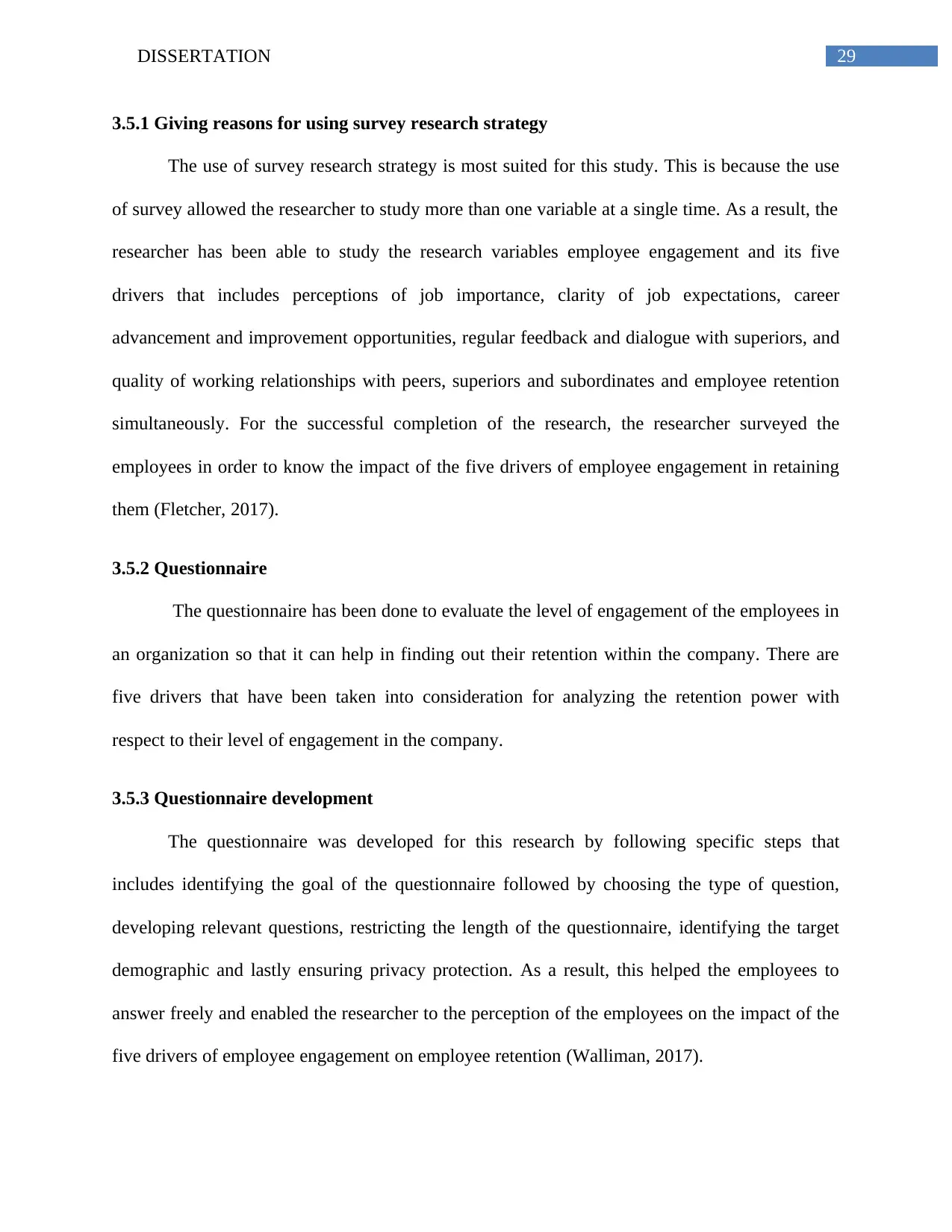
29DISSERTATION
3.5.1 Giving reasons for using survey research strategy
The use of survey research strategy is most suited for this study. This is because the use
of survey allowed the researcher to study more than one variable at a single time. As a result, the
researcher has been able to study the research variables employee engagement and its five
drivers that includes perceptions of job importance, clarity of job expectations, career
advancement and improvement opportunities, regular feedback and dialogue with superiors, and
quality of working relationships with peers, superiors and subordinates and employee retention
simultaneously. For the successful completion of the research, the researcher surveyed the
employees in order to know the impact of the five drivers of employee engagement in retaining
them (Fletcher, 2017).
3.5.2 Questionnaire
The questionnaire has been done to evaluate the level of engagement of the employees in
an organization so that it can help in finding out their retention within the company. There are
five drivers that have been taken into consideration for analyzing the retention power with
respect to their level of engagement in the company.
3.5.3 Questionnaire development
The questionnaire was developed for this research by following specific steps that
includes identifying the goal of the questionnaire followed by choosing the type of question,
developing relevant questions, restricting the length of the questionnaire, identifying the target
demographic and lastly ensuring privacy protection. As a result, this helped the employees to
answer freely and enabled the researcher to the perception of the employees on the impact of the
five drivers of employee engagement on employee retention (Walliman, 2017).
3.5.1 Giving reasons for using survey research strategy
The use of survey research strategy is most suited for this study. This is because the use
of survey allowed the researcher to study more than one variable at a single time. As a result, the
researcher has been able to study the research variables employee engagement and its five
drivers that includes perceptions of job importance, clarity of job expectations, career
advancement and improvement opportunities, regular feedback and dialogue with superiors, and
quality of working relationships with peers, superiors and subordinates and employee retention
simultaneously. For the successful completion of the research, the researcher surveyed the
employees in order to know the impact of the five drivers of employee engagement in retaining
them (Fletcher, 2017).
3.5.2 Questionnaire
The questionnaire has been done to evaluate the level of engagement of the employees in
an organization so that it can help in finding out their retention within the company. There are
five drivers that have been taken into consideration for analyzing the retention power with
respect to their level of engagement in the company.
3.5.3 Questionnaire development
The questionnaire was developed for this research by following specific steps that
includes identifying the goal of the questionnaire followed by choosing the type of question,
developing relevant questions, restricting the length of the questionnaire, identifying the target
demographic and lastly ensuring privacy protection. As a result, this helped the employees to
answer freely and enabled the researcher to the perception of the employees on the impact of the
five drivers of employee engagement on employee retention (Walliman, 2017).
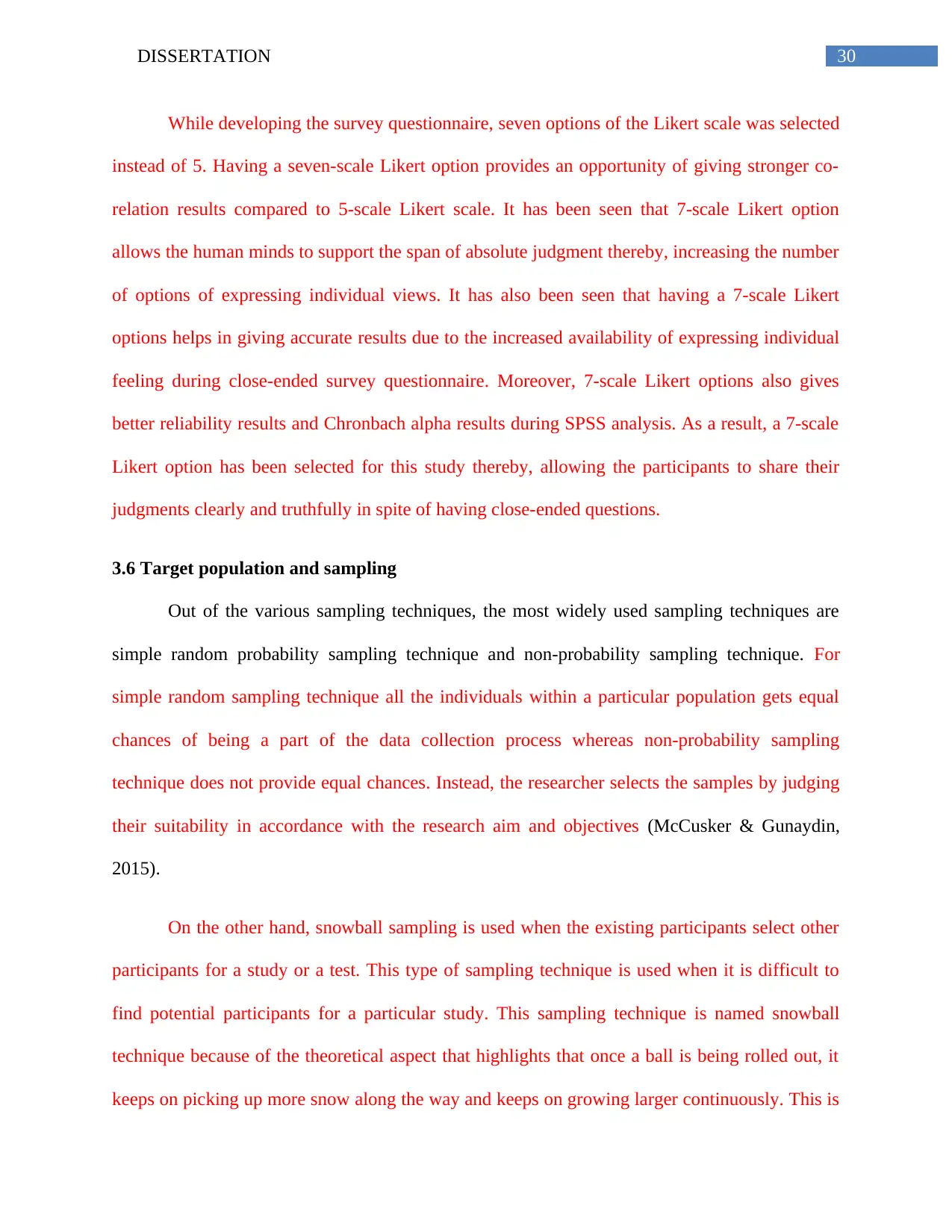
30DISSERTATION
While developing the survey questionnaire, seven options of the Likert scale was selected
instead of 5. Having a seven-scale Likert option provides an opportunity of giving stronger co-
relation results compared to 5-scale Likert scale. It has been seen that 7-scale Likert option
allows the human minds to support the span of absolute judgment thereby, increasing the number
of options of expressing individual views. It has also been seen that having a 7-scale Likert
options helps in giving accurate results due to the increased availability of expressing individual
feeling during close-ended survey questionnaire. Moreover, 7-scale Likert options also gives
better reliability results and Chronbach alpha results during SPSS analysis. As a result, a 7-scale
Likert option has been selected for this study thereby, allowing the participants to share their
judgments clearly and truthfully in spite of having close-ended questions.
3.6 Target population and sampling
Out of the various sampling techniques, the most widely used sampling techniques are
simple random probability sampling technique and non-probability sampling technique. For
simple random sampling technique all the individuals within a particular population gets equal
chances of being a part of the data collection process whereas non-probability sampling
technique does not provide equal chances. Instead, the researcher selects the samples by judging
their suitability in accordance with the research aim and objectives (McCusker & Gunaydin,
2015).
On the other hand, snowball sampling is used when the existing participants select other
participants for a study or a test. This type of sampling technique is used when it is difficult to
find potential participants for a particular study. This sampling technique is named snowball
technique because of the theoretical aspect that highlights that once a ball is being rolled out, it
keeps on picking up more snow along the way and keeps on growing larger continuously. This is
While developing the survey questionnaire, seven options of the Likert scale was selected
instead of 5. Having a seven-scale Likert option provides an opportunity of giving stronger co-
relation results compared to 5-scale Likert scale. It has been seen that 7-scale Likert option
allows the human minds to support the span of absolute judgment thereby, increasing the number
of options of expressing individual views. It has also been seen that having a 7-scale Likert
options helps in giving accurate results due to the increased availability of expressing individual
feeling during close-ended survey questionnaire. Moreover, 7-scale Likert options also gives
better reliability results and Chronbach alpha results during SPSS analysis. As a result, a 7-scale
Likert option has been selected for this study thereby, allowing the participants to share their
judgments clearly and truthfully in spite of having close-ended questions.
3.6 Target population and sampling
Out of the various sampling techniques, the most widely used sampling techniques are
simple random probability sampling technique and non-probability sampling technique. For
simple random sampling technique all the individuals within a particular population gets equal
chances of being a part of the data collection process whereas non-probability sampling
technique does not provide equal chances. Instead, the researcher selects the samples by judging
their suitability in accordance with the research aim and objectives (McCusker & Gunaydin,
2015).
On the other hand, snowball sampling is used when the existing participants select other
participants for a study or a test. This type of sampling technique is used when it is difficult to
find potential participants for a particular study. This sampling technique is named snowball
technique because of the theoretical aspect that highlights that once a ball is being rolled out, it
keeps on picking up more snow along the way and keeps on growing larger continuously. This is
Paraphrase This Document
Need a fresh take? Get an instant paraphrase of this document with our AI Paraphraser
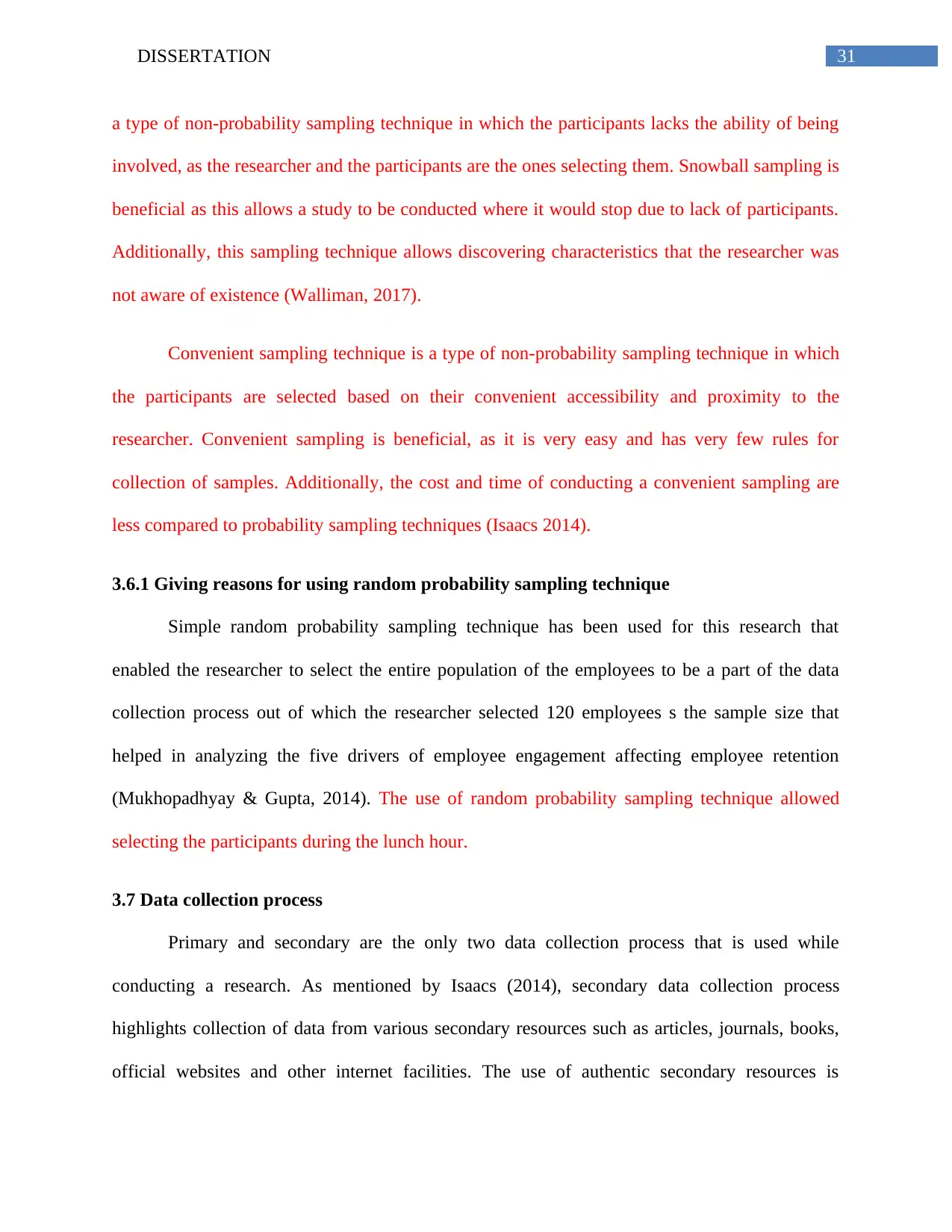
31DISSERTATION
a type of non-probability sampling technique in which the participants lacks the ability of being
involved, as the researcher and the participants are the ones selecting them. Snowball sampling is
beneficial as this allows a study to be conducted where it would stop due to lack of participants.
Additionally, this sampling technique allows discovering characteristics that the researcher was
not aware of existence (Walliman, 2017).
Convenient sampling technique is a type of non-probability sampling technique in which
the participants are selected based on their convenient accessibility and proximity to the
researcher. Convenient sampling is beneficial, as it is very easy and has very few rules for
collection of samples. Additionally, the cost and time of conducting a convenient sampling are
less compared to probability sampling techniques (Isaacs 2014).
3.6.1 Giving reasons for using random probability sampling technique
Simple random probability sampling technique has been used for this research that
enabled the researcher to select the entire population of the employees to be a part of the data
collection process out of which the researcher selected 120 employees s the sample size that
helped in analyzing the five drivers of employee engagement affecting employee retention
(Mukhopadhyay & Gupta, 2014). The use of random probability sampling technique allowed
selecting the participants during the lunch hour.
3.7 Data collection process
Primary and secondary are the only two data collection process that is used while
conducting a research. As mentioned by Isaacs (2014), secondary data collection process
highlights collection of data from various secondary resources such as articles, journals, books,
official websites and other internet facilities. The use of authentic secondary resources is
a type of non-probability sampling technique in which the participants lacks the ability of being
involved, as the researcher and the participants are the ones selecting them. Snowball sampling is
beneficial as this allows a study to be conducted where it would stop due to lack of participants.
Additionally, this sampling technique allows discovering characteristics that the researcher was
not aware of existence (Walliman, 2017).
Convenient sampling technique is a type of non-probability sampling technique in which
the participants are selected based on their convenient accessibility and proximity to the
researcher. Convenient sampling is beneficial, as it is very easy and has very few rules for
collection of samples. Additionally, the cost and time of conducting a convenient sampling are
less compared to probability sampling techniques (Isaacs 2014).
3.6.1 Giving reasons for using random probability sampling technique
Simple random probability sampling technique has been used for this research that
enabled the researcher to select the entire population of the employees to be a part of the data
collection process out of which the researcher selected 120 employees s the sample size that
helped in analyzing the five drivers of employee engagement affecting employee retention
(Mukhopadhyay & Gupta, 2014). The use of random probability sampling technique allowed
selecting the participants during the lunch hour.
3.7 Data collection process
Primary and secondary are the only two data collection process that is used while
conducting a research. As mentioned by Isaacs (2014), secondary data collection process
highlights collection of data from various secondary resources such as articles, journals, books,
official websites and other internet facilities. The use of authentic secondary resources is
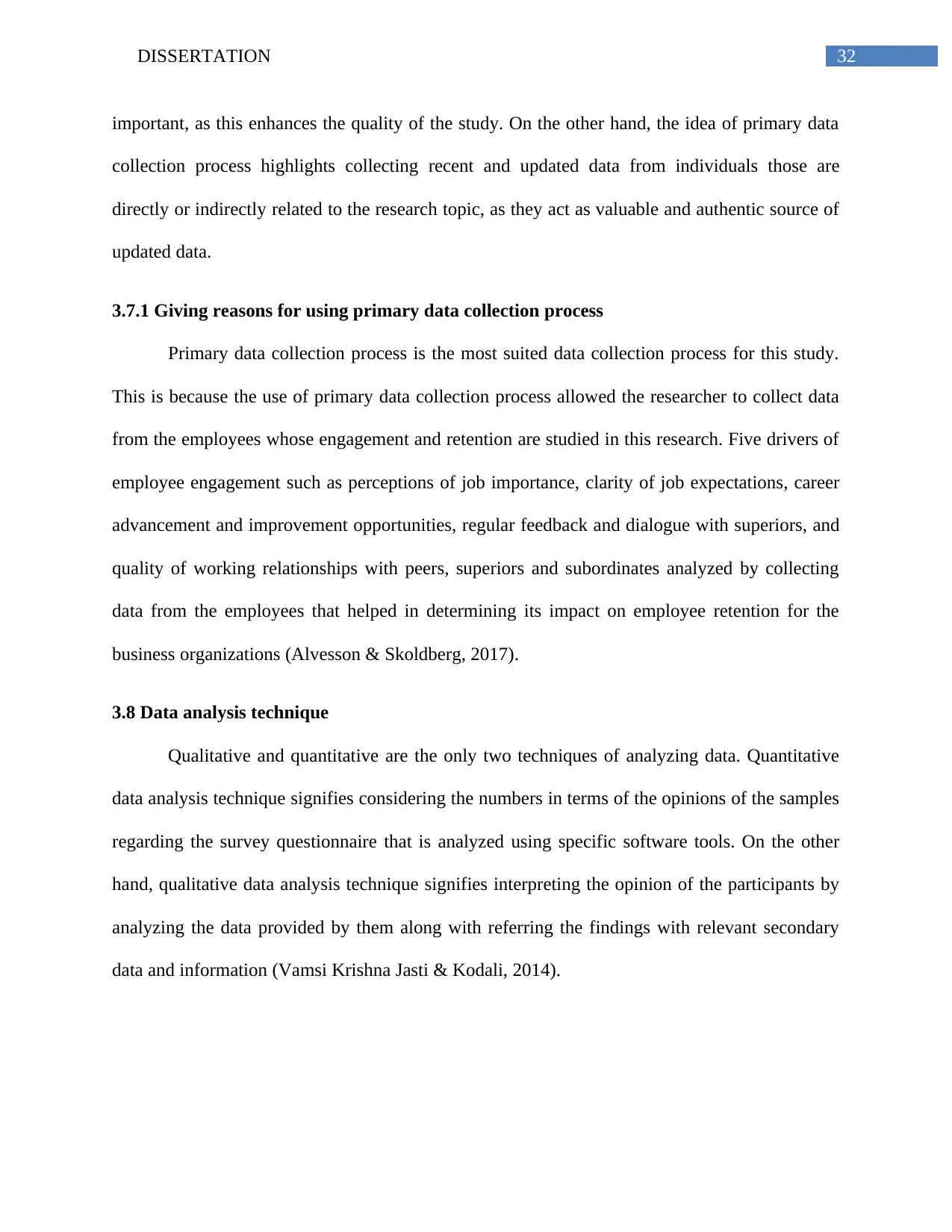
32DISSERTATION
important, as this enhances the quality of the study. On the other hand, the idea of primary data
collection process highlights collecting recent and updated data from individuals those are
directly or indirectly related to the research topic, as they act as valuable and authentic source of
updated data.
3.7.1 Giving reasons for using primary data collection process
Primary data collection process is the most suited data collection process for this study.
This is because the use of primary data collection process allowed the researcher to collect data
from the employees whose engagement and retention are studied in this research. Five drivers of
employee engagement such as perceptions of job importance, clarity of job expectations, career
advancement and improvement opportunities, regular feedback and dialogue with superiors, and
quality of working relationships with peers, superiors and subordinates analyzed by collecting
data from the employees that helped in determining its impact on employee retention for the
business organizations (Alvesson & Skoldberg, 2017).
3.8 Data analysis technique
Qualitative and quantitative are the only two techniques of analyzing data. Quantitative
data analysis technique signifies considering the numbers in terms of the opinions of the samples
regarding the survey questionnaire that is analyzed using specific software tools. On the other
hand, qualitative data analysis technique signifies interpreting the opinion of the participants by
analyzing the data provided by them along with referring the findings with relevant secondary
data and information (Vamsi Krishna Jasti & Kodali, 2014).
important, as this enhances the quality of the study. On the other hand, the idea of primary data
collection process highlights collecting recent and updated data from individuals those are
directly or indirectly related to the research topic, as they act as valuable and authentic source of
updated data.
3.7.1 Giving reasons for using primary data collection process
Primary data collection process is the most suited data collection process for this study.
This is because the use of primary data collection process allowed the researcher to collect data
from the employees whose engagement and retention are studied in this research. Five drivers of
employee engagement such as perceptions of job importance, clarity of job expectations, career
advancement and improvement opportunities, regular feedback and dialogue with superiors, and
quality of working relationships with peers, superiors and subordinates analyzed by collecting
data from the employees that helped in determining its impact on employee retention for the
business organizations (Alvesson & Skoldberg, 2017).
3.8 Data analysis technique
Qualitative and quantitative are the only two techniques of analyzing data. Quantitative
data analysis technique signifies considering the numbers in terms of the opinions of the samples
regarding the survey questionnaire that is analyzed using specific software tools. On the other
hand, qualitative data analysis technique signifies interpreting the opinion of the participants by
analyzing the data provided by them along with referring the findings with relevant secondary
data and information (Vamsi Krishna Jasti & Kodali, 2014).
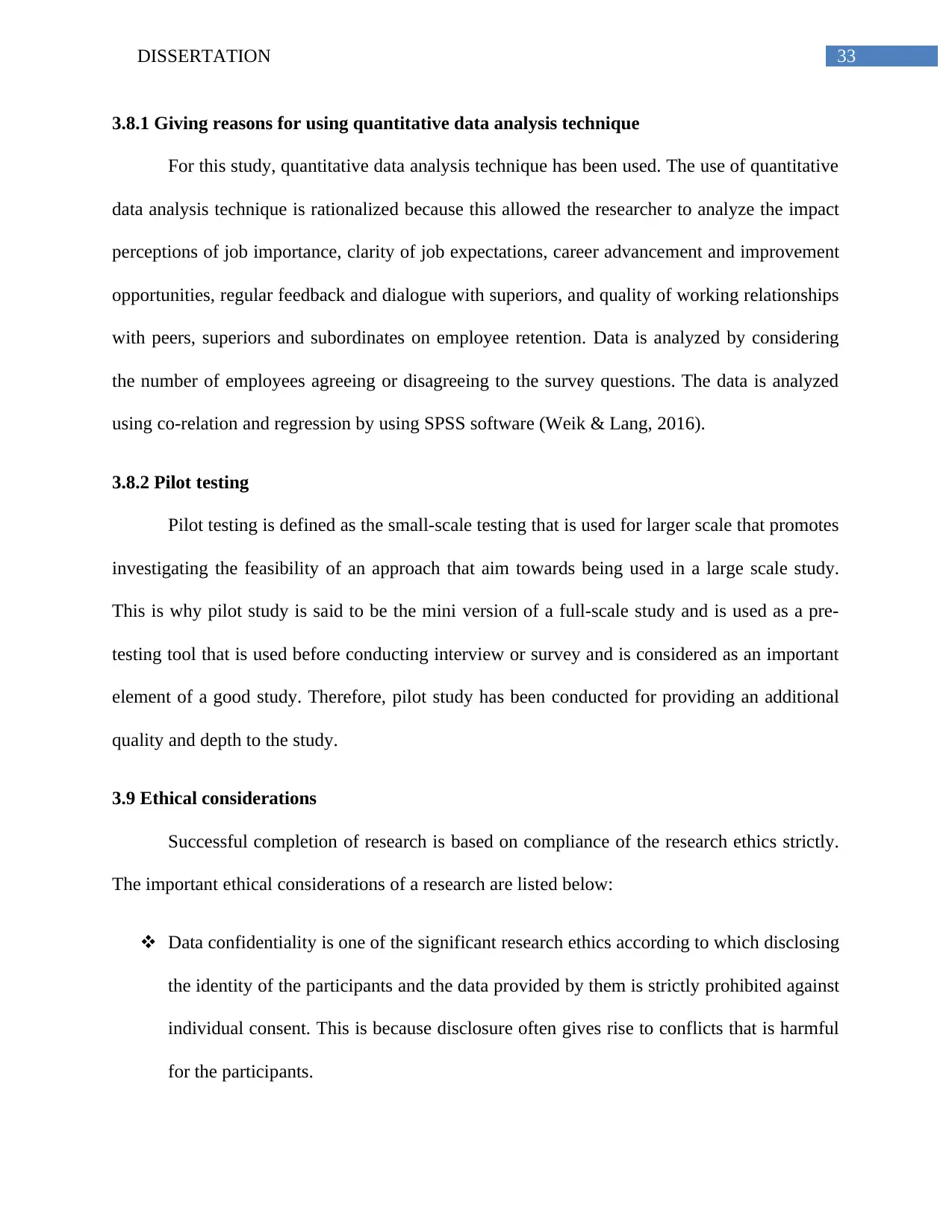
33DISSERTATION
3.8.1 Giving reasons for using quantitative data analysis technique
For this study, quantitative data analysis technique has been used. The use of quantitative
data analysis technique is rationalized because this allowed the researcher to analyze the impact
perceptions of job importance, clarity of job expectations, career advancement and improvement
opportunities, regular feedback and dialogue with superiors, and quality of working relationships
with peers, superiors and subordinates on employee retention. Data is analyzed by considering
the number of employees agreeing or disagreeing to the survey questions. The data is analyzed
using co-relation and regression by using SPSS software (Weik & Lang, 2016).
3.8.2 Pilot testing
Pilot testing is defined as the small-scale testing that is used for larger scale that promotes
investigating the feasibility of an approach that aim towards being used in a large scale study.
This is why pilot study is said to be the mini version of a full-scale study and is used as a pre-
testing tool that is used before conducting interview or survey and is considered as an important
element of a good study. Therefore, pilot study has been conducted for providing an additional
quality and depth to the study.
3.9 Ethical considerations
Successful completion of research is based on compliance of the research ethics strictly.
The important ethical considerations of a research are listed below:
Data confidentiality is one of the significant research ethics according to which disclosing
the identity of the participants and the data provided by them is strictly prohibited against
individual consent. This is because disclosure often gives rise to conflicts that is harmful
for the participants.
3.8.1 Giving reasons for using quantitative data analysis technique
For this study, quantitative data analysis technique has been used. The use of quantitative
data analysis technique is rationalized because this allowed the researcher to analyze the impact
perceptions of job importance, clarity of job expectations, career advancement and improvement
opportunities, regular feedback and dialogue with superiors, and quality of working relationships
with peers, superiors and subordinates on employee retention. Data is analyzed by considering
the number of employees agreeing or disagreeing to the survey questions. The data is analyzed
using co-relation and regression by using SPSS software (Weik & Lang, 2016).
3.8.2 Pilot testing
Pilot testing is defined as the small-scale testing that is used for larger scale that promotes
investigating the feasibility of an approach that aim towards being used in a large scale study.
This is why pilot study is said to be the mini version of a full-scale study and is used as a pre-
testing tool that is used before conducting interview or survey and is considered as an important
element of a good study. Therefore, pilot study has been conducted for providing an additional
quality and depth to the study.
3.9 Ethical considerations
Successful completion of research is based on compliance of the research ethics strictly.
The important ethical considerations of a research are listed below:
Data confidentiality is one of the significant research ethics according to which disclosing
the identity of the participants and the data provided by them is strictly prohibited against
individual consent. This is because disclosure often gives rise to conflicts that is harmful
for the participants.
Secure Best Marks with AI Grader
Need help grading? Try our AI Grader for instant feedback on your assignments.
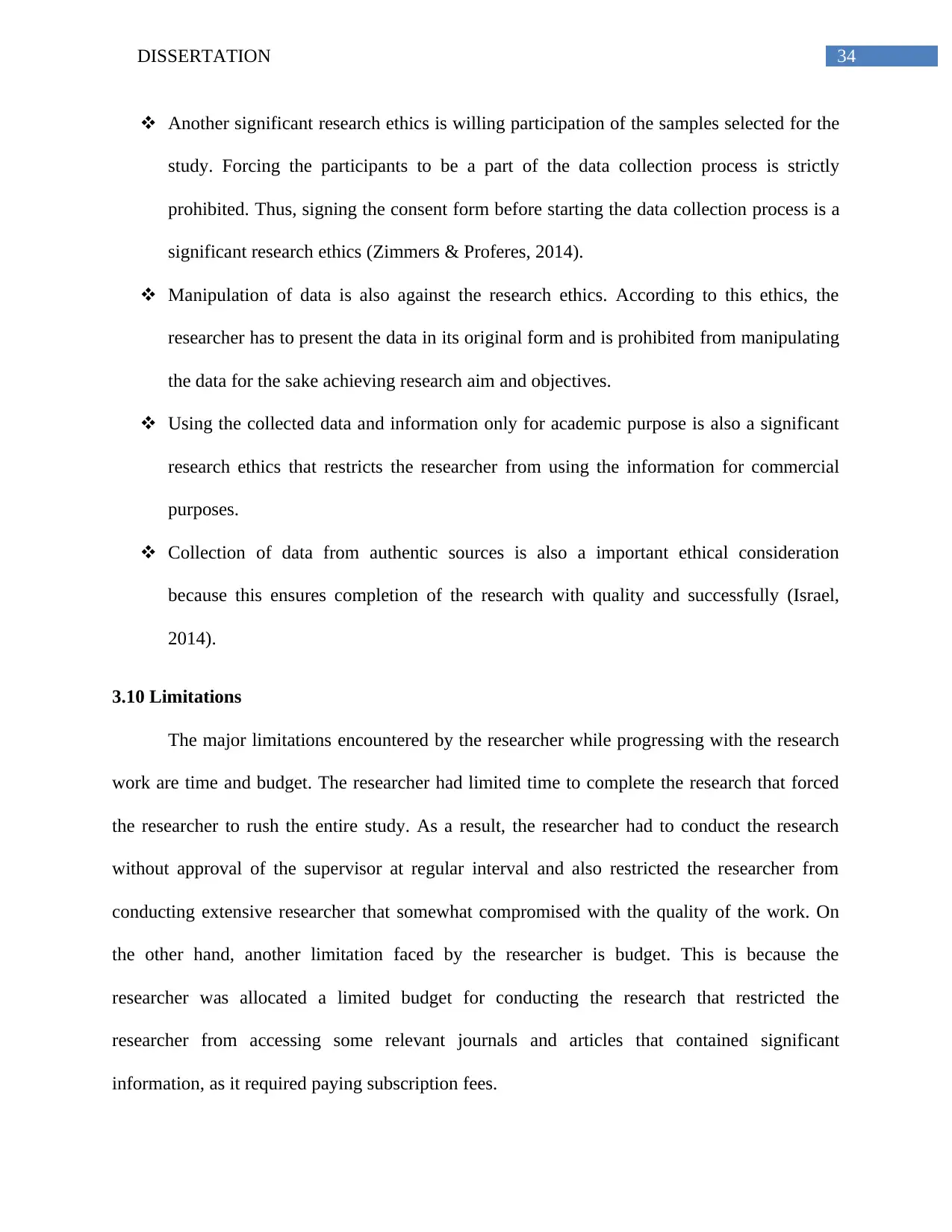
34DISSERTATION
Another significant research ethics is willing participation of the samples selected for the
study. Forcing the participants to be a part of the data collection process is strictly
prohibited. Thus, signing the consent form before starting the data collection process is a
significant research ethics (Zimmers & Proferes, 2014).
Manipulation of data is also against the research ethics. According to this ethics, the
researcher has to present the data in its original form and is prohibited from manipulating
the data for the sake achieving research aim and objectives.
Using the collected data and information only for academic purpose is also a significant
research ethics that restricts the researcher from using the information for commercial
purposes.
Collection of data from authentic sources is also a important ethical consideration
because this ensures completion of the research with quality and successfully (Israel,
2014).
3.10 Limitations
The major limitations encountered by the researcher while progressing with the research
work are time and budget. The researcher had limited time to complete the research that forced
the researcher to rush the entire study. As a result, the researcher had to conduct the research
without approval of the supervisor at regular interval and also restricted the researcher from
conducting extensive researcher that somewhat compromised with the quality of the work. On
the other hand, another limitation faced by the researcher is budget. This is because the
researcher was allocated a limited budget for conducting the research that restricted the
researcher from accessing some relevant journals and articles that contained significant
information, as it required paying subscription fees.
Another significant research ethics is willing participation of the samples selected for the
study. Forcing the participants to be a part of the data collection process is strictly
prohibited. Thus, signing the consent form before starting the data collection process is a
significant research ethics (Zimmers & Proferes, 2014).
Manipulation of data is also against the research ethics. According to this ethics, the
researcher has to present the data in its original form and is prohibited from manipulating
the data for the sake achieving research aim and objectives.
Using the collected data and information only for academic purpose is also a significant
research ethics that restricts the researcher from using the information for commercial
purposes.
Collection of data from authentic sources is also a important ethical consideration
because this ensures completion of the research with quality and successfully (Israel,
2014).
3.10 Limitations
The major limitations encountered by the researcher while progressing with the research
work are time and budget. The researcher had limited time to complete the research that forced
the researcher to rush the entire study. As a result, the researcher had to conduct the research
without approval of the supervisor at regular interval and also restricted the researcher from
conducting extensive researcher that somewhat compromised with the quality of the work. On
the other hand, another limitation faced by the researcher is budget. This is because the
researcher was allocated a limited budget for conducting the research that restricted the
researcher from accessing some relevant journals and articles that contained significant
information, as it required paying subscription fees.
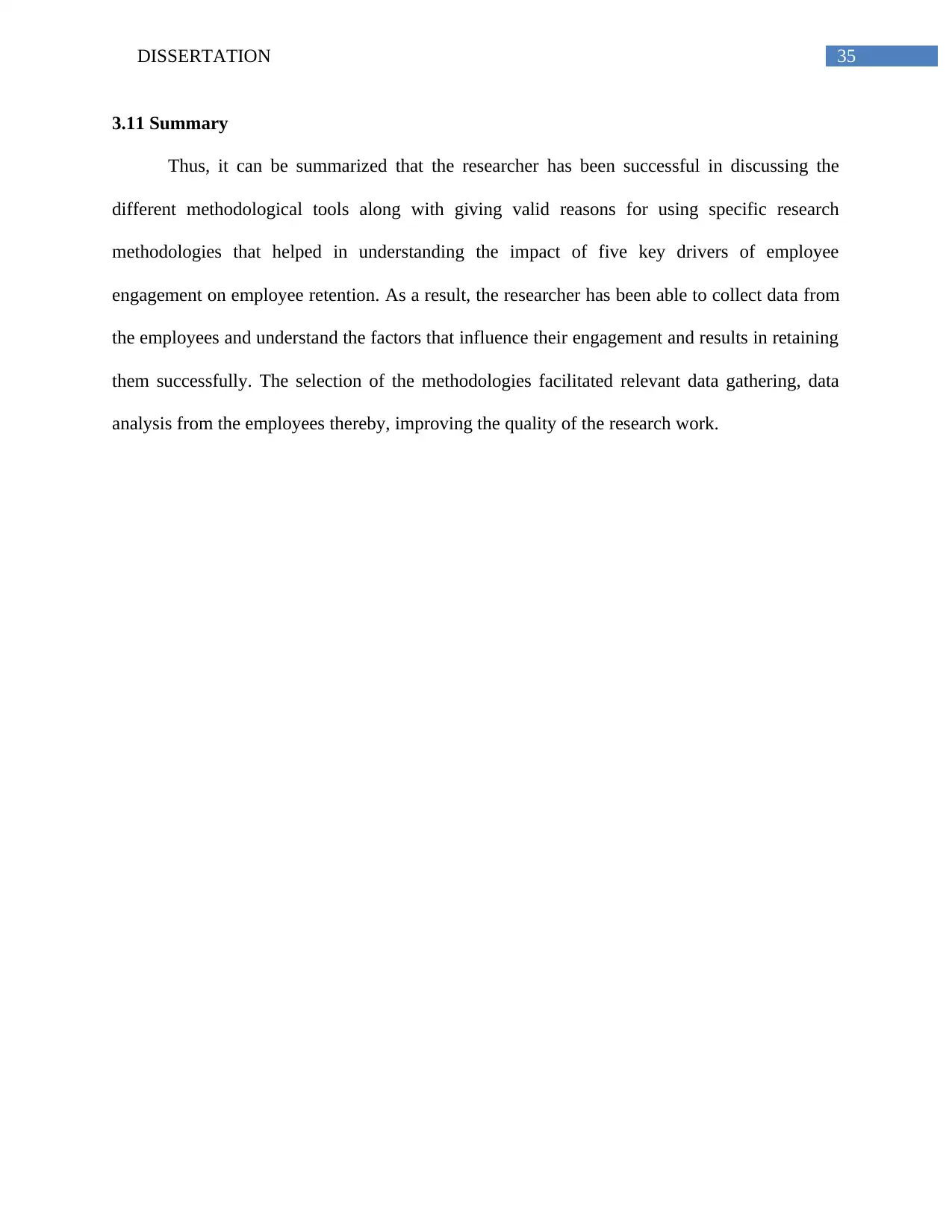
35DISSERTATION
3.11 Summary
Thus, it can be summarized that the researcher has been successful in discussing the
different methodological tools along with giving valid reasons for using specific research
methodologies that helped in understanding the impact of five key drivers of employee
engagement on employee retention. As a result, the researcher has been able to collect data from
the employees and understand the factors that influence their engagement and results in retaining
them successfully. The selection of the methodologies facilitated relevant data gathering, data
analysis from the employees thereby, improving the quality of the research work.
3.11 Summary
Thus, it can be summarized that the researcher has been successful in discussing the
different methodological tools along with giving valid reasons for using specific research
methodologies that helped in understanding the impact of five key drivers of employee
engagement on employee retention. As a result, the researcher has been able to collect data from
the employees and understand the factors that influence their engagement and results in retaining
them successfully. The selection of the methodologies facilitated relevant data gathering, data
analysis from the employees thereby, improving the quality of the research work.
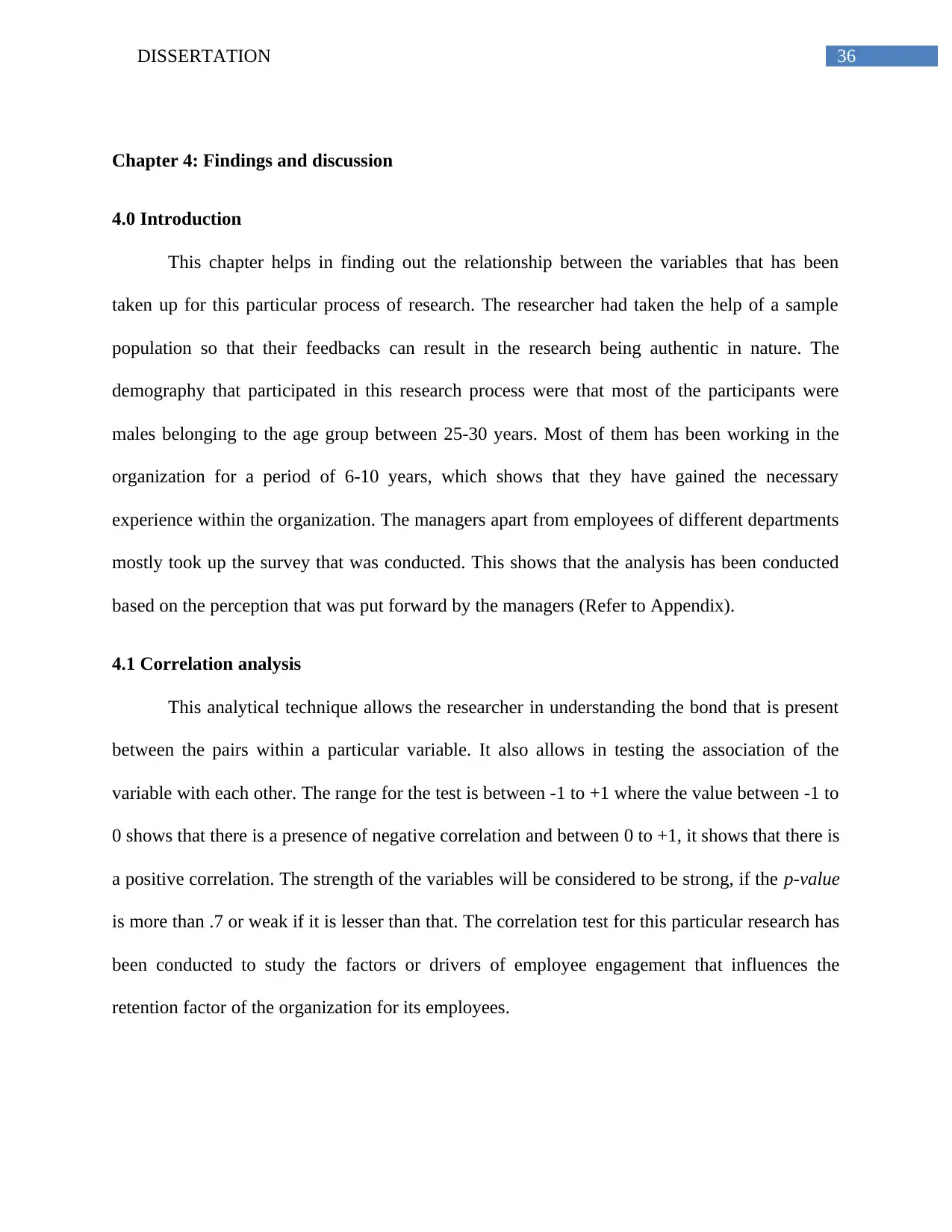
36DISSERTATION
Chapter 4: Findings and discussion
4.0 Introduction
This chapter helps in finding out the relationship between the variables that has been
taken up for this particular process of research. The researcher had taken the help of a sample
population so that their feedbacks can result in the research being authentic in nature. The
demography that participated in this research process were that most of the participants were
males belonging to the age group between 25-30 years. Most of them has been working in the
organization for a period of 6-10 years, which shows that they have gained the necessary
experience within the organization. The managers apart from employees of different departments
mostly took up the survey that was conducted. This shows that the analysis has been conducted
based on the perception that was put forward by the managers (Refer to Appendix).
4.1 Correlation analysis
This analytical technique allows the researcher in understanding the bond that is present
between the pairs within a particular variable. It also allows in testing the association of the
variable with each other. The range for the test is between -1 to +1 where the value between -1 to
0 shows that there is a presence of negative correlation and between 0 to +1, it shows that there is
a positive correlation. The strength of the variables will be considered to be strong, if the p-value
is more than .7 or weak if it is lesser than that. The correlation test for this particular research has
been conducted to study the factors or drivers of employee engagement that influences the
retention factor of the organization for its employees.
Chapter 4: Findings and discussion
4.0 Introduction
This chapter helps in finding out the relationship between the variables that has been
taken up for this particular process of research. The researcher had taken the help of a sample
population so that their feedbacks can result in the research being authentic in nature. The
demography that participated in this research process were that most of the participants were
males belonging to the age group between 25-30 years. Most of them has been working in the
organization for a period of 6-10 years, which shows that they have gained the necessary
experience within the organization. The managers apart from employees of different departments
mostly took up the survey that was conducted. This shows that the analysis has been conducted
based on the perception that was put forward by the managers (Refer to Appendix).
4.1 Correlation analysis
This analytical technique allows the researcher in understanding the bond that is present
between the pairs within a particular variable. It also allows in testing the association of the
variable with each other. The range for the test is between -1 to +1 where the value between -1 to
0 shows that there is a presence of negative correlation and between 0 to +1, it shows that there is
a positive correlation. The strength of the variables will be considered to be strong, if the p-value
is more than .7 or weak if it is lesser than that. The correlation test for this particular research has
been conducted to study the factors or drivers of employee engagement that influences the
retention factor of the organization for its employees.
Paraphrase This Document
Need a fresh take? Get an instant paraphrase of this document with our AI Paraphraser
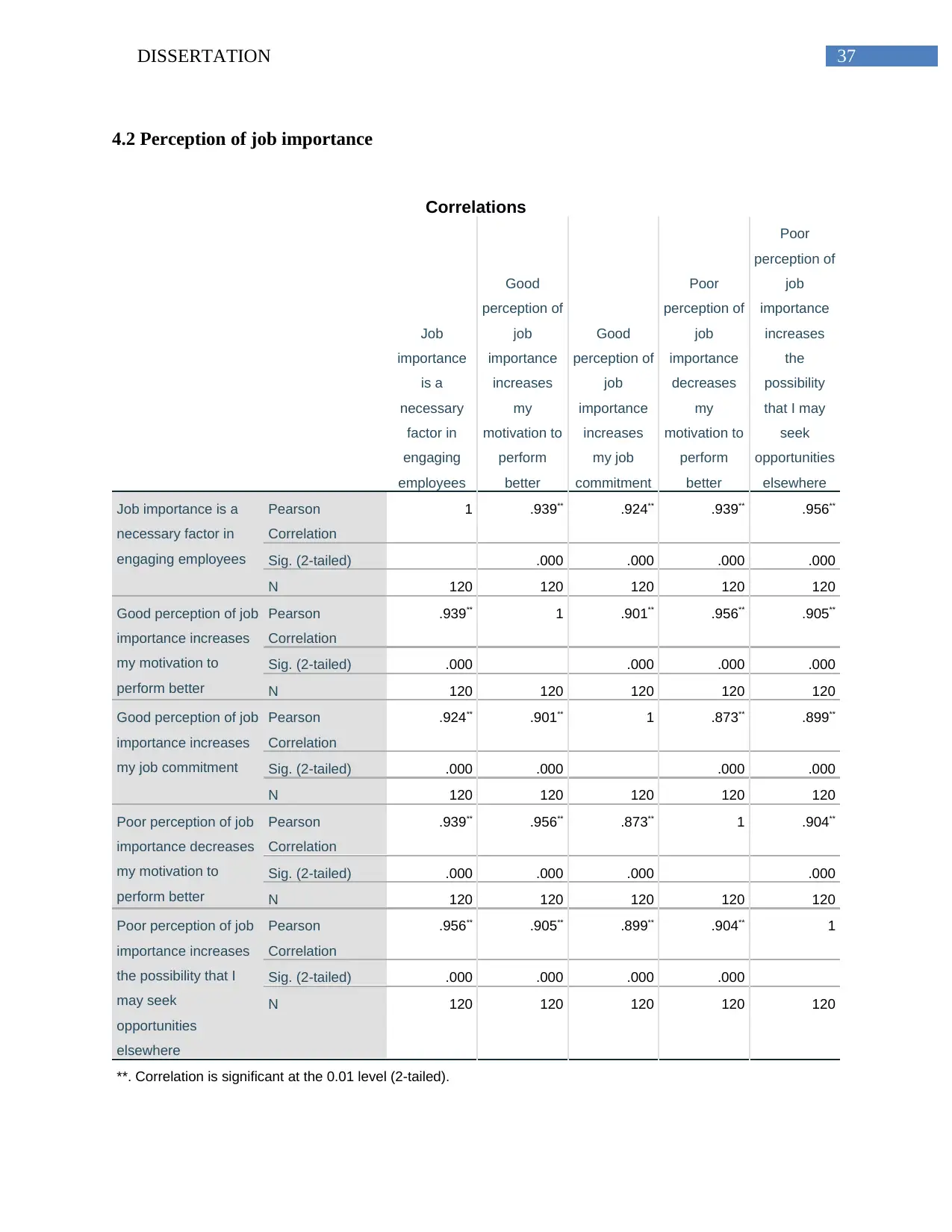
37DISSERTATION
4.2 Perception of job importance
Correlations
Job
importance
is a
necessary
factor in
engaging
employees
Good
perception of
job
importance
increases
my
motivation to
perform
better
Good
perception of
job
importance
increases
my job
commitment
Poor
perception of
job
importance
decreases
my
motivation to
perform
better
Poor
perception of
job
importance
increases
the
possibility
that I may
seek
opportunities
elsewhere
Job importance is a
necessary factor in
engaging employees
Pearson
Correlation
1 .939** .924** .939** .956**
Sig. (2-tailed) .000 .000 .000 .000
N 120 120 120 120 120
Good perception of job
importance increases
my motivation to
perform better
Pearson
Correlation
.939** 1 .901** .956** .905**
Sig. (2-tailed) .000 .000 .000 .000
N 120 120 120 120 120
Good perception of job
importance increases
my job commitment
Pearson
Correlation
.924** .901** 1 .873** .899**
Sig. (2-tailed) .000 .000 .000 .000
N 120 120 120 120 120
Poor perception of job
importance decreases
my motivation to
perform better
Pearson
Correlation
.939** .956** .873** 1 .904**
Sig. (2-tailed) .000 .000 .000 .000
N 120 120 120 120 120
Poor perception of job
importance increases
the possibility that I
may seek
opportunities
elsewhere
Pearson
Correlation
.956** .905** .899** .904** 1
Sig. (2-tailed) .000 .000 .000 .000
N 120 120 120 120 120
**. Correlation is significant at the 0.01 level (2-tailed).
4.2 Perception of job importance
Correlations
Job
importance
is a
necessary
factor in
engaging
employees
Good
perception of
job
importance
increases
my
motivation to
perform
better
Good
perception of
job
importance
increases
my job
commitment
Poor
perception of
job
importance
decreases
my
motivation to
perform
better
Poor
perception of
job
importance
increases
the
possibility
that I may
seek
opportunities
elsewhere
Job importance is a
necessary factor in
engaging employees
Pearson
Correlation
1 .939** .924** .939** .956**
Sig. (2-tailed) .000 .000 .000 .000
N 120 120 120 120 120
Good perception of job
importance increases
my motivation to
perform better
Pearson
Correlation
.939** 1 .901** .956** .905**
Sig. (2-tailed) .000 .000 .000 .000
N 120 120 120 120 120
Good perception of job
importance increases
my job commitment
Pearson
Correlation
.924** .901** 1 .873** .899**
Sig. (2-tailed) .000 .000 .000 .000
N 120 120 120 120 120
Poor perception of job
importance decreases
my motivation to
perform better
Pearson
Correlation
.939** .956** .873** 1 .904**
Sig. (2-tailed) .000 .000 .000 .000
N 120 120 120 120 120
Poor perception of job
importance increases
the possibility that I
may seek
opportunities
elsewhere
Pearson
Correlation
.956** .905** .899** .904** 1
Sig. (2-tailed) .000 .000 .000 .000
N 120 120 120 120 120
**. Correlation is significant at the 0.01 level (2-tailed).
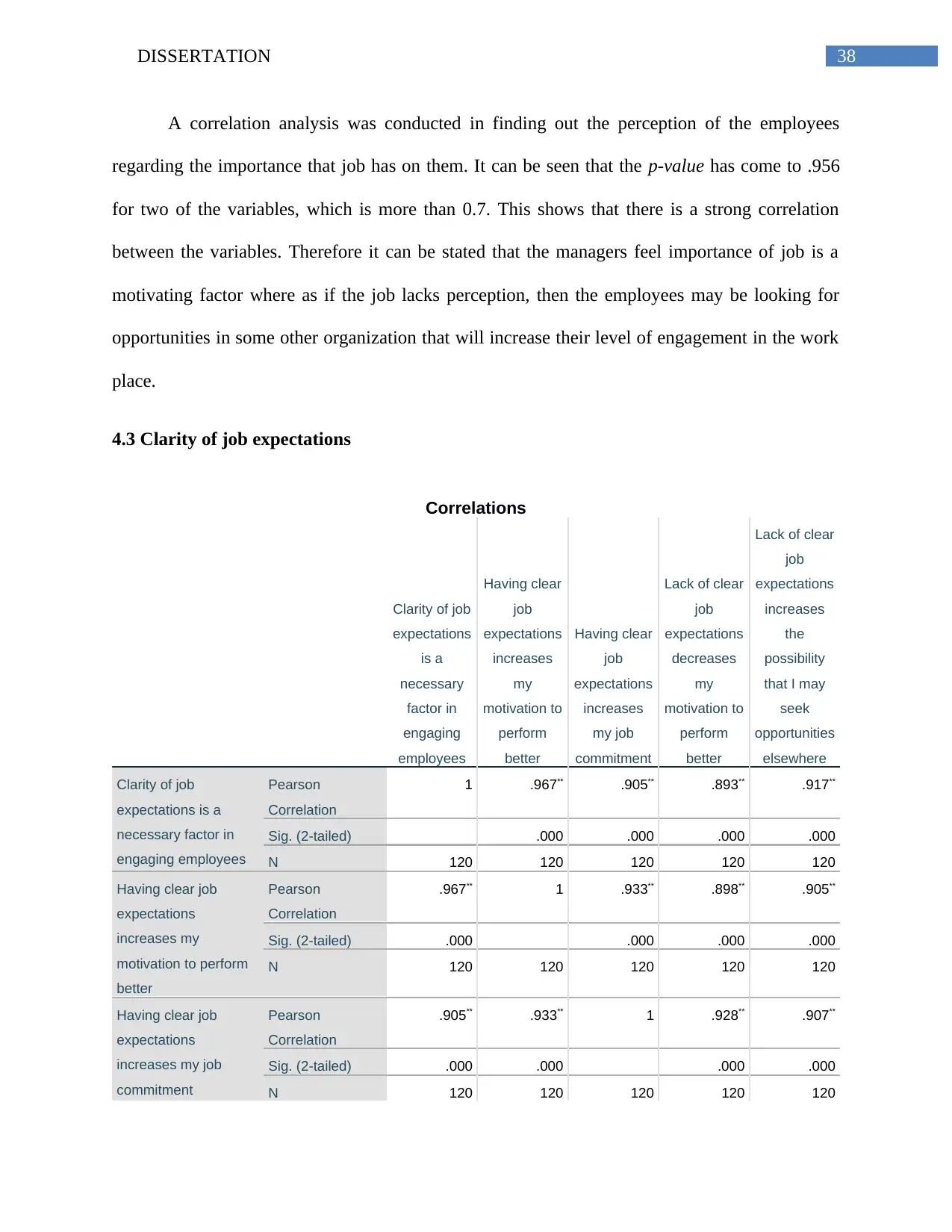
38DISSERTATION
A correlation analysis was conducted in finding out the perception of the employees
regarding the importance that job has on them. It can be seen that the p-value has come to .956
for two of the variables, which is more than 0.7. This shows that there is a strong correlation
between the variables. Therefore it can be stated that the managers feel importance of job is a
motivating factor where as if the job lacks perception, then the employees may be looking for
opportunities in some other organization that will increase their level of engagement in the work
place.
4.3 Clarity of job expectations
Correlations
Clarity of job
expectations
is a
necessary
factor in
engaging
employees
Having clear
job
expectations
increases
my
motivation to
perform
better
Having clear
job
expectations
increases
my job
commitment
Lack of clear
job
expectations
decreases
my
motivation to
perform
better
Lack of clear
job
expectations
increases
the
possibility
that I may
seek
opportunities
elsewhere
Clarity of job
expectations is a
necessary factor in
engaging employees
Pearson
Correlation
1 .967** .905** .893** .917**
Sig. (2-tailed) .000 .000 .000 .000
N 120 120 120 120 120
Having clear job
expectations
increases my
motivation to perform
better
Pearson
Correlation
.967** 1 .933** .898** .905**
Sig. (2-tailed) .000 .000 .000 .000
N 120 120 120 120 120
Having clear job
expectations
increases my job
commitment
Pearson
Correlation
.905** .933** 1 .928** .907**
Sig. (2-tailed) .000 .000 .000 .000
N 120 120 120 120 120
A correlation analysis was conducted in finding out the perception of the employees
regarding the importance that job has on them. It can be seen that the p-value has come to .956
for two of the variables, which is more than 0.7. This shows that there is a strong correlation
between the variables. Therefore it can be stated that the managers feel importance of job is a
motivating factor where as if the job lacks perception, then the employees may be looking for
opportunities in some other organization that will increase their level of engagement in the work
place.
4.3 Clarity of job expectations
Correlations
Clarity of job
expectations
is a
necessary
factor in
engaging
employees
Having clear
job
expectations
increases
my
motivation to
perform
better
Having clear
job
expectations
increases
my job
commitment
Lack of clear
job
expectations
decreases
my
motivation to
perform
better
Lack of clear
job
expectations
increases
the
possibility
that I may
seek
opportunities
elsewhere
Clarity of job
expectations is a
necessary factor in
engaging employees
Pearson
Correlation
1 .967** .905** .893** .917**
Sig. (2-tailed) .000 .000 .000 .000
N 120 120 120 120 120
Having clear job
expectations
increases my
motivation to perform
better
Pearson
Correlation
.967** 1 .933** .898** .905**
Sig. (2-tailed) .000 .000 .000 .000
N 120 120 120 120 120
Having clear job
expectations
increases my job
commitment
Pearson
Correlation
.905** .933** 1 .928** .907**
Sig. (2-tailed) .000 .000 .000 .000
N 120 120 120 120 120
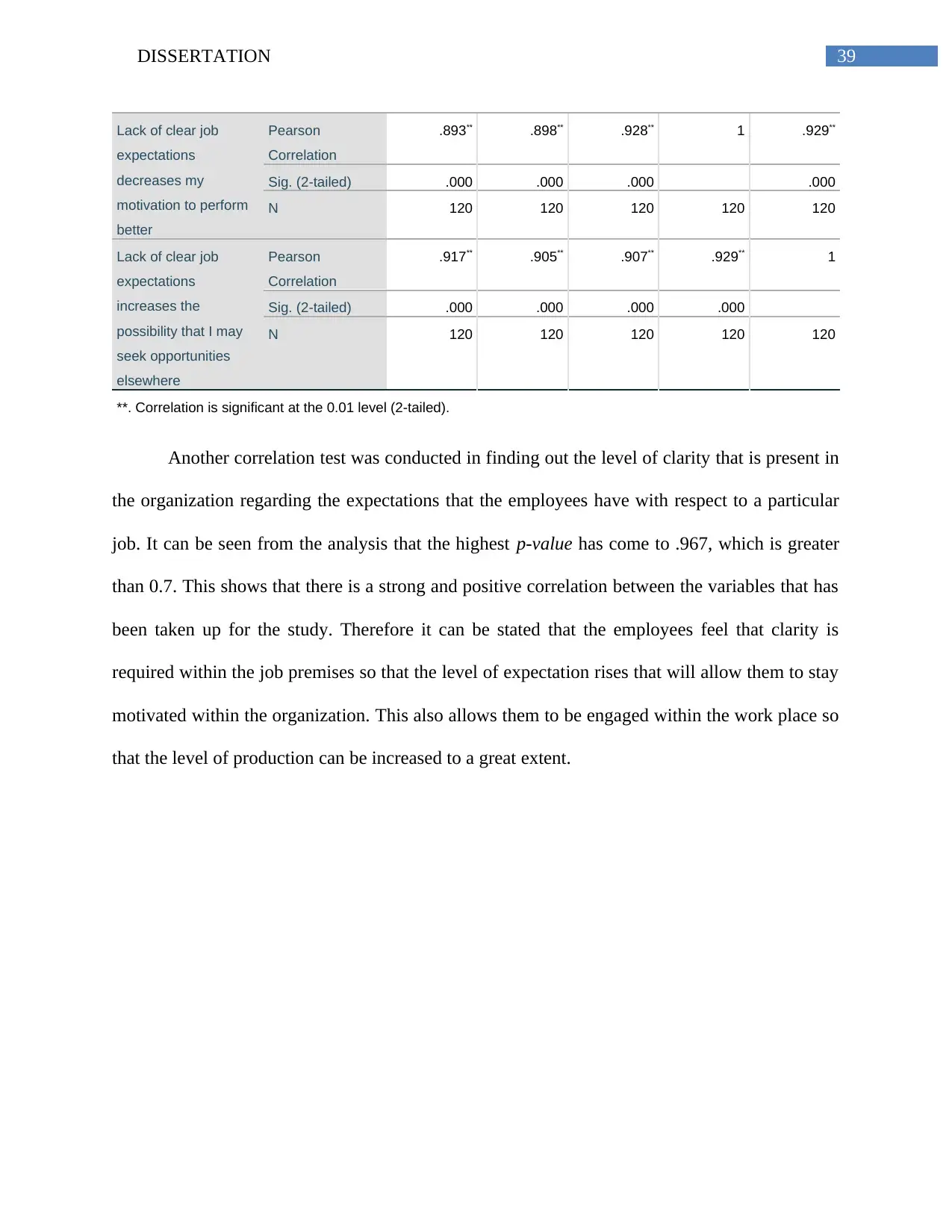
39DISSERTATION
Lack of clear job
expectations
decreases my
motivation to perform
better
Pearson
Correlation
.893** .898** .928** 1 .929**
Sig. (2-tailed) .000 .000 .000 .000
N 120 120 120 120 120
Lack of clear job
expectations
increases the
possibility that I may
seek opportunities
elsewhere
Pearson
Correlation
.917** .905** .907** .929** 1
Sig. (2-tailed) .000 .000 .000 .000
N 120 120 120 120 120
**. Correlation is significant at the 0.01 level (2-tailed).
Another correlation test was conducted in finding out the level of clarity that is present in
the organization regarding the expectations that the employees have with respect to a particular
job. It can be seen from the analysis that the highest p-value has come to .967, which is greater
than 0.7. This shows that there is a strong and positive correlation between the variables that has
been taken up for the study. Therefore it can be stated that the employees feel that clarity is
required within the job premises so that the level of expectation rises that will allow them to stay
motivated within the organization. This also allows them to be engaged within the work place so
that the level of production can be increased to a great extent.
Lack of clear job
expectations
decreases my
motivation to perform
better
Pearson
Correlation
.893** .898** .928** 1 .929**
Sig. (2-tailed) .000 .000 .000 .000
N 120 120 120 120 120
Lack of clear job
expectations
increases the
possibility that I may
seek opportunities
elsewhere
Pearson
Correlation
.917** .905** .907** .929** 1
Sig. (2-tailed) .000 .000 .000 .000
N 120 120 120 120 120
**. Correlation is significant at the 0.01 level (2-tailed).
Another correlation test was conducted in finding out the level of clarity that is present in
the organization regarding the expectations that the employees have with respect to a particular
job. It can be seen from the analysis that the highest p-value has come to .967, which is greater
than 0.7. This shows that there is a strong and positive correlation between the variables that has
been taken up for the study. Therefore it can be stated that the employees feel that clarity is
required within the job premises so that the level of expectation rises that will allow them to stay
motivated within the organization. This also allows them to be engaged within the work place so
that the level of production can be increased to a great extent.
Secure Best Marks with AI Grader
Need help grading? Try our AI Grader for instant feedback on your assignments.
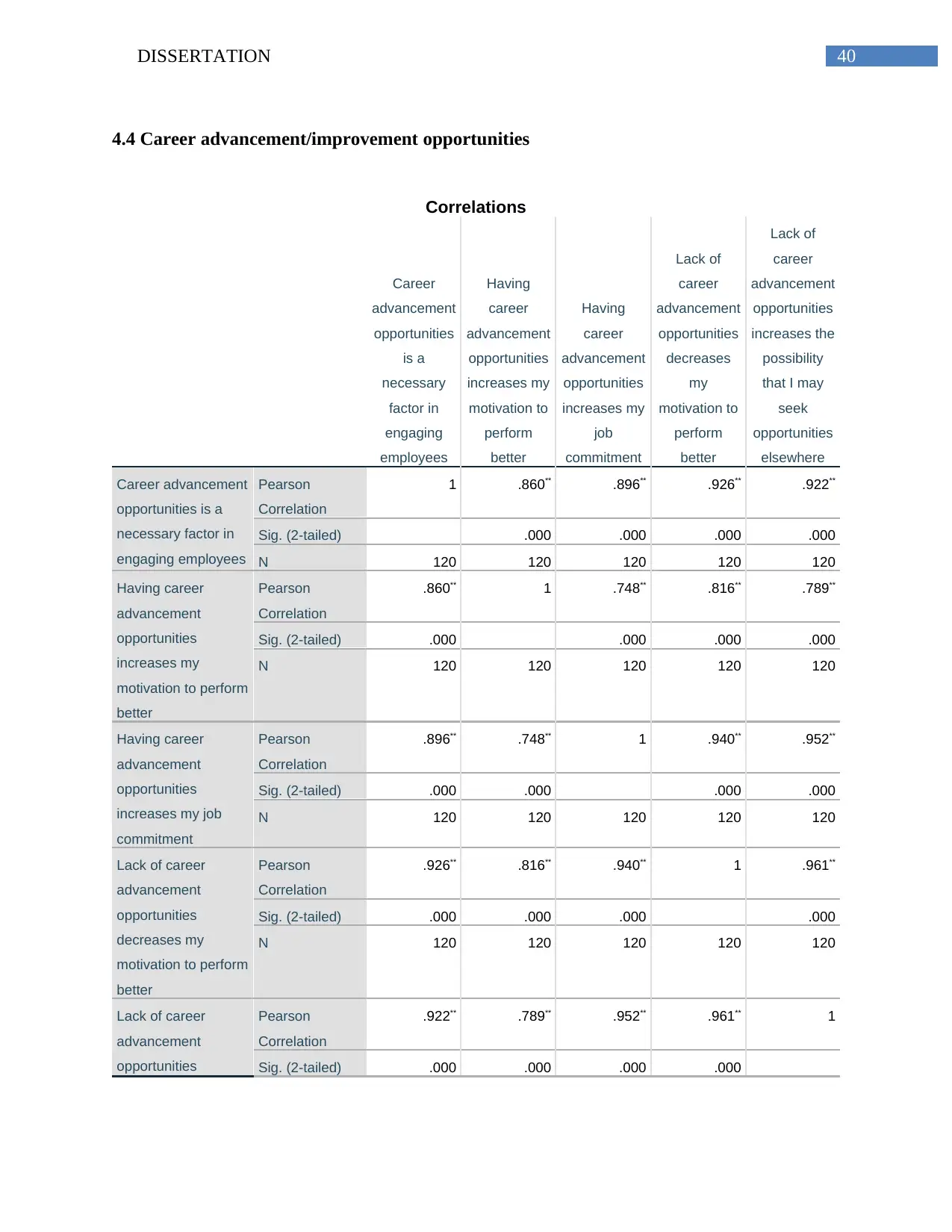
40DISSERTATION
4.4 Career advancement/improvement opportunities
Correlations
Career
advancement
opportunities
is a
necessary
factor in
engaging
employees
Having
career
advancement
opportunities
increases my
motivation to
perform
better
Having
career
advancement
opportunities
increases my
job
commitment
Lack of
career
advancement
opportunities
decreases
my
motivation to
perform
better
Lack of
career
advancement
opportunities
increases the
possibility
that I may
seek
opportunities
elsewhere
Career advancement
opportunities is a
necessary factor in
engaging employees
Pearson
Correlation
1 .860** .896** .926** .922**
Sig. (2-tailed) .000 .000 .000 .000
N 120 120 120 120 120
Having career
advancement
opportunities
increases my
motivation to perform
better
Pearson
Correlation
.860** 1 .748** .816** .789**
Sig. (2-tailed) .000 .000 .000 .000
N 120 120 120 120 120
Having career
advancement
opportunities
increases my job
commitment
Pearson
Correlation
.896** .748** 1 .940** .952**
Sig. (2-tailed) .000 .000 .000 .000
N 120 120 120 120 120
Lack of career
advancement
opportunities
decreases my
motivation to perform
better
Pearson
Correlation
.926** .816** .940** 1 .961**
Sig. (2-tailed) .000 .000 .000 .000
N 120 120 120 120 120
Lack of career
advancement
opportunities
Pearson
Correlation
.922** .789** .952** .961** 1
Sig. (2-tailed) .000 .000 .000 .000
4.4 Career advancement/improvement opportunities
Correlations
Career
advancement
opportunities
is a
necessary
factor in
engaging
employees
Having
career
advancement
opportunities
increases my
motivation to
perform
better
Having
career
advancement
opportunities
increases my
job
commitment
Lack of
career
advancement
opportunities
decreases
my
motivation to
perform
better
Lack of
career
advancement
opportunities
increases the
possibility
that I may
seek
opportunities
elsewhere
Career advancement
opportunities is a
necessary factor in
engaging employees
Pearson
Correlation
1 .860** .896** .926** .922**
Sig. (2-tailed) .000 .000 .000 .000
N 120 120 120 120 120
Having career
advancement
opportunities
increases my
motivation to perform
better
Pearson
Correlation
.860** 1 .748** .816** .789**
Sig. (2-tailed) .000 .000 .000 .000
N 120 120 120 120 120
Having career
advancement
opportunities
increases my job
commitment
Pearson
Correlation
.896** .748** 1 .940** .952**
Sig. (2-tailed) .000 .000 .000 .000
N 120 120 120 120 120
Lack of career
advancement
opportunities
decreases my
motivation to perform
better
Pearson
Correlation
.926** .816** .940** 1 .961**
Sig. (2-tailed) .000 .000 .000 .000
N 120 120 120 120 120
Lack of career
advancement
opportunities
Pearson
Correlation
.922** .789** .952** .961** 1
Sig. (2-tailed) .000 .000 .000 .000

41DISSERTATION
increases the
possibility that I may
seek opportunities
elsewhere
N 120 120 120 120 120
**. Correlation is significant at the 0.01 level (2-tailed).
In understanding the career advancement opportunities that are present among the
employees, a correlation study was conducted so that it can help in understanding the association
of the variables with each other. It can be seen that the highest p-value has come to .961, which
is more than .7. This shows that there is a strong and positive correlation between the factors that
has been taken up to study this particular independent variable. Thus it can be stated that the
employees feel that the lack of the career advancement opportunities decreases their motivation
within the organization, which urges them to seek opportunities in some other organizations.
increases the
possibility that I may
seek opportunities
elsewhere
N 120 120 120 120 120
**. Correlation is significant at the 0.01 level (2-tailed).
In understanding the career advancement opportunities that are present among the
employees, a correlation study was conducted so that it can help in understanding the association
of the variables with each other. It can be seen that the highest p-value has come to .961, which
is more than .7. This shows that there is a strong and positive correlation between the factors that
has been taken up to study this particular independent variable. Thus it can be stated that the
employees feel that the lack of the career advancement opportunities decreases their motivation
within the organization, which urges them to seek opportunities in some other organizations.

42DISSERTATION
4.5 Regular feedback and dialogue with superiors
Correlations
Regular
feedback
and dialogue
with
superiors is
a necessary
factor in
engaging
employees
Having
regular
feedback
and dialogue
with
superiors
increases
my
motivation to
perform
better
Having
regular
feedback
and dialogue
with
superiors
increases
my job
commitment
Lack of
regular
feedback
and dialogue
with
superiors
decreases
my
motivation to
perform
better
Lack of
regular
feedback
and dialogue
with
superiors
increases
the
possibility
that I may
seek
opportunities
elsewhere
Regular feedback and
dialogue with
superiors is a
necessary factor in
engaging employees
Pearson
Correlation
1 .916** .901** .893** .898**
Sig. (2-tailed) .000 .000 .000 .000
N 120 120 120 120 120
Having regular
feedback and dialogue
with superiors
increases my
motivation to perform
better
Pearson
Correlation
.916** 1 .945** .916** .910**
Sig. (2-tailed) .000 .000 .000 .000
N 120 120 120 120 120
Having regular
feedback and dialogue
with superiors
increases my job
commitment
Pearson
Correlation
.901** .945** 1 .948** .905**
Sig. (2-tailed) .000 .000 .000 .000
N 120 120 120 120 120
Lack of regular
feedback and dialogue
with superiors
decreases my
motivation to perform
better
Pearson
Correlation
.893** .916** .948** 1 .946**
Sig. (2-tailed) .000 .000 .000 .000
N 120 120 120 120 120
4.5 Regular feedback and dialogue with superiors
Correlations
Regular
feedback
and dialogue
with
superiors is
a necessary
factor in
engaging
employees
Having
regular
feedback
and dialogue
with
superiors
increases
my
motivation to
perform
better
Having
regular
feedback
and dialogue
with
superiors
increases
my job
commitment
Lack of
regular
feedback
and dialogue
with
superiors
decreases
my
motivation to
perform
better
Lack of
regular
feedback
and dialogue
with
superiors
increases
the
possibility
that I may
seek
opportunities
elsewhere
Regular feedback and
dialogue with
superiors is a
necessary factor in
engaging employees
Pearson
Correlation
1 .916** .901** .893** .898**
Sig. (2-tailed) .000 .000 .000 .000
N 120 120 120 120 120
Having regular
feedback and dialogue
with superiors
increases my
motivation to perform
better
Pearson
Correlation
.916** 1 .945** .916** .910**
Sig. (2-tailed) .000 .000 .000 .000
N 120 120 120 120 120
Having regular
feedback and dialogue
with superiors
increases my job
commitment
Pearson
Correlation
.901** .945** 1 .948** .905**
Sig. (2-tailed) .000 .000 .000 .000
N 120 120 120 120 120
Lack of regular
feedback and dialogue
with superiors
decreases my
motivation to perform
better
Pearson
Correlation
.893** .916** .948** 1 .946**
Sig. (2-tailed) .000 .000 .000 .000
N 120 120 120 120 120
Paraphrase This Document
Need a fresh take? Get an instant paraphrase of this document with our AI Paraphraser
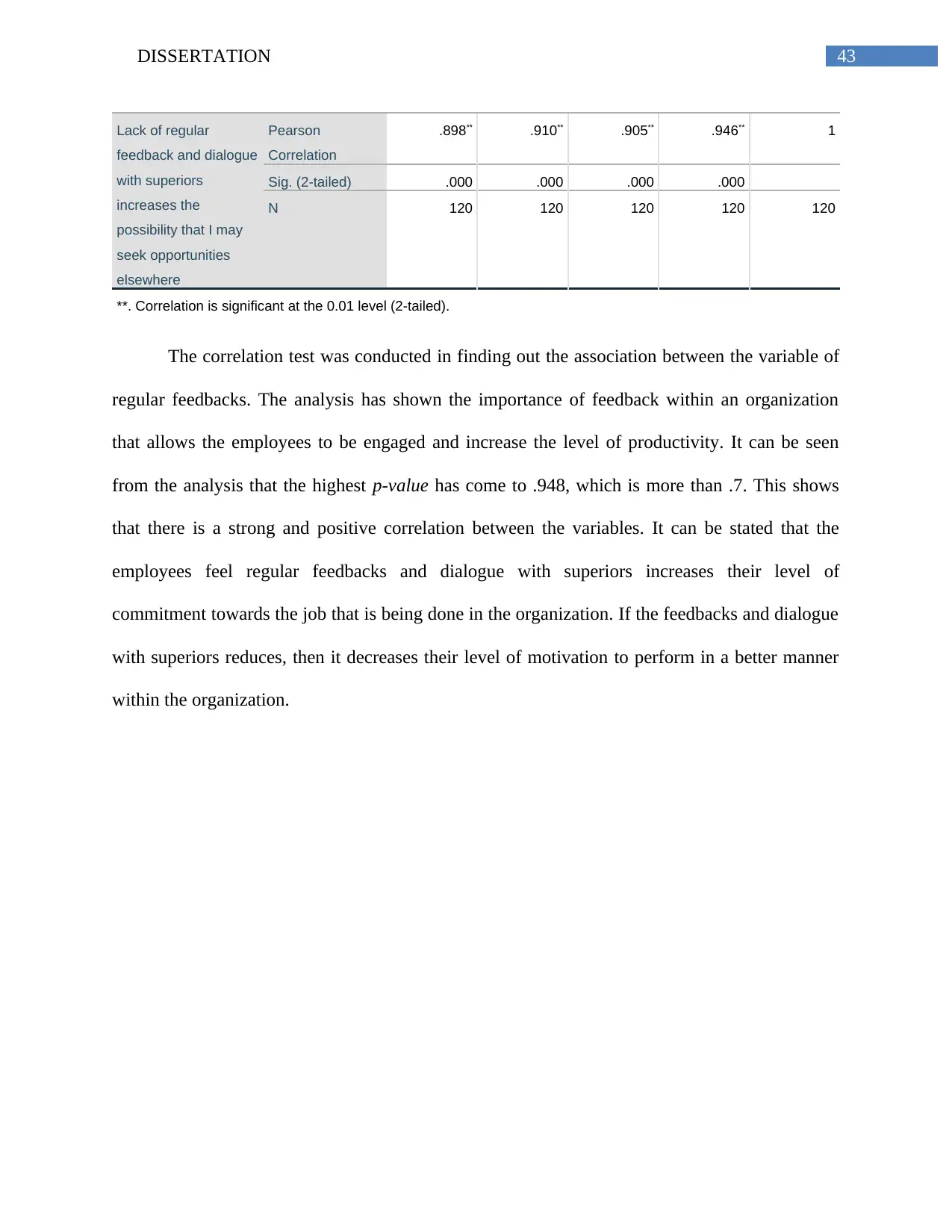
43DISSERTATION
Lack of regular
feedback and dialogue
with superiors
increases the
possibility that I may
seek opportunities
elsewhere
Pearson
Correlation
.898** .910** .905** .946** 1
Sig. (2-tailed) .000 .000 .000 .000
N 120 120 120 120 120
**. Correlation is significant at the 0.01 level (2-tailed).
The correlation test was conducted in finding out the association between the variable of
regular feedbacks. The analysis has shown the importance of feedback within an organization
that allows the employees to be engaged and increase the level of productivity. It can be seen
from the analysis that the highest p-value has come to .948, which is more than .7. This shows
that there is a strong and positive correlation between the variables. It can be stated that the
employees feel regular feedbacks and dialogue with superiors increases their level of
commitment towards the job that is being done in the organization. If the feedbacks and dialogue
with superiors reduces, then it decreases their level of motivation to perform in a better manner
within the organization.
Lack of regular
feedback and dialogue
with superiors
increases the
possibility that I may
seek opportunities
elsewhere
Pearson
Correlation
.898** .910** .905** .946** 1
Sig. (2-tailed) .000 .000 .000 .000
N 120 120 120 120 120
**. Correlation is significant at the 0.01 level (2-tailed).
The correlation test was conducted in finding out the association between the variable of
regular feedbacks. The analysis has shown the importance of feedback within an organization
that allows the employees to be engaged and increase the level of productivity. It can be seen
from the analysis that the highest p-value has come to .948, which is more than .7. This shows
that there is a strong and positive correlation between the variables. It can be stated that the
employees feel regular feedbacks and dialogue with superiors increases their level of
commitment towards the job that is being done in the organization. If the feedbacks and dialogue
with superiors reduces, then it decreases their level of motivation to perform in a better manner
within the organization.
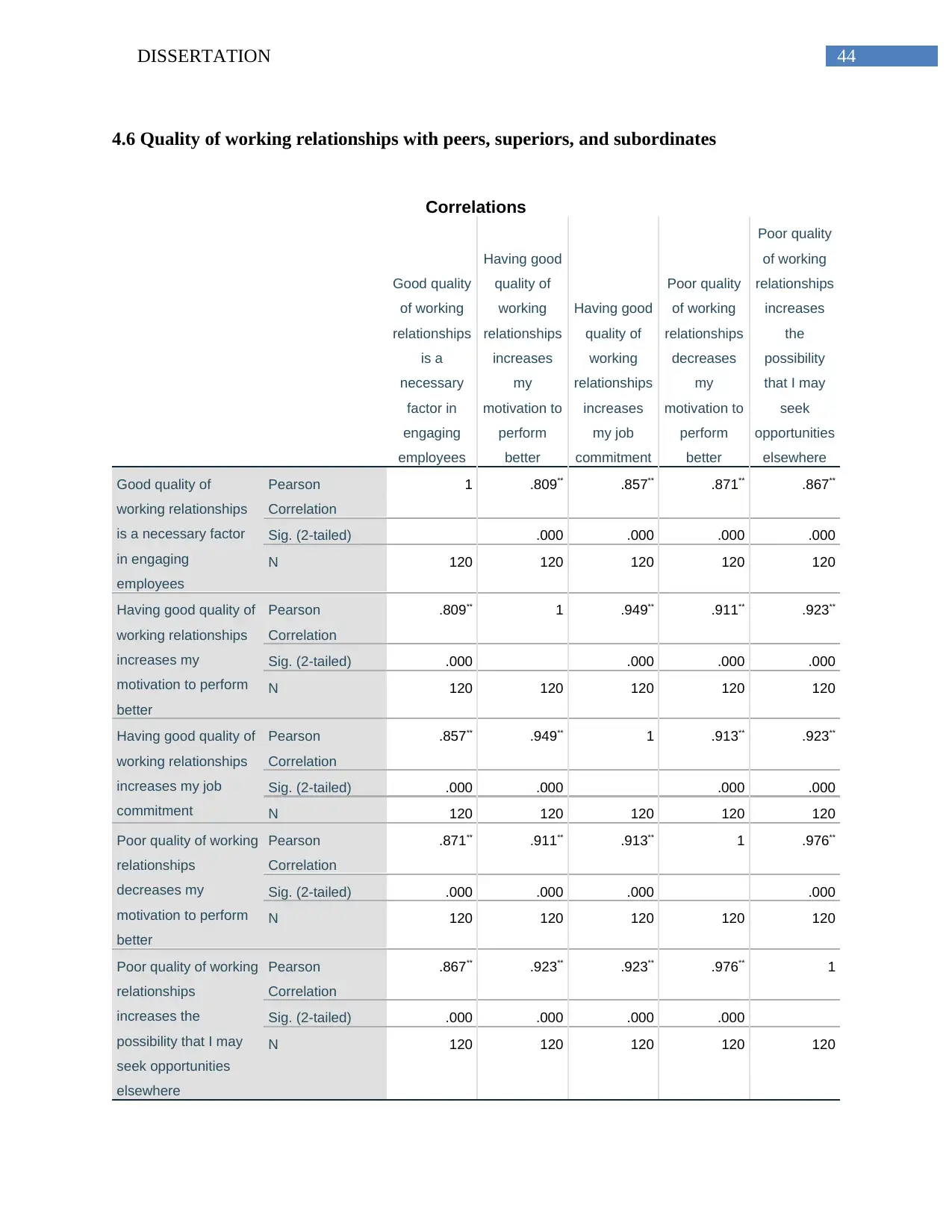
44DISSERTATION
4.6 Quality of working relationships with peers, superiors, and subordinates
Correlations
Good quality
of working
relationships
is a
necessary
factor in
engaging
employees
Having good
quality of
working
relationships
increases
my
motivation to
perform
better
Having good
quality of
working
relationships
increases
my job
commitment
Poor quality
of working
relationships
decreases
my
motivation to
perform
better
Poor quality
of working
relationships
increases
the
possibility
that I may
seek
opportunities
elsewhere
Good quality of
working relationships
is a necessary factor
in engaging
employees
Pearson
Correlation
1 .809** .857** .871** .867**
Sig. (2-tailed) .000 .000 .000 .000
N 120 120 120 120 120
Having good quality of
working relationships
increases my
motivation to perform
better
Pearson
Correlation
.809** 1 .949** .911** .923**
Sig. (2-tailed) .000 .000 .000 .000
N 120 120 120 120 120
Having good quality of
working relationships
increases my job
commitment
Pearson
Correlation
.857** .949** 1 .913** .923**
Sig. (2-tailed) .000 .000 .000 .000
N 120 120 120 120 120
Poor quality of working
relationships
decreases my
motivation to perform
better
Pearson
Correlation
.871** .911** .913** 1 .976**
Sig. (2-tailed) .000 .000 .000 .000
N 120 120 120 120 120
Poor quality of working
relationships
increases the
possibility that I may
seek opportunities
elsewhere
Pearson
Correlation
.867** .923** .923** .976** 1
Sig. (2-tailed) .000 .000 .000 .000
N 120 120 120 120 120
4.6 Quality of working relationships with peers, superiors, and subordinates
Correlations
Good quality
of working
relationships
is a
necessary
factor in
engaging
employees
Having good
quality of
working
relationships
increases
my
motivation to
perform
better
Having good
quality of
working
relationships
increases
my job
commitment
Poor quality
of working
relationships
decreases
my
motivation to
perform
better
Poor quality
of working
relationships
increases
the
possibility
that I may
seek
opportunities
elsewhere
Good quality of
working relationships
is a necessary factor
in engaging
employees
Pearson
Correlation
1 .809** .857** .871** .867**
Sig. (2-tailed) .000 .000 .000 .000
N 120 120 120 120 120
Having good quality of
working relationships
increases my
motivation to perform
better
Pearson
Correlation
.809** 1 .949** .911** .923**
Sig. (2-tailed) .000 .000 .000 .000
N 120 120 120 120 120
Having good quality of
working relationships
increases my job
commitment
Pearson
Correlation
.857** .949** 1 .913** .923**
Sig. (2-tailed) .000 .000 .000 .000
N 120 120 120 120 120
Poor quality of working
relationships
decreases my
motivation to perform
better
Pearson
Correlation
.871** .911** .913** 1 .976**
Sig. (2-tailed) .000 .000 .000 .000
N 120 120 120 120 120
Poor quality of working
relationships
increases the
possibility that I may
seek opportunities
elsewhere
Pearson
Correlation
.867** .923** .923** .976** 1
Sig. (2-tailed) .000 .000 .000 .000
N 120 120 120 120 120

45DISSERTATION
**. Correlation is significant at the 0.01 level (2-tailed).
The correlation study was also conducted to find out the association between the
variables for the quality of relationship that needs to be maintained with superiors and peers
within the working environment. It is very important to maintain the ethical conducts within the
organization so that the employees can respect each other and the level of trust can increase
between them. It can be seen from the analysis that the highest p-value has come to .976, which
is greater than .7. This shows that there is a strong and positive correlation between the factors. It
can therefore be stated that the employees feel that poor quality of work relationship s within the
organization reduces their level of motivation and increases their chances of seeking better
opportunities in a different organization. This increases the employee turnover of the particular
organization, which also affects the level of productivity in an overall manner.
4.7 Regression analysis
Model Summary
Model R R Square
Adjusted R
Square
Std. Error of the
Estimate
1 .961a .923 .920 .418
a. Predictors: (Constant), Relationship, Clarity, Career, Feedback,
Perception
ANOVAa
Model Sum of Squares Df Mean Square F Sig.
1 Regression 240.440 5 48.088 275.106 .000b
Residual 19.927 114 .175
Total 260.367 119
a. Dependent Variable: Retention (Dependent)
b. Predictors: (Constant), Relationship, Clarity, Career, Feedback, Perception
**. Correlation is significant at the 0.01 level (2-tailed).
The correlation study was also conducted to find out the association between the
variables for the quality of relationship that needs to be maintained with superiors and peers
within the working environment. It is very important to maintain the ethical conducts within the
organization so that the employees can respect each other and the level of trust can increase
between them. It can be seen from the analysis that the highest p-value has come to .976, which
is greater than .7. This shows that there is a strong and positive correlation between the factors. It
can therefore be stated that the employees feel that poor quality of work relationship s within the
organization reduces their level of motivation and increases their chances of seeking better
opportunities in a different organization. This increases the employee turnover of the particular
organization, which also affects the level of productivity in an overall manner.
4.7 Regression analysis
Model Summary
Model R R Square
Adjusted R
Square
Std. Error of the
Estimate
1 .961a .923 .920 .418
a. Predictors: (Constant), Relationship, Clarity, Career, Feedback,
Perception
ANOVAa
Model Sum of Squares Df Mean Square F Sig.
1 Regression 240.440 5 48.088 275.106 .000b
Residual 19.927 114 .175
Total 260.367 119
a. Dependent Variable: Retention (Dependent)
b. Predictors: (Constant), Relationship, Clarity, Career, Feedback, Perception
Secure Best Marks with AI Grader
Need help grading? Try our AI Grader for instant feedback on your assignments.

46DISSERTATION
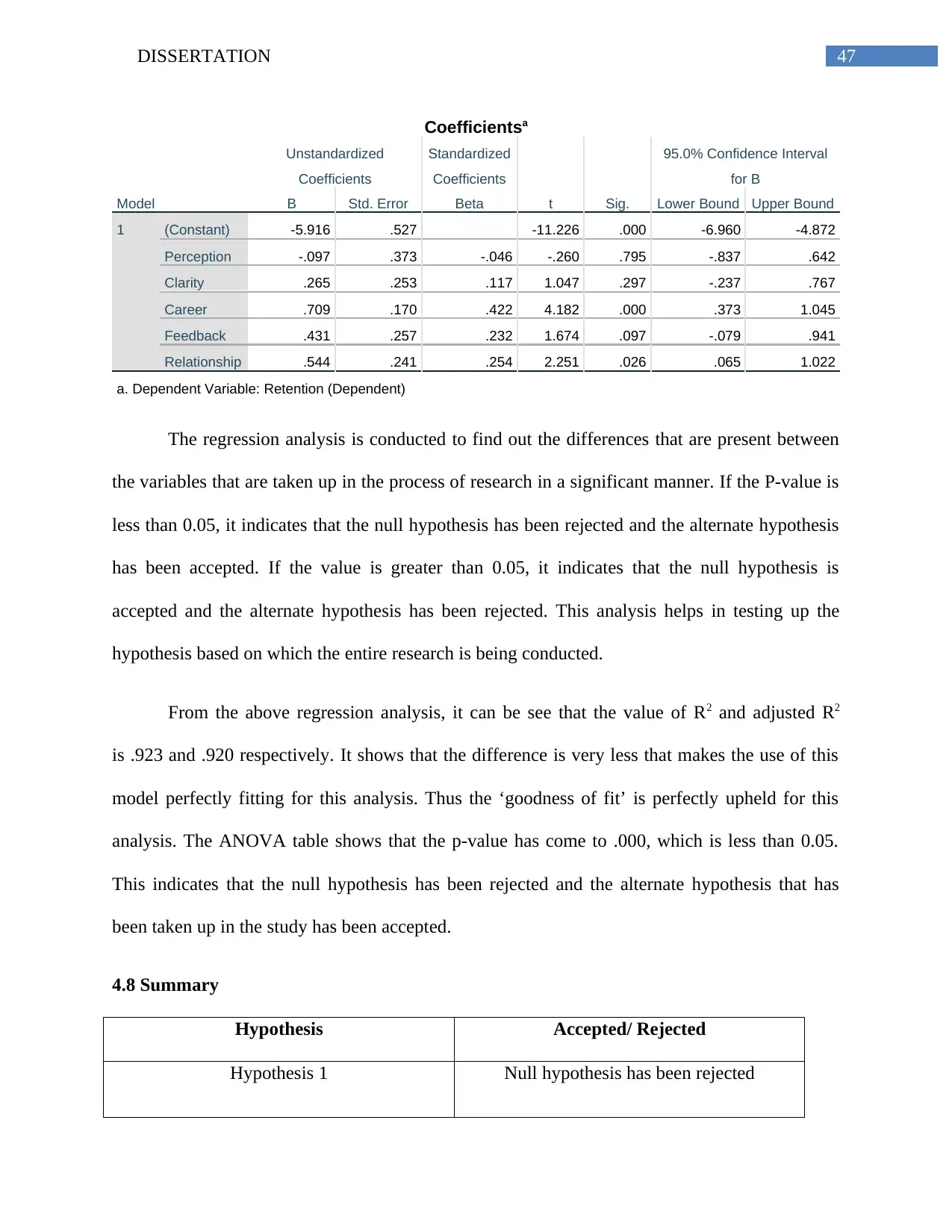
47DISSERTATION
Coefficientsa
Model
Unstandardized
Coefficients
Standardized
Coefficients
t Sig.
95.0% Confidence Interval
for B
B Std. Error Beta Lower Bound Upper Bound
1 (Constant) -5.916 .527 -11.226 .000 -6.960 -4.872
Perception -.097 .373 -.046 -.260 .795 -.837 .642
Clarity .265 .253 .117 1.047 .297 -.237 .767
Career .709 .170 .422 4.182 .000 .373 1.045
Feedback .431 .257 .232 1.674 .097 -.079 .941
Relationship .544 .241 .254 2.251 .026 .065 1.022
a. Dependent Variable: Retention (Dependent)
The regression analysis is conducted to find out the differences that are present between
the variables that are taken up in the process of research in a significant manner. If the P-value is
less than 0.05, it indicates that the null hypothesis has been rejected and the alternate hypothesis
has been accepted. If the value is greater than 0.05, it indicates that the null hypothesis is
accepted and the alternate hypothesis has been rejected. This analysis helps in testing up the
hypothesis based on which the entire research is being conducted.
From the above regression analysis, it can be see that the value of R2 and adjusted R2
is .923 and .920 respectively. It shows that the difference is very less that makes the use of this
model perfectly fitting for this analysis. Thus the ‘goodness of fit’ is perfectly upheld for this
analysis. The ANOVA table shows that the p-value has come to .000, which is less than 0.05.
This indicates that the null hypothesis has been rejected and the alternate hypothesis that has
been taken up in the study has been accepted.
4.8 Summary
Hypothesis Accepted/ Rejected
Hypothesis 1 Null hypothesis has been rejected
Coefficientsa
Model
Unstandardized
Coefficients
Standardized
Coefficients
t Sig.
95.0% Confidence Interval
for B
B Std. Error Beta Lower Bound Upper Bound
1 (Constant) -5.916 .527 -11.226 .000 -6.960 -4.872
Perception -.097 .373 -.046 -.260 .795 -.837 .642
Clarity .265 .253 .117 1.047 .297 -.237 .767
Career .709 .170 .422 4.182 .000 .373 1.045
Feedback .431 .257 .232 1.674 .097 -.079 .941
Relationship .544 .241 .254 2.251 .026 .065 1.022
a. Dependent Variable: Retention (Dependent)
The regression analysis is conducted to find out the differences that are present between
the variables that are taken up in the process of research in a significant manner. If the P-value is
less than 0.05, it indicates that the null hypothesis has been rejected and the alternate hypothesis
has been accepted. If the value is greater than 0.05, it indicates that the null hypothesis is
accepted and the alternate hypothesis has been rejected. This analysis helps in testing up the
hypothesis based on which the entire research is being conducted.
From the above regression analysis, it can be see that the value of R2 and adjusted R2
is .923 and .920 respectively. It shows that the difference is very less that makes the use of this
model perfectly fitting for this analysis. Thus the ‘goodness of fit’ is perfectly upheld for this
analysis. The ANOVA table shows that the p-value has come to .000, which is less than 0.05.
This indicates that the null hypothesis has been rejected and the alternate hypothesis that has
been taken up in the study has been accepted.
4.8 Summary
Hypothesis Accepted/ Rejected
Hypothesis 1 Null hypothesis has been rejected
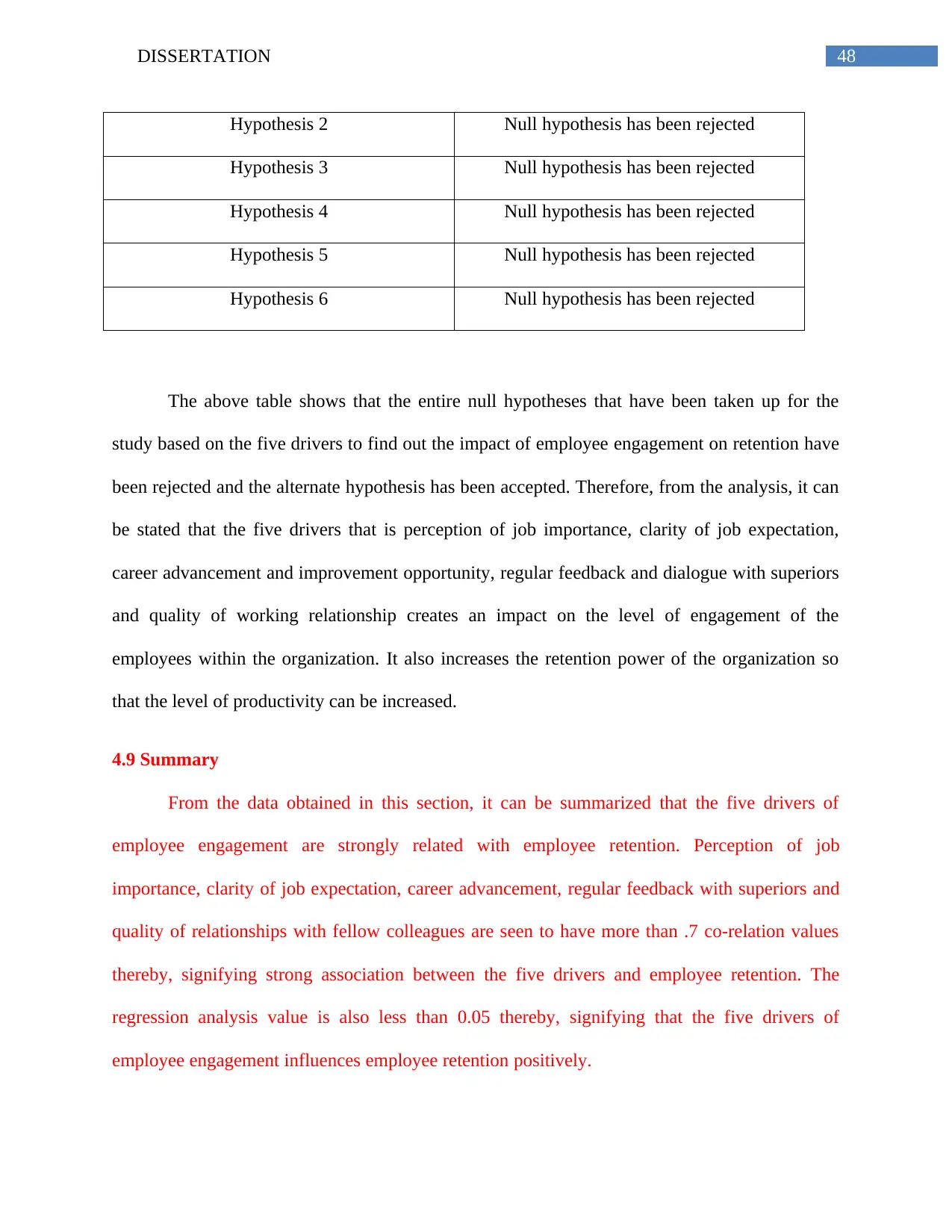
48DISSERTATION
Hypothesis 2 Null hypothesis has been rejected
Hypothesis 3 Null hypothesis has been rejected
Hypothesis 4 Null hypothesis has been rejected
Hypothesis 5 Null hypothesis has been rejected
Hypothesis 6 Null hypothesis has been rejected
The above table shows that the entire null hypotheses that have been taken up for the
study based on the five drivers to find out the impact of employee engagement on retention have
been rejected and the alternate hypothesis has been accepted. Therefore, from the analysis, it can
be stated that the five drivers that is perception of job importance, clarity of job expectation,
career advancement and improvement opportunity, regular feedback and dialogue with superiors
and quality of working relationship creates an impact on the level of engagement of the
employees within the organization. It also increases the retention power of the organization so
that the level of productivity can be increased.
4.9 Summary
From the data obtained in this section, it can be summarized that the five drivers of
employee engagement are strongly related with employee retention. Perception of job
importance, clarity of job expectation, career advancement, regular feedback with superiors and
quality of relationships with fellow colleagues are seen to have more than .7 co-relation values
thereby, signifying strong association between the five drivers and employee retention. The
regression analysis value is also less than 0.05 thereby, signifying that the five drivers of
employee engagement influences employee retention positively.
Hypothesis 2 Null hypothesis has been rejected
Hypothesis 3 Null hypothesis has been rejected
Hypothesis 4 Null hypothesis has been rejected
Hypothesis 5 Null hypothesis has been rejected
Hypothesis 6 Null hypothesis has been rejected
The above table shows that the entire null hypotheses that have been taken up for the
study based on the five drivers to find out the impact of employee engagement on retention have
been rejected and the alternate hypothesis has been accepted. Therefore, from the analysis, it can
be stated that the five drivers that is perception of job importance, clarity of job expectation,
career advancement and improvement opportunity, regular feedback and dialogue with superiors
and quality of working relationship creates an impact on the level of engagement of the
employees within the organization. It also increases the retention power of the organization so
that the level of productivity can be increased.
4.9 Summary
From the data obtained in this section, it can be summarized that the five drivers of
employee engagement are strongly related with employee retention. Perception of job
importance, clarity of job expectation, career advancement, regular feedback with superiors and
quality of relationships with fellow colleagues are seen to have more than .7 co-relation values
thereby, signifying strong association between the five drivers and employee retention. The
regression analysis value is also less than 0.05 thereby, signifying that the five drivers of
employee engagement influences employee retention positively.
Paraphrase This Document
Need a fresh take? Get an instant paraphrase of this document with our AI Paraphraser
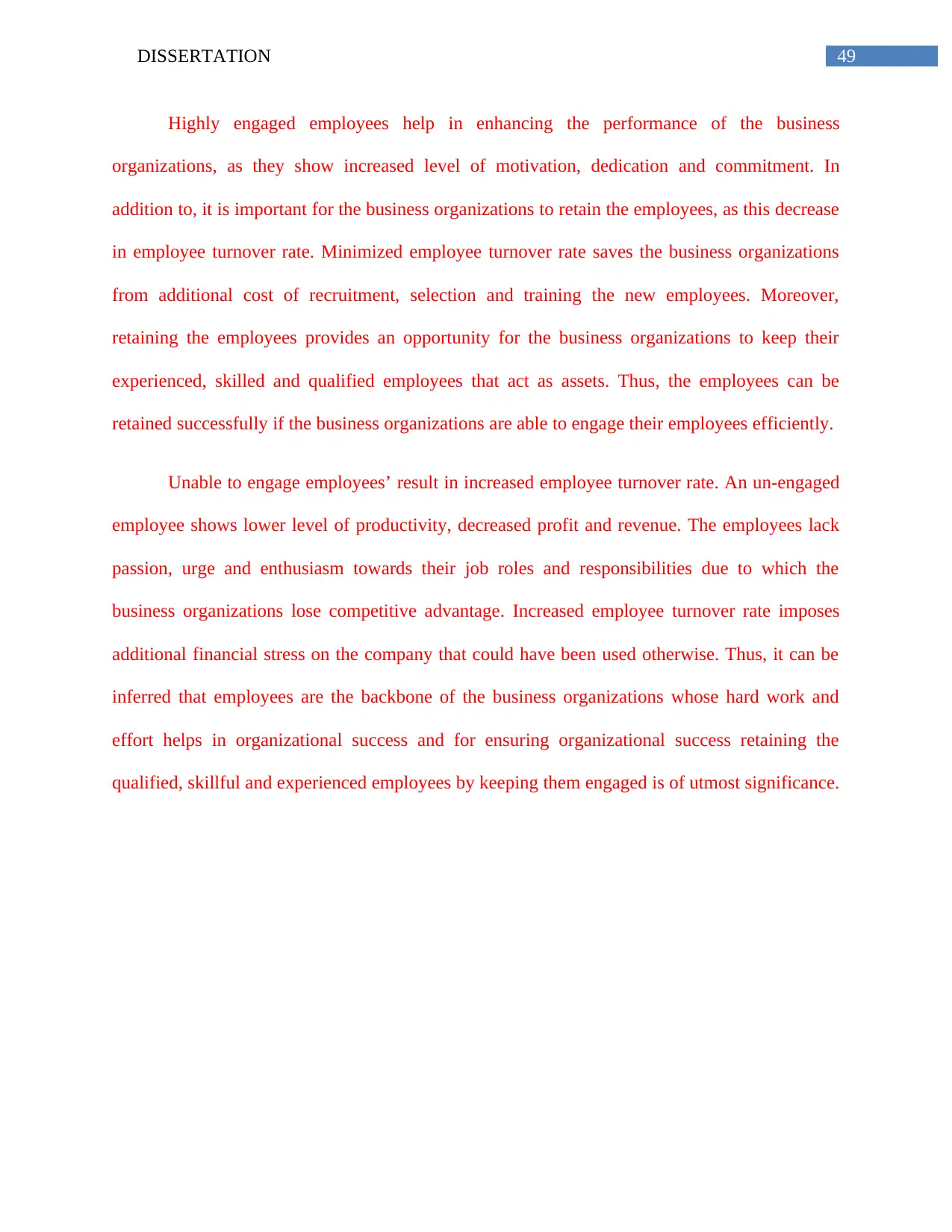
49DISSERTATION
Highly engaged employees help in enhancing the performance of the business
organizations, as they show increased level of motivation, dedication and commitment. In
addition to, it is important for the business organizations to retain the employees, as this decrease
in employee turnover rate. Minimized employee turnover rate saves the business organizations
from additional cost of recruitment, selection and training the new employees. Moreover,
retaining the employees provides an opportunity for the business organizations to keep their
experienced, skilled and qualified employees that act as assets. Thus, the employees can be
retained successfully if the business organizations are able to engage their employees efficiently.
Unable to engage employees’ result in increased employee turnover rate. An un-engaged
employee shows lower level of productivity, decreased profit and revenue. The employees lack
passion, urge and enthusiasm towards their job roles and responsibilities due to which the
business organizations lose competitive advantage. Increased employee turnover rate imposes
additional financial stress on the company that could have been used otherwise. Thus, it can be
inferred that employees are the backbone of the business organizations whose hard work and
effort helps in organizational success and for ensuring organizational success retaining the
qualified, skillful and experienced employees by keeping them engaged is of utmost significance.
Highly engaged employees help in enhancing the performance of the business
organizations, as they show increased level of motivation, dedication and commitment. In
addition to, it is important for the business organizations to retain the employees, as this decrease
in employee turnover rate. Minimized employee turnover rate saves the business organizations
from additional cost of recruitment, selection and training the new employees. Moreover,
retaining the employees provides an opportunity for the business organizations to keep their
experienced, skilled and qualified employees that act as assets. Thus, the employees can be
retained successfully if the business organizations are able to engage their employees efficiently.
Unable to engage employees’ result in increased employee turnover rate. An un-engaged
employee shows lower level of productivity, decreased profit and revenue. The employees lack
passion, urge and enthusiasm towards their job roles and responsibilities due to which the
business organizations lose competitive advantage. Increased employee turnover rate imposes
additional financial stress on the company that could have been used otherwise. Thus, it can be
inferred that employees are the backbone of the business organizations whose hard work and
effort helps in organizational success and for ensuring organizational success retaining the
qualified, skillful and experienced employees by keeping them engaged is of utmost significance.
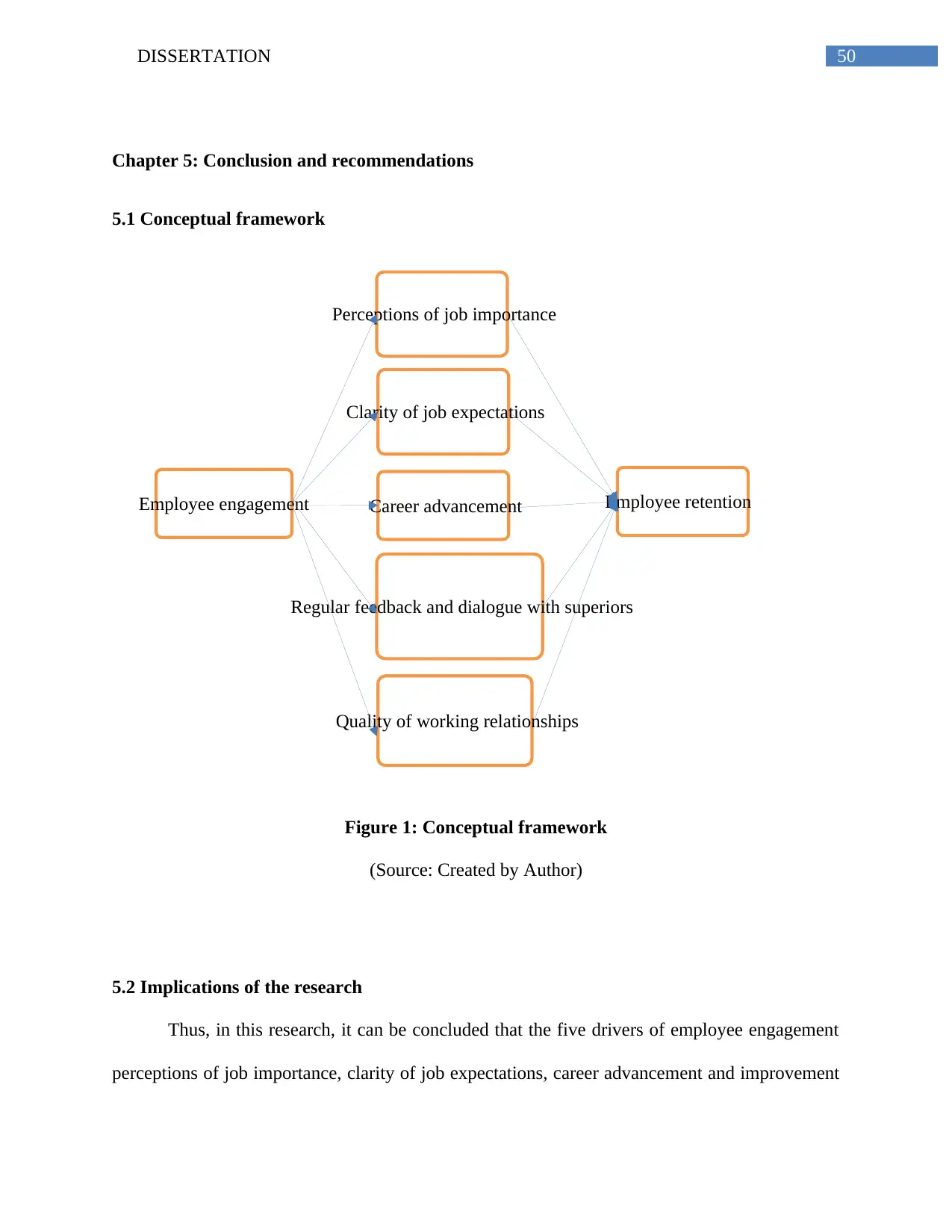
50DISSERTATION
Employee engagement Employee retention
Perceptions of job importance
Clarity of job expectations
Career advancement
Regular feedback and dialogue with superiors
Quality of working relationships
Chapter 5: Conclusion and recommendations
5.1 Conceptual framework
Figure 1: Conceptual framework
(Source: Created by Author)
5.2 Implications of the research
Thus, in this research, it can be concluded that the five drivers of employee engagement
perceptions of job importance, clarity of job expectations, career advancement and improvement
Employee engagement Employee retention
Perceptions of job importance
Clarity of job expectations
Career advancement
Regular feedback and dialogue with superiors
Quality of working relationships
Chapter 5: Conclusion and recommendations
5.1 Conceptual framework
Figure 1: Conceptual framework
(Source: Created by Author)
5.2 Implications of the research
Thus, in this research, it can be concluded that the five drivers of employee engagement
perceptions of job importance, clarity of job expectations, career advancement and improvement
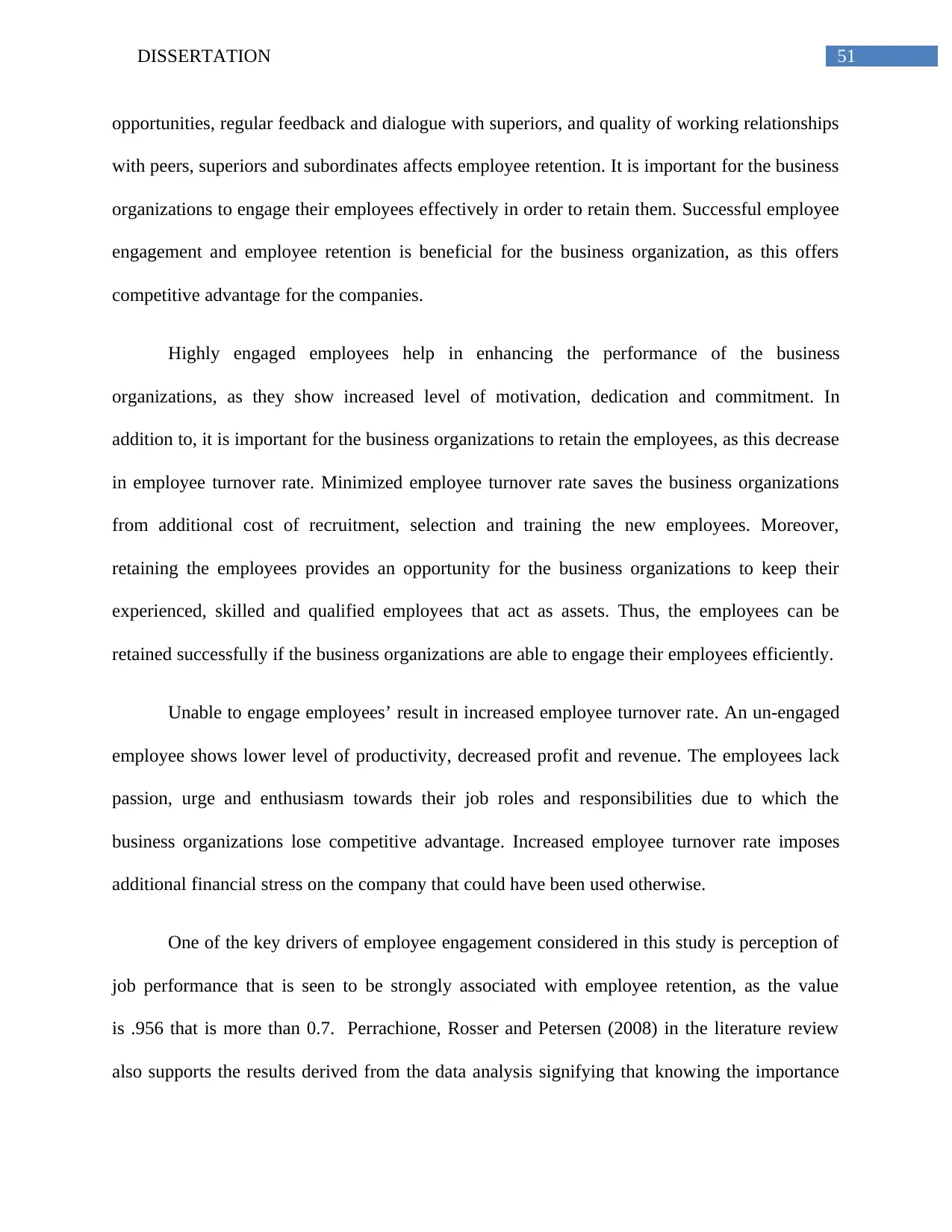
51DISSERTATION
opportunities, regular feedback and dialogue with superiors, and quality of working relationships
with peers, superiors and subordinates affects employee retention. It is important for the business
organizations to engage their employees effectively in order to retain them. Successful employee
engagement and employee retention is beneficial for the business organization, as this offers
competitive advantage for the companies.
Highly engaged employees help in enhancing the performance of the business
organizations, as they show increased level of motivation, dedication and commitment. In
addition to, it is important for the business organizations to retain the employees, as this decrease
in employee turnover rate. Minimized employee turnover rate saves the business organizations
from additional cost of recruitment, selection and training the new employees. Moreover,
retaining the employees provides an opportunity for the business organizations to keep their
experienced, skilled and qualified employees that act as assets. Thus, the employees can be
retained successfully if the business organizations are able to engage their employees efficiently.
Unable to engage employees’ result in increased employee turnover rate. An un-engaged
employee shows lower level of productivity, decreased profit and revenue. The employees lack
passion, urge and enthusiasm towards their job roles and responsibilities due to which the
business organizations lose competitive advantage. Increased employee turnover rate imposes
additional financial stress on the company that could have been used otherwise.
One of the key drivers of employee engagement considered in this study is perception of
job performance that is seen to be strongly associated with employee retention, as the value
is .956 that is more than 0.7. Perrachione, Rosser and Petersen (2008) in the literature review
also supports the results derived from the data analysis signifying that knowing the importance
opportunities, regular feedback and dialogue with superiors, and quality of working relationships
with peers, superiors and subordinates affects employee retention. It is important for the business
organizations to engage their employees effectively in order to retain them. Successful employee
engagement and employee retention is beneficial for the business organization, as this offers
competitive advantage for the companies.
Highly engaged employees help in enhancing the performance of the business
organizations, as they show increased level of motivation, dedication and commitment. In
addition to, it is important for the business organizations to retain the employees, as this decrease
in employee turnover rate. Minimized employee turnover rate saves the business organizations
from additional cost of recruitment, selection and training the new employees. Moreover,
retaining the employees provides an opportunity for the business organizations to keep their
experienced, skilled and qualified employees that act as assets. Thus, the employees can be
retained successfully if the business organizations are able to engage their employees efficiently.
Unable to engage employees’ result in increased employee turnover rate. An un-engaged
employee shows lower level of productivity, decreased profit and revenue. The employees lack
passion, urge and enthusiasm towards their job roles and responsibilities due to which the
business organizations lose competitive advantage. Increased employee turnover rate imposes
additional financial stress on the company that could have been used otherwise.
One of the key drivers of employee engagement considered in this study is perception of
job performance that is seen to be strongly associated with employee retention, as the value
is .956 that is more than 0.7. Perrachione, Rosser and Petersen (2008) in the literature review
also supports the results derived from the data analysis signifying that knowing the importance
Secure Best Marks with AI Grader
Need help grading? Try our AI Grader for instant feedback on your assignments.
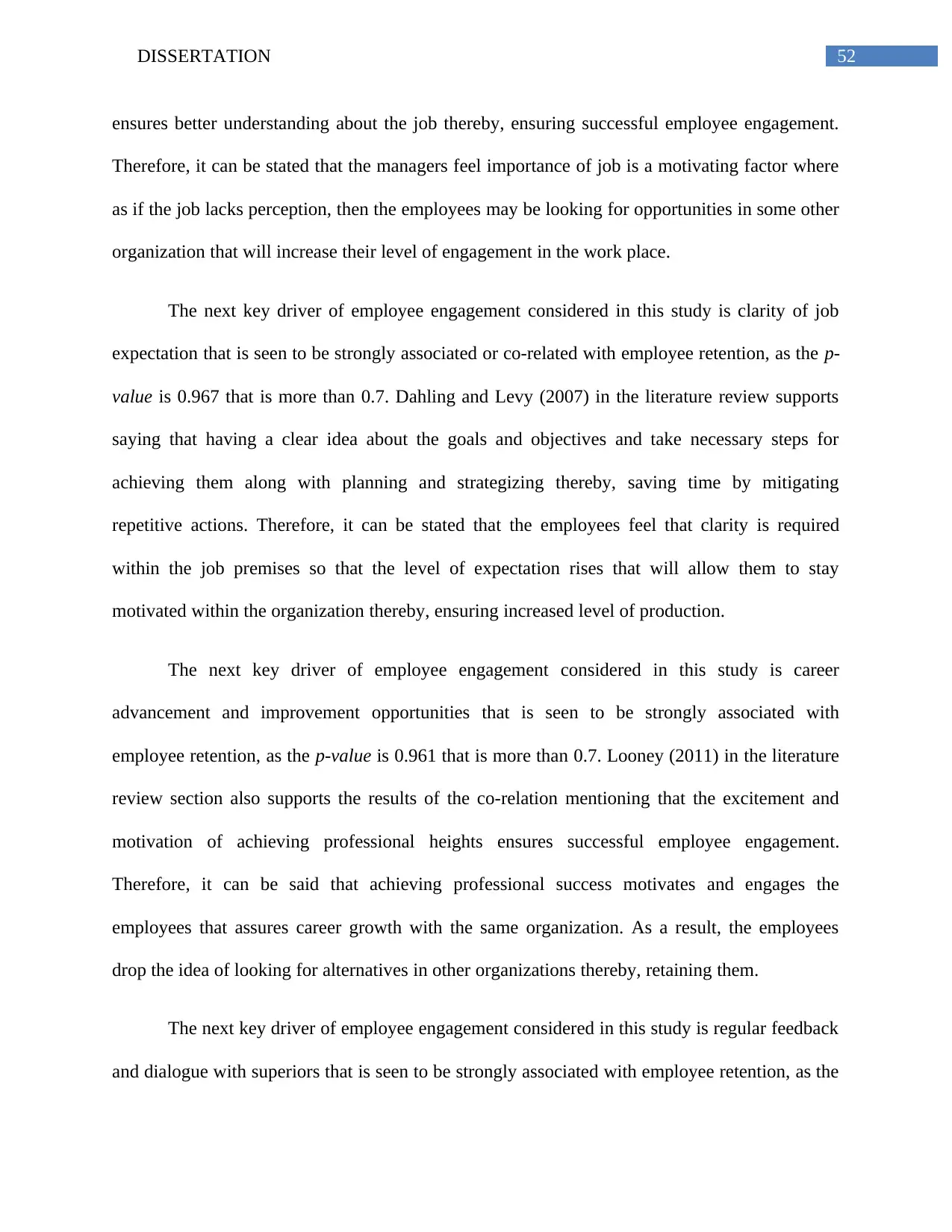
52DISSERTATION
ensures better understanding about the job thereby, ensuring successful employee engagement.
Therefore, it can be stated that the managers feel importance of job is a motivating factor where
as if the job lacks perception, then the employees may be looking for opportunities in some other
organization that will increase their level of engagement in the work place.
The next key driver of employee engagement considered in this study is clarity of job
expectation that is seen to be strongly associated or co-related with employee retention, as the p-
value is 0.967 that is more than 0.7. Dahling and Levy (2007) in the literature review supports
saying that having a clear idea about the goals and objectives and take necessary steps for
achieving them along with planning and strategizing thereby, saving time by mitigating
repetitive actions. Therefore, it can be stated that the employees feel that clarity is required
within the job premises so that the level of expectation rises that will allow them to stay
motivated within the organization thereby, ensuring increased level of production.
The next key driver of employee engagement considered in this study is career
advancement and improvement opportunities that is seen to be strongly associated with
employee retention, as the p-value is 0.961 that is more than 0.7. Looney (2011) in the literature
review section also supports the results of the co-relation mentioning that the excitement and
motivation of achieving professional heights ensures successful employee engagement.
Therefore, it can be said that achieving professional success motivates and engages the
employees that assures career growth with the same organization. As a result, the employees
drop the idea of looking for alternatives in other organizations thereby, retaining them.
The next key driver of employee engagement considered in this study is regular feedback
and dialogue with superiors that is seen to be strongly associated with employee retention, as the
ensures better understanding about the job thereby, ensuring successful employee engagement.
Therefore, it can be stated that the managers feel importance of job is a motivating factor where
as if the job lacks perception, then the employees may be looking for opportunities in some other
organization that will increase their level of engagement in the work place.
The next key driver of employee engagement considered in this study is clarity of job
expectation that is seen to be strongly associated or co-related with employee retention, as the p-
value is 0.967 that is more than 0.7. Dahling and Levy (2007) in the literature review supports
saying that having a clear idea about the goals and objectives and take necessary steps for
achieving them along with planning and strategizing thereby, saving time by mitigating
repetitive actions. Therefore, it can be stated that the employees feel that clarity is required
within the job premises so that the level of expectation rises that will allow them to stay
motivated within the organization thereby, ensuring increased level of production.
The next key driver of employee engagement considered in this study is career
advancement and improvement opportunities that is seen to be strongly associated with
employee retention, as the p-value is 0.961 that is more than 0.7. Looney (2011) in the literature
review section also supports the results of the co-relation mentioning that the excitement and
motivation of achieving professional heights ensures successful employee engagement.
Therefore, it can be said that achieving professional success motivates and engages the
employees that assures career growth with the same organization. As a result, the employees
drop the idea of looking for alternatives in other organizations thereby, retaining them.
The next key driver of employee engagement considered in this study is regular feedback
and dialogue with superiors that is seen to be strongly associated with employee retention, as the
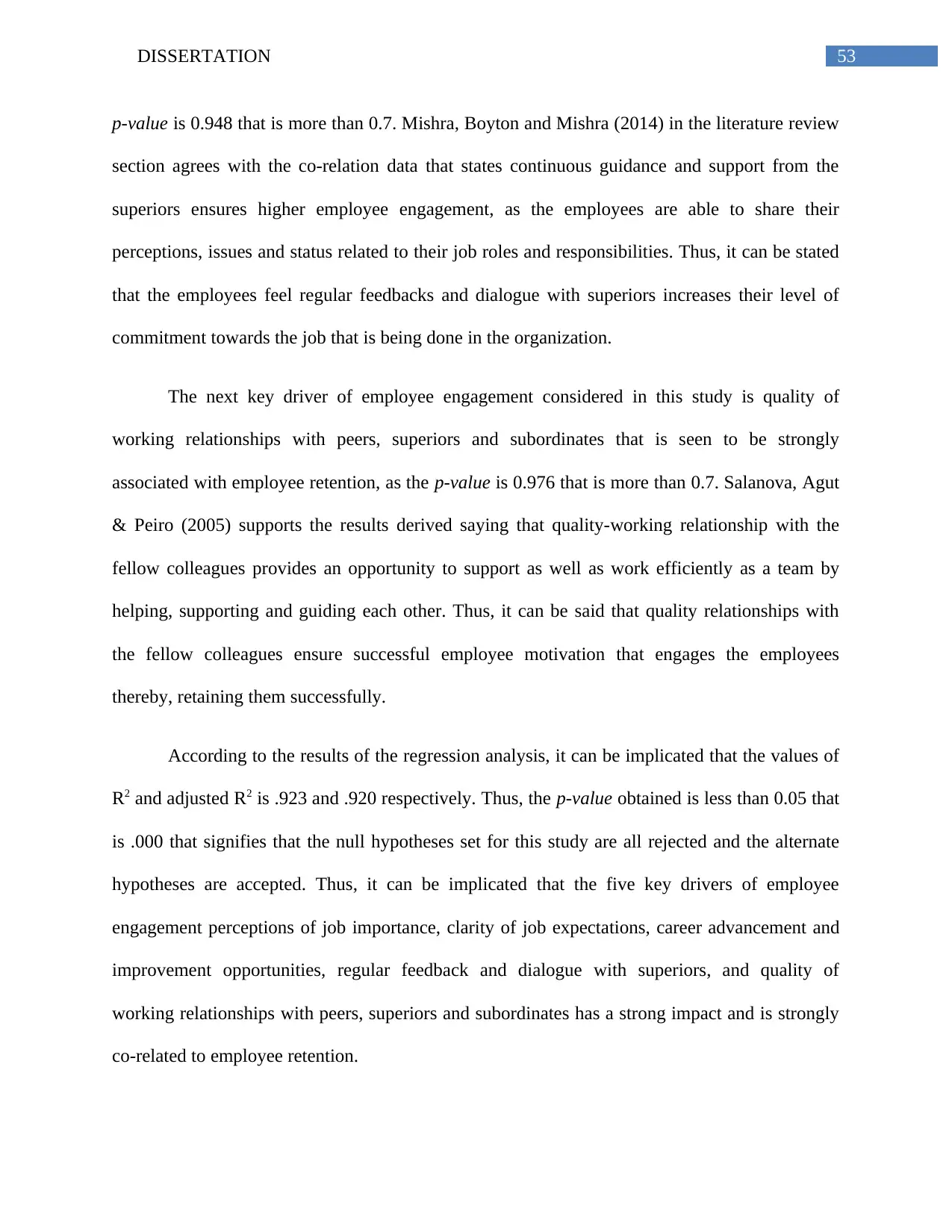
53DISSERTATION
p-value is 0.948 that is more than 0.7. Mishra, Boyton and Mishra (2014) in the literature review
section agrees with the co-relation data that states continuous guidance and support from the
superiors ensures higher employee engagement, as the employees are able to share their
perceptions, issues and status related to their job roles and responsibilities. Thus, it can be stated
that the employees feel regular feedbacks and dialogue with superiors increases their level of
commitment towards the job that is being done in the organization.
The next key driver of employee engagement considered in this study is quality of
working relationships with peers, superiors and subordinates that is seen to be strongly
associated with employee retention, as the p-value is 0.976 that is more than 0.7. Salanova, Agut
& Peiro (2005) supports the results derived saying that quality-working relationship with the
fellow colleagues provides an opportunity to support as well as work efficiently as a team by
helping, supporting and guiding each other. Thus, it can be said that quality relationships with
the fellow colleagues ensure successful employee motivation that engages the employees
thereby, retaining them successfully.
According to the results of the regression analysis, it can be implicated that the values of
R2 and adjusted R2 is .923 and .920 respectively. Thus, the p-value obtained is less than 0.05 that
is .000 that signifies that the null hypotheses set for this study are all rejected and the alternate
hypotheses are accepted. Thus, it can be implicated that the five key drivers of employee
engagement perceptions of job importance, clarity of job expectations, career advancement and
improvement opportunities, regular feedback and dialogue with superiors, and quality of
working relationships with peers, superiors and subordinates has a strong impact and is strongly
co-related to employee retention.
p-value is 0.948 that is more than 0.7. Mishra, Boyton and Mishra (2014) in the literature review
section agrees with the co-relation data that states continuous guidance and support from the
superiors ensures higher employee engagement, as the employees are able to share their
perceptions, issues and status related to their job roles and responsibilities. Thus, it can be stated
that the employees feel regular feedbacks and dialogue with superiors increases their level of
commitment towards the job that is being done in the organization.
The next key driver of employee engagement considered in this study is quality of
working relationships with peers, superiors and subordinates that is seen to be strongly
associated with employee retention, as the p-value is 0.976 that is more than 0.7. Salanova, Agut
& Peiro (2005) supports the results derived saying that quality-working relationship with the
fellow colleagues provides an opportunity to support as well as work efficiently as a team by
helping, supporting and guiding each other. Thus, it can be said that quality relationships with
the fellow colleagues ensure successful employee motivation that engages the employees
thereby, retaining them successfully.
According to the results of the regression analysis, it can be implicated that the values of
R2 and adjusted R2 is .923 and .920 respectively. Thus, the p-value obtained is less than 0.05 that
is .000 that signifies that the null hypotheses set for this study are all rejected and the alternate
hypotheses are accepted. Thus, it can be implicated that the five key drivers of employee
engagement perceptions of job importance, clarity of job expectations, career advancement and
improvement opportunities, regular feedback and dialogue with superiors, and quality of
working relationships with peers, superiors and subordinates has a strong impact and is strongly
co-related to employee retention.
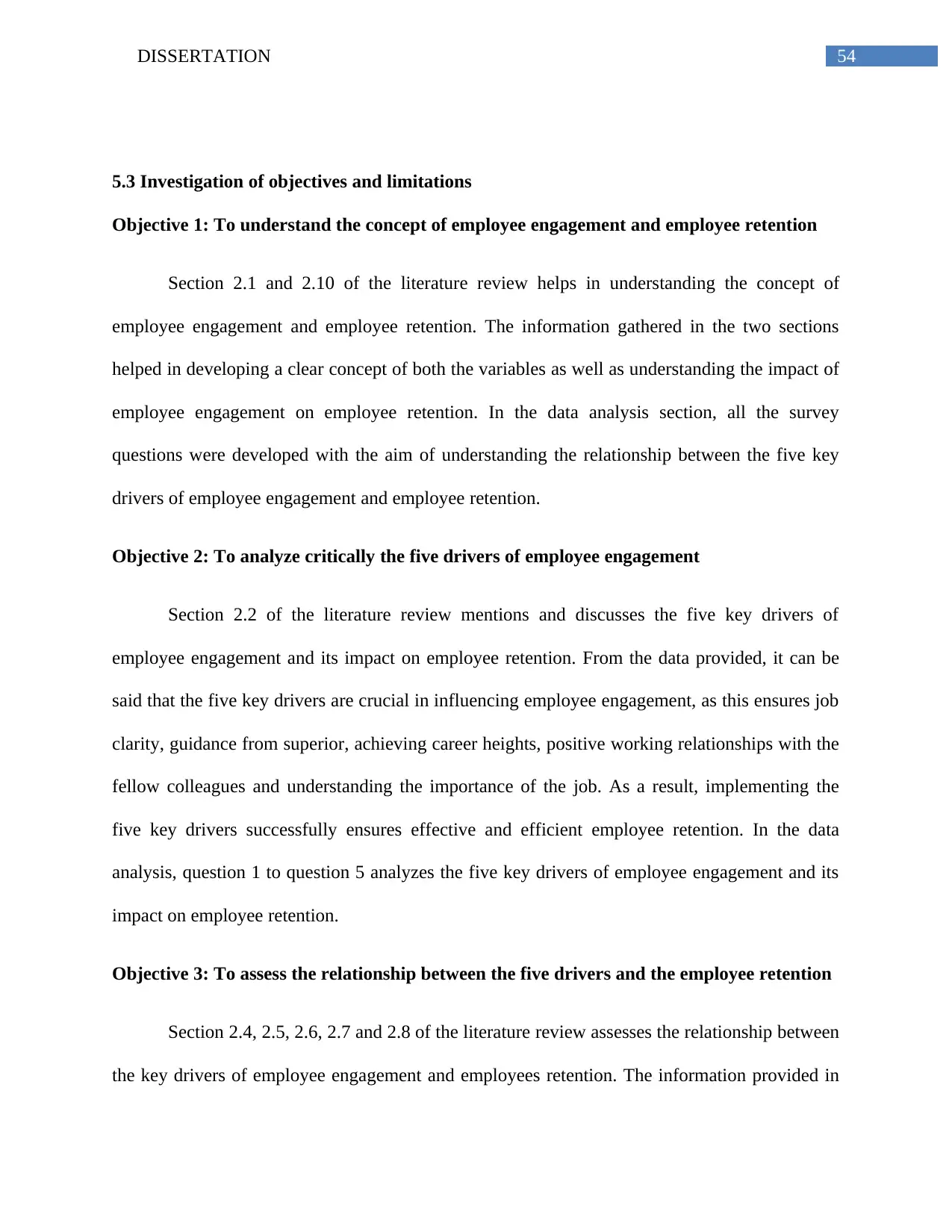
54DISSERTATION
5.3 Investigation of objectives and limitations
Objective 1: To understand the concept of employee engagement and employee retention
Section 2.1 and 2.10 of the literature review helps in understanding the concept of
employee engagement and employee retention. The information gathered in the two sections
helped in developing a clear concept of both the variables as well as understanding the impact of
employee engagement on employee retention. In the data analysis section, all the survey
questions were developed with the aim of understanding the relationship between the five key
drivers of employee engagement and employee retention.
Objective 2: To analyze critically the five drivers of employee engagement
Section 2.2 of the literature review mentions and discusses the five key drivers of
employee engagement and its impact on employee retention. From the data provided, it can be
said that the five key drivers are crucial in influencing employee engagement, as this ensures job
clarity, guidance from superior, achieving career heights, positive working relationships with the
fellow colleagues and understanding the importance of the job. As a result, implementing the
five key drivers successfully ensures effective and efficient employee retention. In the data
analysis, question 1 to question 5 analyzes the five key drivers of employee engagement and its
impact on employee retention.
Objective 3: To assess the relationship between the five drivers and the employee retention
Section 2.4, 2.5, 2.6, 2.7 and 2.8 of the literature review assesses the relationship between
the key drivers of employee engagement and employees retention. The information provided in
5.3 Investigation of objectives and limitations
Objective 1: To understand the concept of employee engagement and employee retention
Section 2.1 and 2.10 of the literature review helps in understanding the concept of
employee engagement and employee retention. The information gathered in the two sections
helped in developing a clear concept of both the variables as well as understanding the impact of
employee engagement on employee retention. In the data analysis section, all the survey
questions were developed with the aim of understanding the relationship between the five key
drivers of employee engagement and employee retention.
Objective 2: To analyze critically the five drivers of employee engagement
Section 2.2 of the literature review mentions and discusses the five key drivers of
employee engagement and its impact on employee retention. From the data provided, it can be
said that the five key drivers are crucial in influencing employee engagement, as this ensures job
clarity, guidance from superior, achieving career heights, positive working relationships with the
fellow colleagues and understanding the importance of the job. As a result, implementing the
five key drivers successfully ensures effective and efficient employee retention. In the data
analysis, question 1 to question 5 analyzes the five key drivers of employee engagement and its
impact on employee retention.
Objective 3: To assess the relationship between the five drivers and the employee retention
Section 2.4, 2.5, 2.6, 2.7 and 2.8 of the literature review assesses the relationship between
the key drivers of employee engagement and employees retention. The information provided in
Paraphrase This Document
Need a fresh take? Get an instant paraphrase of this document with our AI Paraphraser
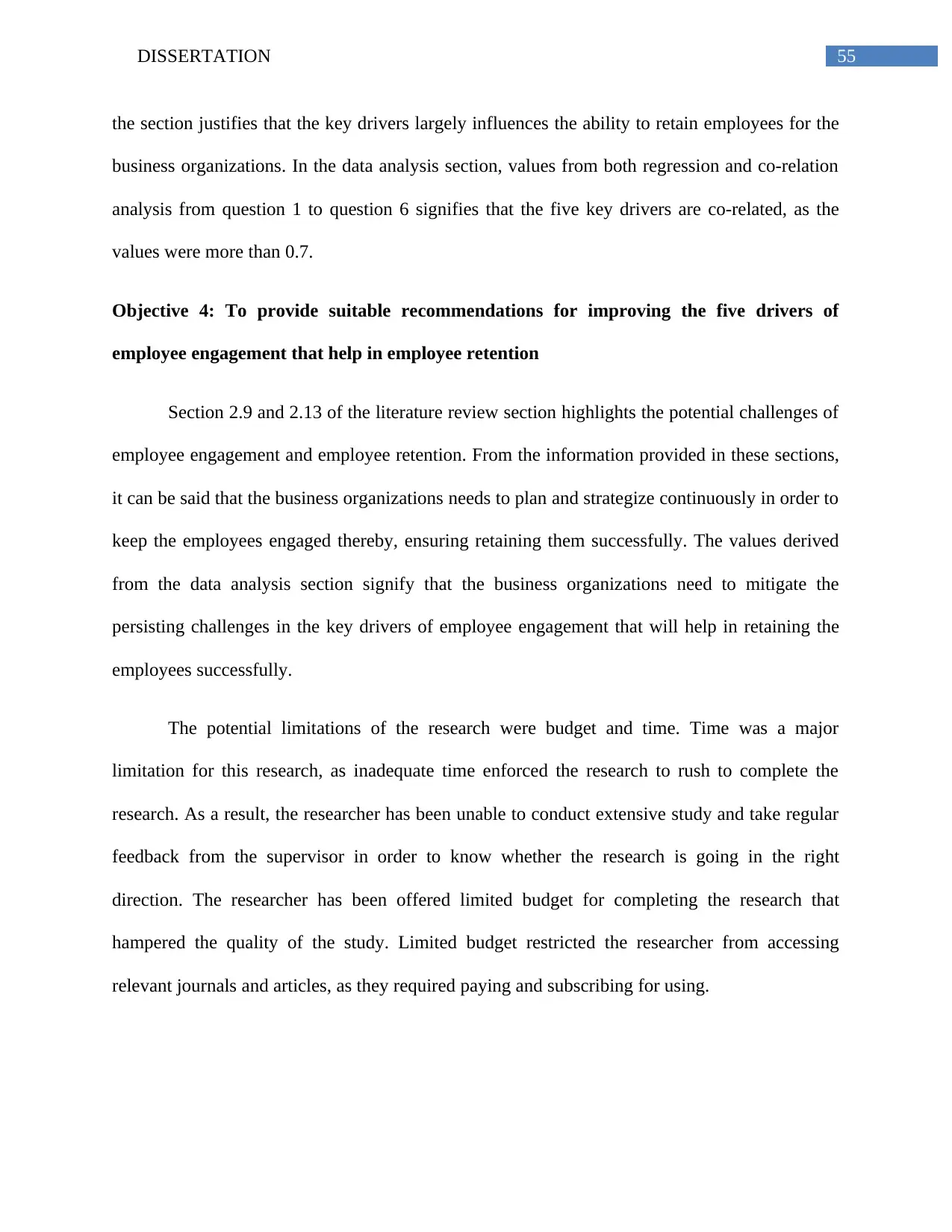
55DISSERTATION
the section justifies that the key drivers largely influences the ability to retain employees for the
business organizations. In the data analysis section, values from both regression and co-relation
analysis from question 1 to question 6 signifies that the five key drivers are co-related, as the
values were more than 0.7.
Objective 4: To provide suitable recommendations for improving the five drivers of
employee engagement that help in employee retention
Section 2.9 and 2.13 of the literature review section highlights the potential challenges of
employee engagement and employee retention. From the information provided in these sections,
it can be said that the business organizations needs to plan and strategize continuously in order to
keep the employees engaged thereby, ensuring retaining them successfully. The values derived
from the data analysis section signify that the business organizations need to mitigate the
persisting challenges in the key drivers of employee engagement that will help in retaining the
employees successfully.
The potential limitations of the research were budget and time. Time was a major
limitation for this research, as inadequate time enforced the research to rush to complete the
research. As a result, the researcher has been unable to conduct extensive study and take regular
feedback from the supervisor in order to know whether the research is going in the right
direction. The researcher has been offered limited budget for completing the research that
hampered the quality of the study. Limited budget restricted the researcher from accessing
relevant journals and articles, as they required paying and subscribing for using.
the section justifies that the key drivers largely influences the ability to retain employees for the
business organizations. In the data analysis section, values from both regression and co-relation
analysis from question 1 to question 6 signifies that the five key drivers are co-related, as the
values were more than 0.7.
Objective 4: To provide suitable recommendations for improving the five drivers of
employee engagement that help in employee retention
Section 2.9 and 2.13 of the literature review section highlights the potential challenges of
employee engagement and employee retention. From the information provided in these sections,
it can be said that the business organizations needs to plan and strategize continuously in order to
keep the employees engaged thereby, ensuring retaining them successfully. The values derived
from the data analysis section signify that the business organizations need to mitigate the
persisting challenges in the key drivers of employee engagement that will help in retaining the
employees successfully.
The potential limitations of the research were budget and time. Time was a major
limitation for this research, as inadequate time enforced the research to rush to complete the
research. As a result, the researcher has been unable to conduct extensive study and take regular
feedback from the supervisor in order to know whether the research is going in the right
direction. The researcher has been offered limited budget for completing the research that
hampered the quality of the study. Limited budget restricted the researcher from accessing
relevant journals and articles, as they required paying and subscribing for using.
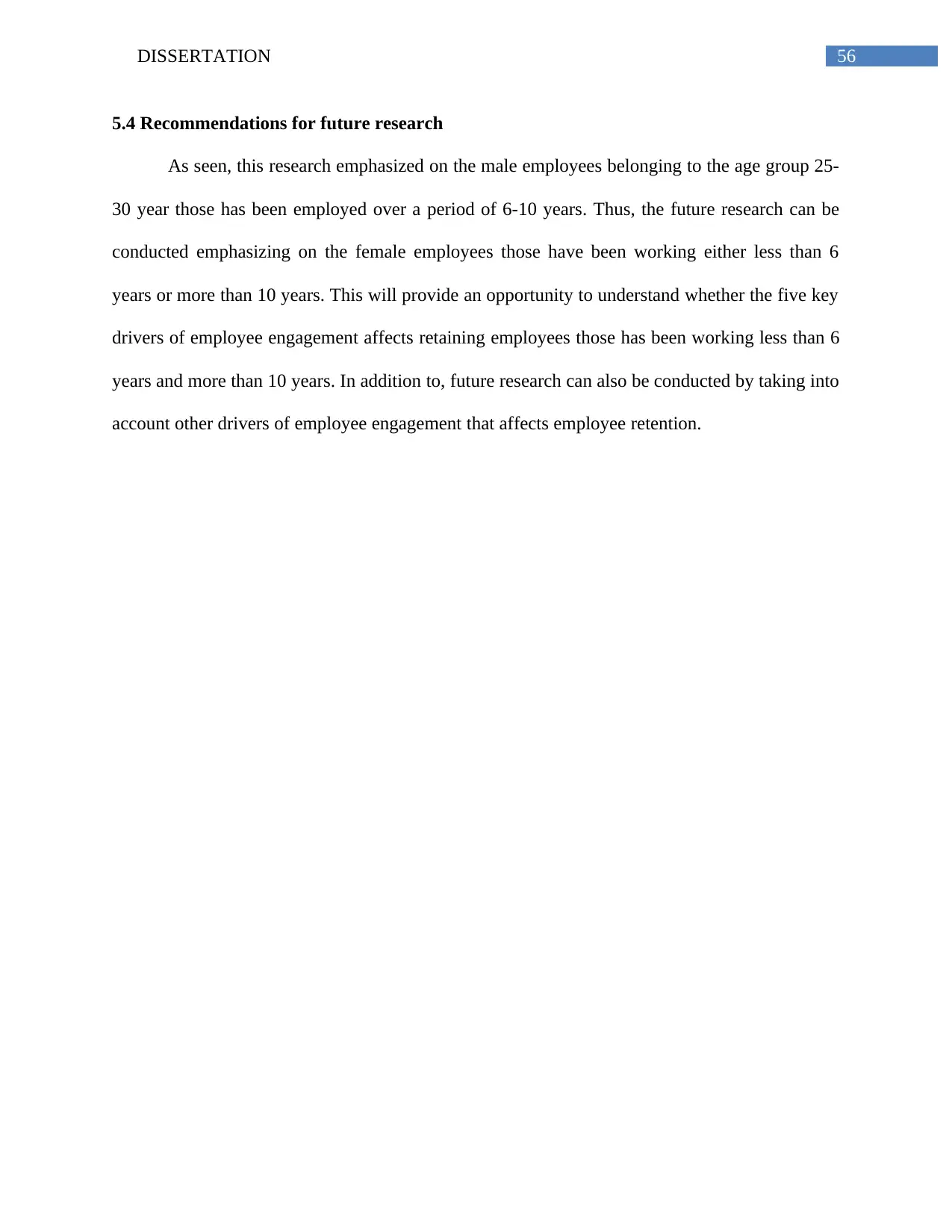
56DISSERTATION
5.4 Recommendations for future research
As seen, this research emphasized on the male employees belonging to the age group 25-
30 year those has been employed over a period of 6-10 years. Thus, the future research can be
conducted emphasizing on the female employees those have been working either less than 6
years or more than 10 years. This will provide an opportunity to understand whether the five key
drivers of employee engagement affects retaining employees those has been working less than 6
years and more than 10 years. In addition to, future research can also be conducted by taking into
account other drivers of employee engagement that affects employee retention.
5.4 Recommendations for future research
As seen, this research emphasized on the male employees belonging to the age group 25-
30 year those has been employed over a period of 6-10 years. Thus, the future research can be
conducted emphasizing on the female employees those have been working either less than 6
years or more than 10 years. This will provide an opportunity to understand whether the five key
drivers of employee engagement affects retaining employees those has been working less than 6
years and more than 10 years. In addition to, future research can also be conducted by taking into
account other drivers of employee engagement that affects employee retention.
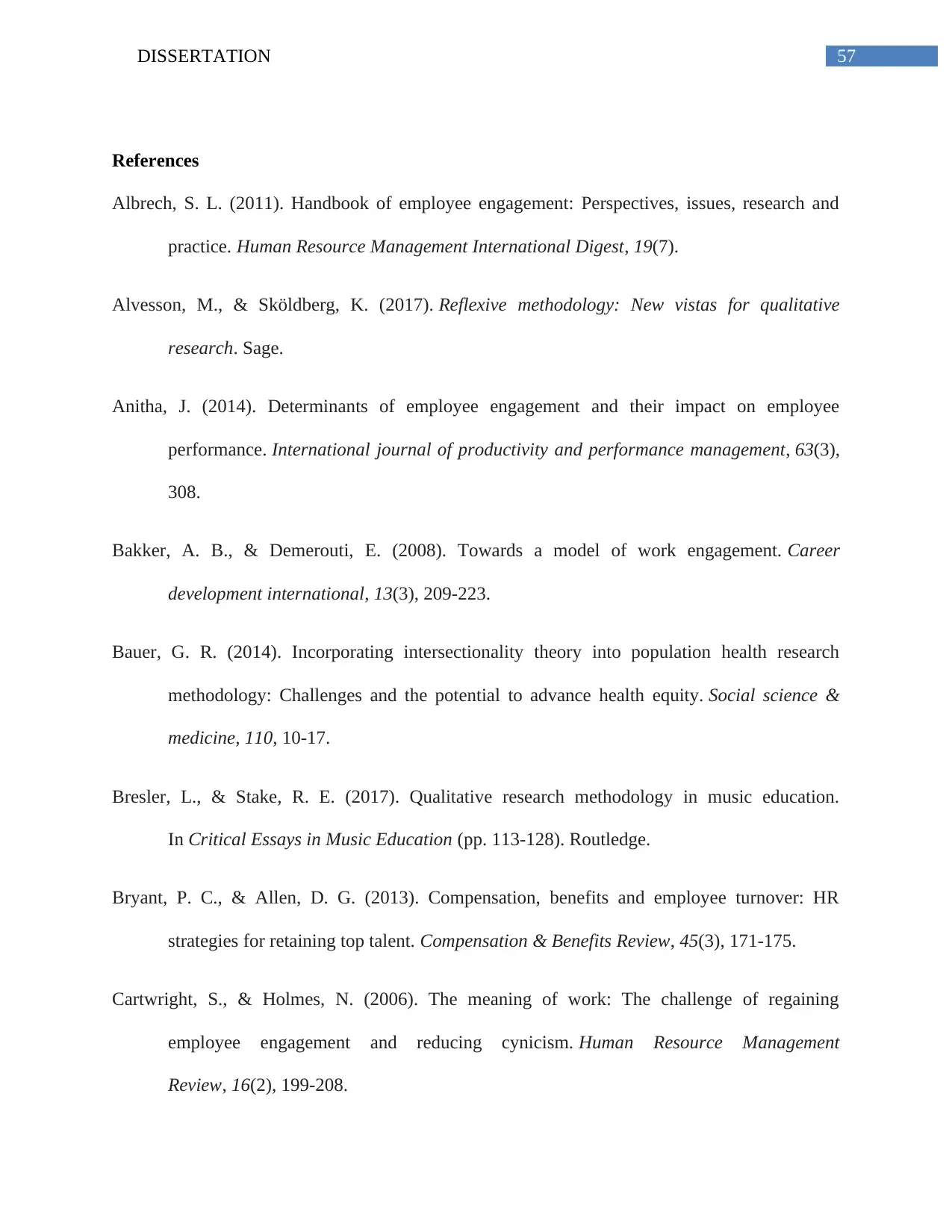
57DISSERTATION
References
Albrech, S. L. (2011). Handbook of employee engagement: Perspectives, issues, research and
practice. Human Resource Management International Digest, 19(7).
Alvesson, M., & Sköldberg, K. (2017). Reflexive methodology: New vistas for qualitative
research. Sage.
Anitha, J. (2014). Determinants of employee engagement and their impact on employee
performance. International journal of productivity and performance management, 63(3),
308.
Bakker, A. B., & Demerouti, E. (2008). Towards a model of work engagement. Career
development international, 13(3), 209-223.
Bauer, G. R. (2014). Incorporating intersectionality theory into population health research
methodology: Challenges and the potential to advance health equity. Social science &
medicine, 110, 10-17.
Bresler, L., & Stake, R. E. (2017). Qualitative research methodology in music education.
In Critical Essays in Music Education (pp. 113-128). Routledge.
Bryant, P. C., & Allen, D. G. (2013). Compensation, benefits and employee turnover: HR
strategies for retaining top talent. Compensation & Benefits Review, 45(3), 171-175.
Cartwright, S., & Holmes, N. (2006). The meaning of work: The challenge of regaining
employee engagement and reducing cynicism. Human Resource Management
Review, 16(2), 199-208.
References
Albrech, S. L. (2011). Handbook of employee engagement: Perspectives, issues, research and
practice. Human Resource Management International Digest, 19(7).
Alvesson, M., & Sköldberg, K. (2017). Reflexive methodology: New vistas for qualitative
research. Sage.
Anitha, J. (2014). Determinants of employee engagement and their impact on employee
performance. International journal of productivity and performance management, 63(3),
308.
Bakker, A. B., & Demerouti, E. (2008). Towards a model of work engagement. Career
development international, 13(3), 209-223.
Bauer, G. R. (2014). Incorporating intersectionality theory into population health research
methodology: Challenges and the potential to advance health equity. Social science &
medicine, 110, 10-17.
Bresler, L., & Stake, R. E. (2017). Qualitative research methodology in music education.
In Critical Essays in Music Education (pp. 113-128). Routledge.
Bryant, P. C., & Allen, D. G. (2013). Compensation, benefits and employee turnover: HR
strategies for retaining top talent. Compensation & Benefits Review, 45(3), 171-175.
Cartwright, S., & Holmes, N. (2006). The meaning of work: The challenge of regaining
employee engagement and reducing cynicism. Human Resource Management
Review, 16(2), 199-208.
Secure Best Marks with AI Grader
Need help grading? Try our AI Grader for instant feedback on your assignments.
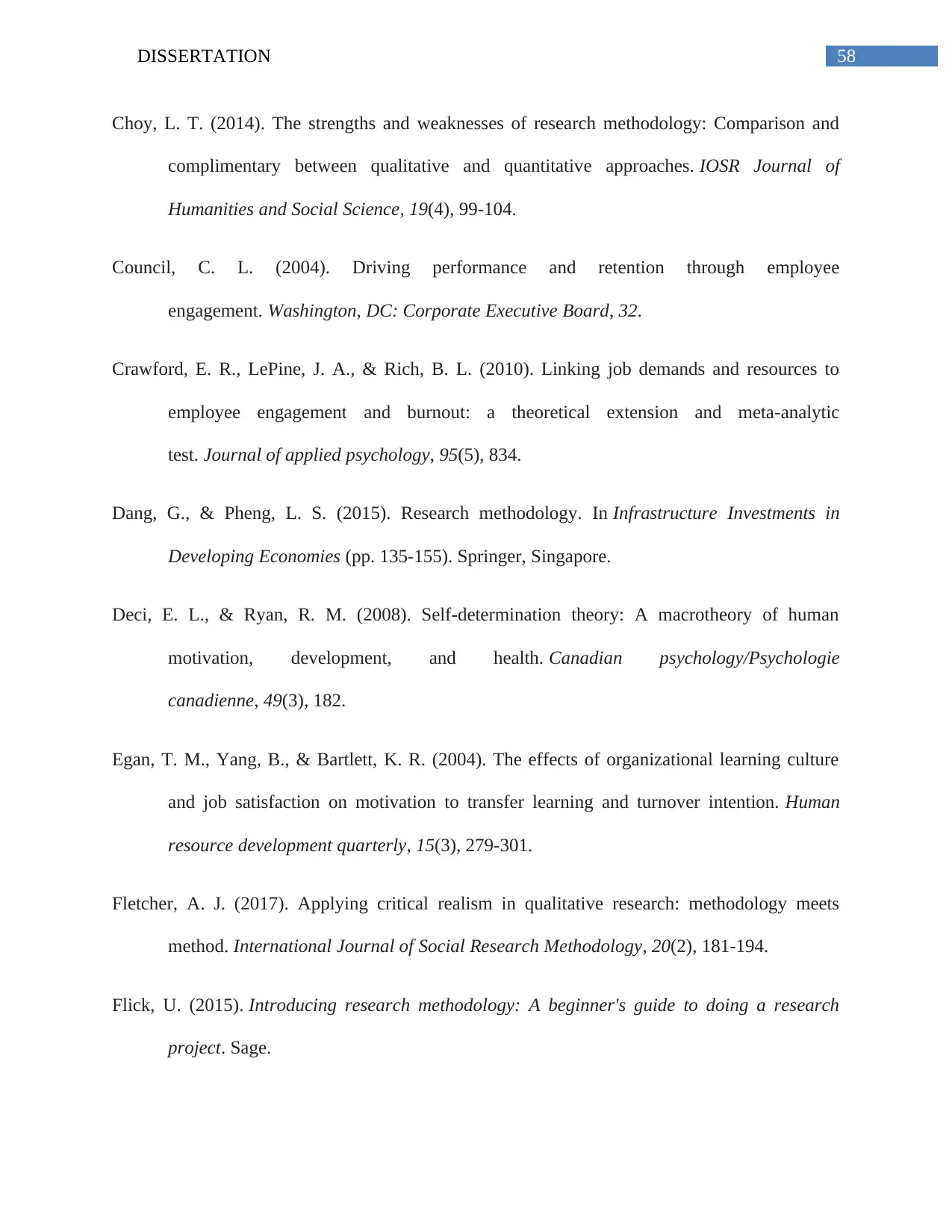
58DISSERTATION
Choy, L. T. (2014). The strengths and weaknesses of research methodology: Comparison and
complimentary between qualitative and quantitative approaches. IOSR Journal of
Humanities and Social Science, 19(4), 99-104.
Council, C. L. (2004). Driving performance and retention through employee
engagement. Washington, DC: Corporate Executive Board, 32.
Crawford, E. R., LePine, J. A., & Rich, B. L. (2010). Linking job demands and resources to
employee engagement and burnout: a theoretical extension and meta-analytic
test. Journal of applied psychology, 95(5), 834.
Dang, G., & Pheng, L. S. (2015). Research methodology. In Infrastructure Investments in
Developing Economies (pp. 135-155). Springer, Singapore.
Deci, E. L., & Ryan, R. M. (2008). Self-determination theory: A macrotheory of human
motivation, development, and health. Canadian psychology/Psychologie
canadienne, 49(3), 182.
Egan, T. M., Yang, B., & Bartlett, K. R. (2004). The effects of organizational learning culture
and job satisfaction on motivation to transfer learning and turnover intention. Human
resource development quarterly, 15(3), 279-301.
Fletcher, A. J. (2017). Applying critical realism in qualitative research: methodology meets
method. International Journal of Social Research Methodology, 20(2), 181-194.
Flick, U. (2015). Introducing research methodology: A beginner's guide to doing a research
project. Sage.
Choy, L. T. (2014). The strengths and weaknesses of research methodology: Comparison and
complimentary between qualitative and quantitative approaches. IOSR Journal of
Humanities and Social Science, 19(4), 99-104.
Council, C. L. (2004). Driving performance and retention through employee
engagement. Washington, DC: Corporate Executive Board, 32.
Crawford, E. R., LePine, J. A., & Rich, B. L. (2010). Linking job demands and resources to
employee engagement and burnout: a theoretical extension and meta-analytic
test. Journal of applied psychology, 95(5), 834.
Dang, G., & Pheng, L. S. (2015). Research methodology. In Infrastructure Investments in
Developing Economies (pp. 135-155). Springer, Singapore.
Deci, E. L., & Ryan, R. M. (2008). Self-determination theory: A macrotheory of human
motivation, development, and health. Canadian psychology/Psychologie
canadienne, 49(3), 182.
Egan, T. M., Yang, B., & Bartlett, K. R. (2004). The effects of organizational learning culture
and job satisfaction on motivation to transfer learning and turnover intention. Human
resource development quarterly, 15(3), 279-301.
Fletcher, A. J. (2017). Applying critical realism in qualitative research: methodology meets
method. International Journal of Social Research Methodology, 20(2), 181-194.
Flick, U. (2015). Introducing research methodology: A beginner's guide to doing a research
project. Sage.
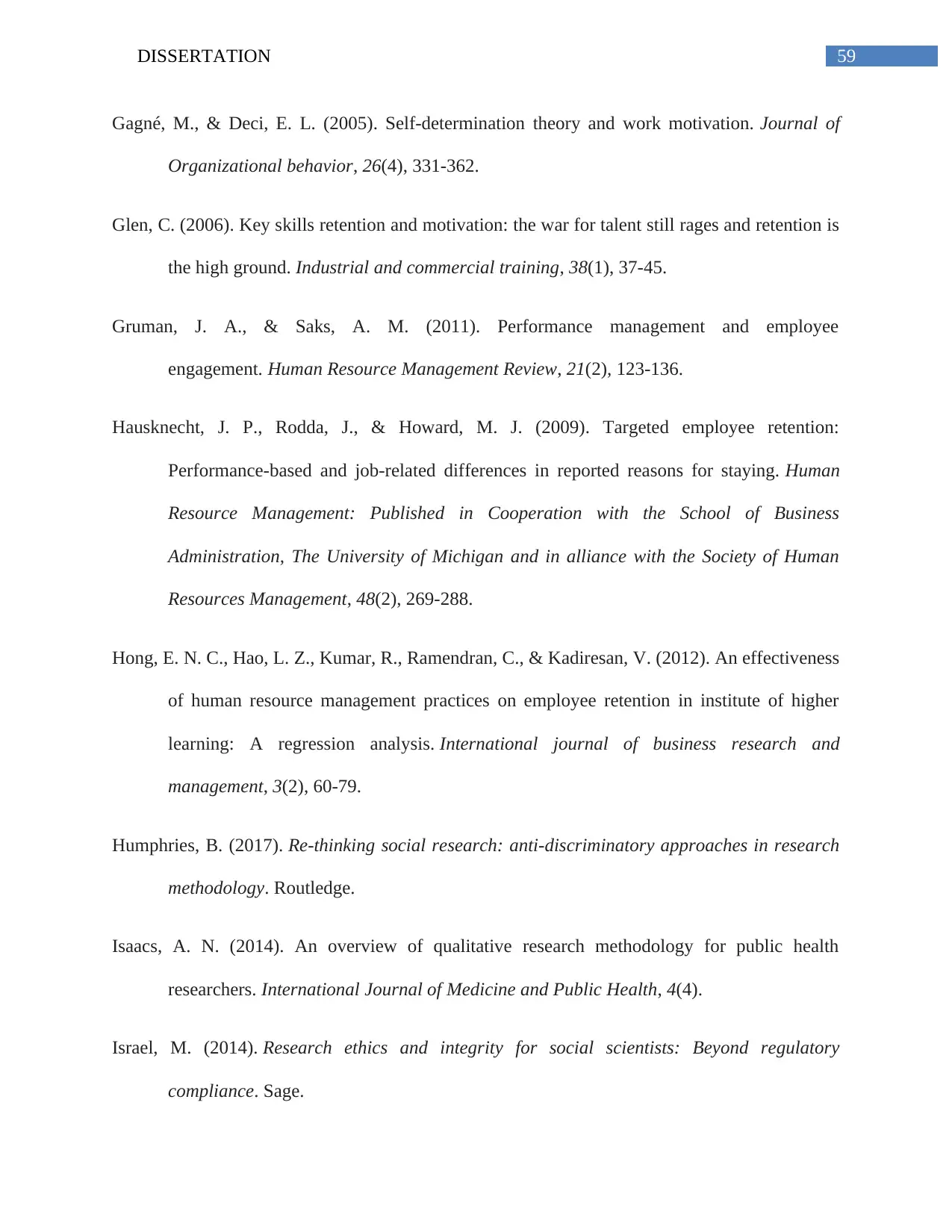
59DISSERTATION
Gagné, M., & Deci, E. L. (2005). Self‐determination theory and work motivation. Journal of
Organizational behavior, 26(4), 331-362.
Glen, C. (2006). Key skills retention and motivation: the war for talent still rages and retention is
the high ground. Industrial and commercial training, 38(1), 37-45.
Gruman, J. A., & Saks, A. M. (2011). Performance management and employee
engagement. Human Resource Management Review, 21(2), 123-136.
Hausknecht, J. P., Rodda, J., & Howard, M. J. (2009). Targeted employee retention:
Performance‐based and job‐related differences in reported reasons for staying. Human
Resource Management: Published in Cooperation with the School of Business
Administration, The University of Michigan and in alliance with the Society of Human
Resources Management, 48(2), 269-288.
Hong, E. N. C., Hao, L. Z., Kumar, R., Ramendran, C., & Kadiresan, V. (2012). An effectiveness
of human resource management practices on employee retention in institute of higher
learning: A regression analysis. International journal of business research and
management, 3(2), 60-79.
Humphries, B. (2017). Re-thinking social research: anti-discriminatory approaches in research
methodology. Routledge.
Isaacs, A. N. (2014). An overview of qualitative research methodology for public health
researchers. International Journal of Medicine and Public Health, 4(4).
Israel, M. (2014). Research ethics and integrity for social scientists: Beyond regulatory
compliance. Sage.
Gagné, M., & Deci, E. L. (2005). Self‐determination theory and work motivation. Journal of
Organizational behavior, 26(4), 331-362.
Glen, C. (2006). Key skills retention and motivation: the war for talent still rages and retention is
the high ground. Industrial and commercial training, 38(1), 37-45.
Gruman, J. A., & Saks, A. M. (2011). Performance management and employee
engagement. Human Resource Management Review, 21(2), 123-136.
Hausknecht, J. P., Rodda, J., & Howard, M. J. (2009). Targeted employee retention:
Performance‐based and job‐related differences in reported reasons for staying. Human
Resource Management: Published in Cooperation with the School of Business
Administration, The University of Michigan and in alliance with the Society of Human
Resources Management, 48(2), 269-288.
Hong, E. N. C., Hao, L. Z., Kumar, R., Ramendran, C., & Kadiresan, V. (2012). An effectiveness
of human resource management practices on employee retention in institute of higher
learning: A regression analysis. International journal of business research and
management, 3(2), 60-79.
Humphries, B. (2017). Re-thinking social research: anti-discriminatory approaches in research
methodology. Routledge.
Isaacs, A. N. (2014). An overview of qualitative research methodology for public health
researchers. International Journal of Medicine and Public Health, 4(4).
Israel, M. (2014). Research ethics and integrity for social scientists: Beyond regulatory
compliance. Sage.
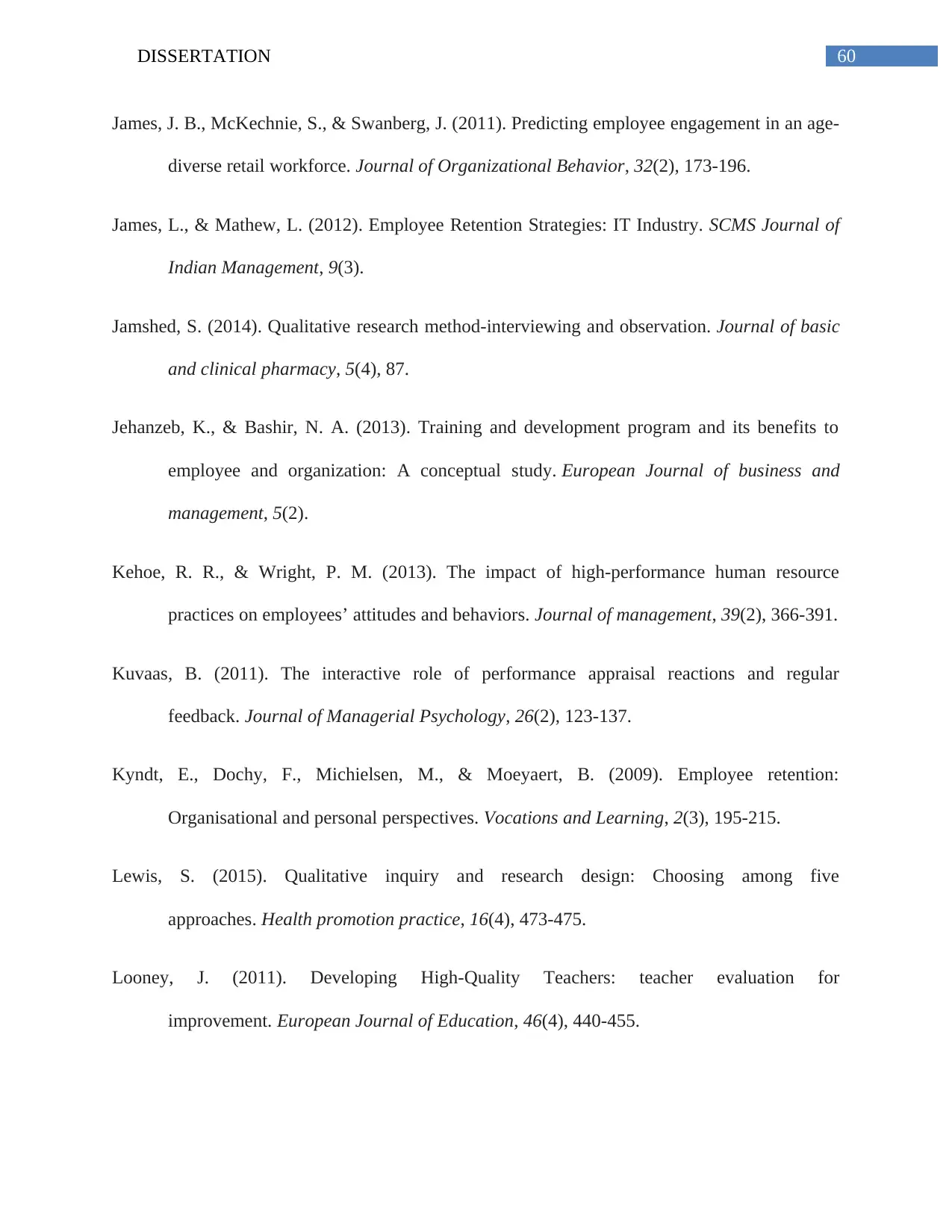
60DISSERTATION
James, J. B., McKechnie, S., & Swanberg, J. (2011). Predicting employee engagement in an age‐
diverse retail workforce. Journal of Organizational Behavior, 32(2), 173-196.
James, L., & Mathew, L. (2012). Employee Retention Strategies: IT Industry. SCMS Journal of
Indian Management, 9(3).
Jamshed, S. (2014). Qualitative research method-interviewing and observation. Journal of basic
and clinical pharmacy, 5(4), 87.
Jehanzeb, K., & Bashir, N. A. (2013). Training and development program and its benefits to
employee and organization: A conceptual study. European Journal of business and
management, 5(2).
Kehoe, R. R., & Wright, P. M. (2013). The impact of high-performance human resource
practices on employees’ attitudes and behaviors. Journal of management, 39(2), 366-391.
Kuvaas, B. (2011). The interactive role of performance appraisal reactions and regular
feedback. Journal of Managerial Psychology, 26(2), 123-137.
Kyndt, E., Dochy, F., Michielsen, M., & Moeyaert, B. (2009). Employee retention:
Organisational and personal perspectives. Vocations and Learning, 2(3), 195-215.
Lewis, S. (2015). Qualitative inquiry and research design: Choosing among five
approaches. Health promotion practice, 16(4), 473-475.
Looney, J. (2011). Developing High‐Quality Teachers: teacher evaluation for
improvement. European Journal of Education, 46(4), 440-455.
James, J. B., McKechnie, S., & Swanberg, J. (2011). Predicting employee engagement in an age‐
diverse retail workforce. Journal of Organizational Behavior, 32(2), 173-196.
James, L., & Mathew, L. (2012). Employee Retention Strategies: IT Industry. SCMS Journal of
Indian Management, 9(3).
Jamshed, S. (2014). Qualitative research method-interviewing and observation. Journal of basic
and clinical pharmacy, 5(4), 87.
Jehanzeb, K., & Bashir, N. A. (2013). Training and development program and its benefits to
employee and organization: A conceptual study. European Journal of business and
management, 5(2).
Kehoe, R. R., & Wright, P. M. (2013). The impact of high-performance human resource
practices on employees’ attitudes and behaviors. Journal of management, 39(2), 366-391.
Kuvaas, B. (2011). The interactive role of performance appraisal reactions and regular
feedback. Journal of Managerial Psychology, 26(2), 123-137.
Kyndt, E., Dochy, F., Michielsen, M., & Moeyaert, B. (2009). Employee retention:
Organisational and personal perspectives. Vocations and Learning, 2(3), 195-215.
Lewis, S. (2015). Qualitative inquiry and research design: Choosing among five
approaches. Health promotion practice, 16(4), 473-475.
Looney, J. (2011). Developing High‐Quality Teachers: teacher evaluation for
improvement. European Journal of Education, 46(4), 440-455.
Paraphrase This Document
Need a fresh take? Get an instant paraphrase of this document with our AI Paraphraser
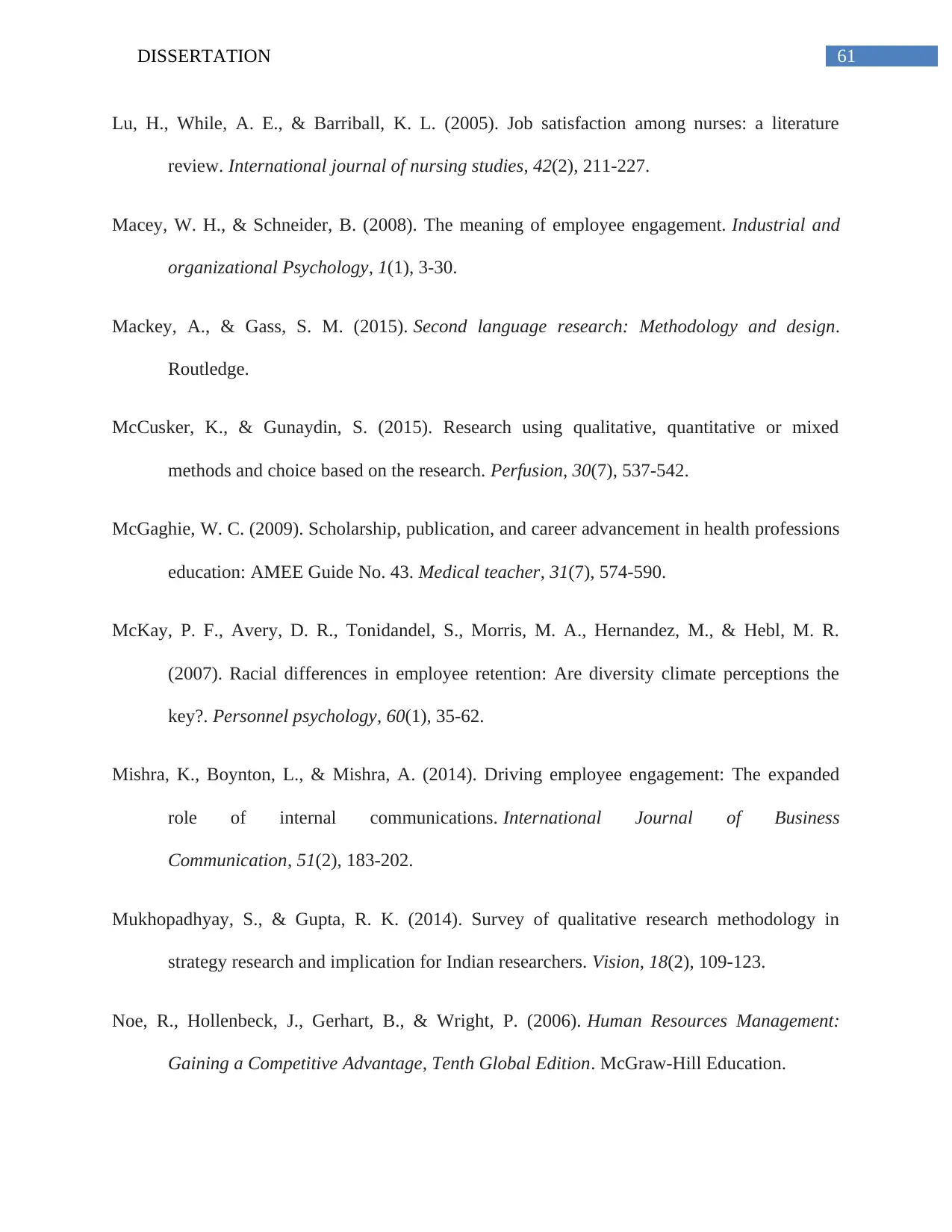
61DISSERTATION
Lu, H., While, A. E., & Barriball, K. L. (2005). Job satisfaction among nurses: a literature
review. International journal of nursing studies, 42(2), 211-227.
Macey, W. H., & Schneider, B. (2008). The meaning of employee engagement. Industrial and
organizational Psychology, 1(1), 3-30.
Mackey, A., & Gass, S. M. (2015). Second language research: Methodology and design.
Routledge.
McCusker, K., & Gunaydin, S. (2015). Research using qualitative, quantitative or mixed
methods and choice based on the research. Perfusion, 30(7), 537-542.
McGaghie, W. C. (2009). Scholarship, publication, and career advancement in health professions
education: AMEE Guide No. 43. Medical teacher, 31(7), 574-590.
McKay, P. F., Avery, D. R., Tonidandel, S., Morris, M. A., Hernandez, M., & Hebl, M. R.
(2007). Racial differences in employee retention: Are diversity climate perceptions the
key?. Personnel psychology, 60(1), 35-62.
Mishra, K., Boynton, L., & Mishra, A. (2014). Driving employee engagement: The expanded
role of internal communications. International Journal of Business
Communication, 51(2), 183-202.
Mukhopadhyay, S., & Gupta, R. K. (2014). Survey of qualitative research methodology in
strategy research and implication for Indian researchers. Vision, 18(2), 109-123.
Noe, R., Hollenbeck, J., Gerhart, B., & Wright, P. (2006). Human Resources Management:
Gaining a Competitive Advantage, Tenth Global Edition. McGraw-Hill Education.
Lu, H., While, A. E., & Barriball, K. L. (2005). Job satisfaction among nurses: a literature
review. International journal of nursing studies, 42(2), 211-227.
Macey, W. H., & Schneider, B. (2008). The meaning of employee engagement. Industrial and
organizational Psychology, 1(1), 3-30.
Mackey, A., & Gass, S. M. (2015). Second language research: Methodology and design.
Routledge.
McCusker, K., & Gunaydin, S. (2015). Research using qualitative, quantitative or mixed
methods and choice based on the research. Perfusion, 30(7), 537-542.
McGaghie, W. C. (2009). Scholarship, publication, and career advancement in health professions
education: AMEE Guide No. 43. Medical teacher, 31(7), 574-590.
McKay, P. F., Avery, D. R., Tonidandel, S., Morris, M. A., Hernandez, M., & Hebl, M. R.
(2007). Racial differences in employee retention: Are diversity climate perceptions the
key?. Personnel psychology, 60(1), 35-62.
Mishra, K., Boynton, L., & Mishra, A. (2014). Driving employee engagement: The expanded
role of internal communications. International Journal of Business
Communication, 51(2), 183-202.
Mukhopadhyay, S., & Gupta, R. K. (2014). Survey of qualitative research methodology in
strategy research and implication for Indian researchers. Vision, 18(2), 109-123.
Noe, R., Hollenbeck, J., Gerhart, B., & Wright, P. (2006). Human Resources Management:
Gaining a Competitive Advantage, Tenth Global Edition. McGraw-Hill Education.
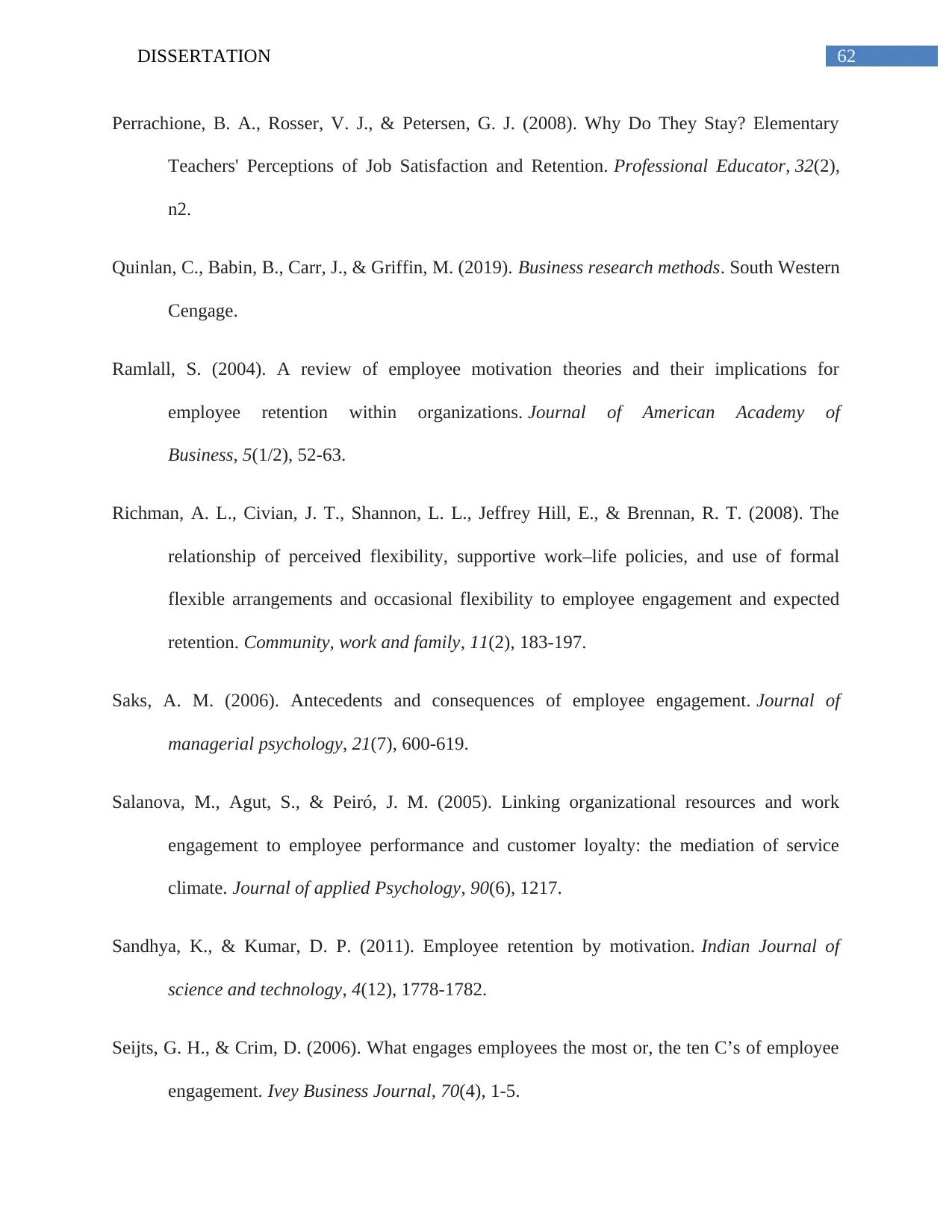
62DISSERTATION
Perrachione, B. A., Rosser, V. J., & Petersen, G. J. (2008). Why Do They Stay? Elementary
Teachers' Perceptions of Job Satisfaction and Retention. Professional Educator, 32(2),
n2.
Quinlan, C., Babin, B., Carr, J., & Griffin, M. (2019). Business research methods. South Western
Cengage.
Ramlall, S. (2004). A review of employee motivation theories and their implications for
employee retention within organizations. Journal of American Academy of
Business, 5(1/2), 52-63.
Richman, A. L., Civian, J. T., Shannon, L. L., Jeffrey Hill, E., & Brennan, R. T. (2008). The
relationship of perceived flexibility, supportive work–life policies, and use of formal
flexible arrangements and occasional flexibility to employee engagement and expected
retention. Community, work and family, 11(2), 183-197.
Saks, A. M. (2006). Antecedents and consequences of employee engagement. Journal of
managerial psychology, 21(7), 600-619.
Salanova, M., Agut, S., & Peiró, J. M. (2005). Linking organizational resources and work
engagement to employee performance and customer loyalty: the mediation of service
climate. Journal of applied Psychology, 90(6), 1217.
Sandhya, K., & Kumar, D. P. (2011). Employee retention by motivation. Indian Journal of
science and technology, 4(12), 1778-1782.
Seijts, G. H., & Crim, D. (2006). What engages employees the most or, the ten C’s of employee
engagement. Ivey Business Journal, 70(4), 1-5.
Perrachione, B. A., Rosser, V. J., & Petersen, G. J. (2008). Why Do They Stay? Elementary
Teachers' Perceptions of Job Satisfaction and Retention. Professional Educator, 32(2),
n2.
Quinlan, C., Babin, B., Carr, J., & Griffin, M. (2019). Business research methods. South Western
Cengage.
Ramlall, S. (2004). A review of employee motivation theories and their implications for
employee retention within organizations. Journal of American Academy of
Business, 5(1/2), 52-63.
Richman, A. L., Civian, J. T., Shannon, L. L., Jeffrey Hill, E., & Brennan, R. T. (2008). The
relationship of perceived flexibility, supportive work–life policies, and use of formal
flexible arrangements and occasional flexibility to employee engagement and expected
retention. Community, work and family, 11(2), 183-197.
Saks, A. M. (2006). Antecedents and consequences of employee engagement. Journal of
managerial psychology, 21(7), 600-619.
Salanova, M., Agut, S., & Peiró, J. M. (2005). Linking organizational resources and work
engagement to employee performance and customer loyalty: the mediation of service
climate. Journal of applied Psychology, 90(6), 1217.
Sandhya, K., & Kumar, D. P. (2011). Employee retention by motivation. Indian Journal of
science and technology, 4(12), 1778-1782.
Seijts, G. H., & Crim, D. (2006). What engages employees the most or, the ten C’s of employee
engagement. Ivey Business Journal, 70(4), 1-5.
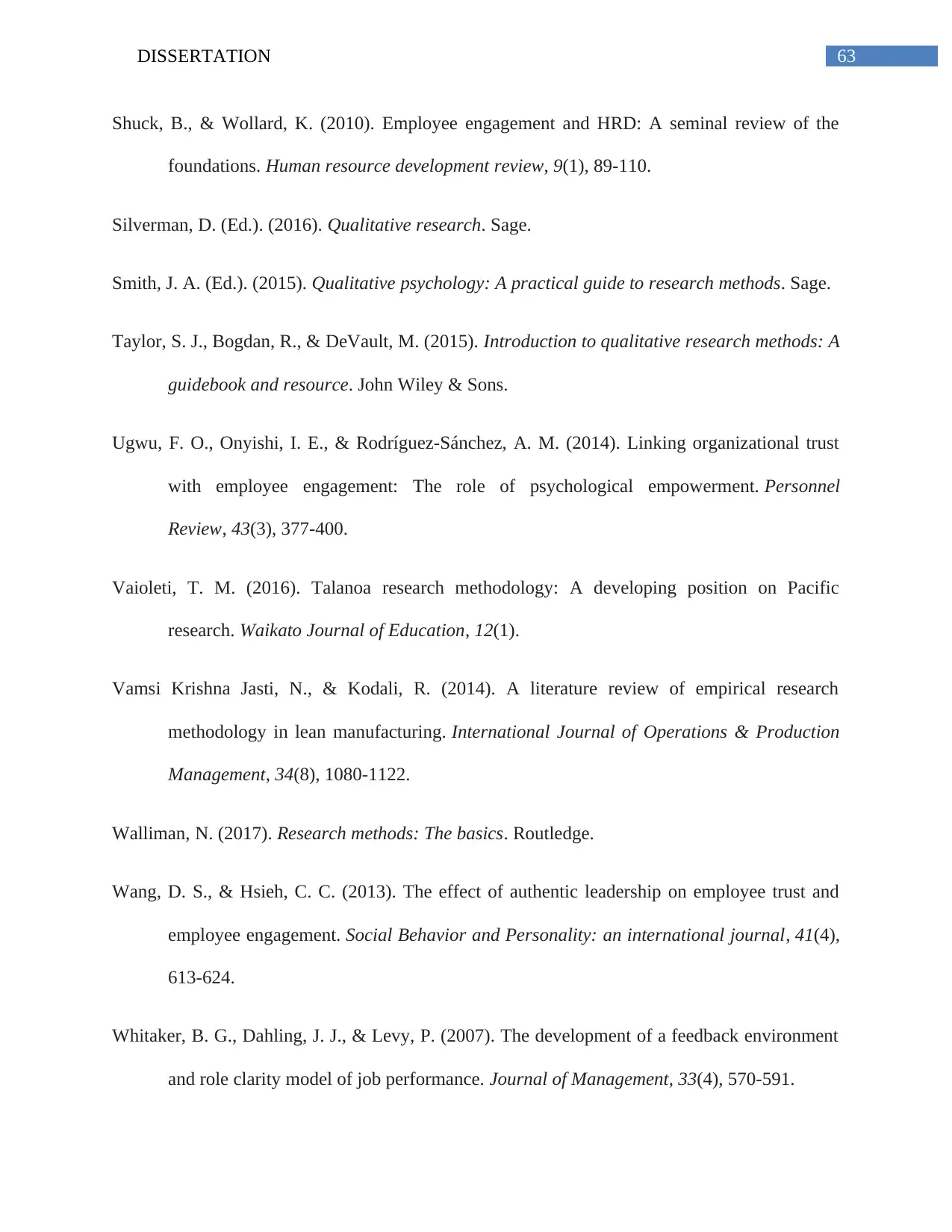
63DISSERTATION
Shuck, B., & Wollard, K. (2010). Employee engagement and HRD: A seminal review of the
foundations. Human resource development review, 9(1), 89-110.
Silverman, D. (Ed.). (2016). Qualitative research. Sage.
Smith, J. A. (Ed.). (2015). Qualitative psychology: A practical guide to research methods. Sage.
Taylor, S. J., Bogdan, R., & DeVault, M. (2015). Introduction to qualitative research methods: A
guidebook and resource. John Wiley & Sons.
Ugwu, F. O., Onyishi, I. E., & Rodríguez-Sánchez, A. M. (2014). Linking organizational trust
with employee engagement: The role of psychological empowerment. Personnel
Review, 43(3), 377-400.
Vaioleti, T. M. (2016). Talanoa research methodology: A developing position on Pacific
research. Waikato Journal of Education, 12(1).
Vamsi Krishna Jasti, N., & Kodali, R. (2014). A literature review of empirical research
methodology in lean manufacturing. International Journal of Operations & Production
Management, 34(8), 1080-1122.
Walliman, N. (2017). Research methods: The basics. Routledge.
Wang, D. S., & Hsieh, C. C. (2013). The effect of authentic leadership on employee trust and
employee engagement. Social Behavior and Personality: an international journal, 41(4),
613-624.
Whitaker, B. G., Dahling, J. J., & Levy, P. (2007). The development of a feedback environment
and role clarity model of job performance. Journal of Management, 33(4), 570-591.
Shuck, B., & Wollard, K. (2010). Employee engagement and HRD: A seminal review of the
foundations. Human resource development review, 9(1), 89-110.
Silverman, D. (Ed.). (2016). Qualitative research. Sage.
Smith, J. A. (Ed.). (2015). Qualitative psychology: A practical guide to research methods. Sage.
Taylor, S. J., Bogdan, R., & DeVault, M. (2015). Introduction to qualitative research methods: A
guidebook and resource. John Wiley & Sons.
Ugwu, F. O., Onyishi, I. E., & Rodríguez-Sánchez, A. M. (2014). Linking organizational trust
with employee engagement: The role of psychological empowerment. Personnel
Review, 43(3), 377-400.
Vaioleti, T. M. (2016). Talanoa research methodology: A developing position on Pacific
research. Waikato Journal of Education, 12(1).
Vamsi Krishna Jasti, N., & Kodali, R. (2014). A literature review of empirical research
methodology in lean manufacturing. International Journal of Operations & Production
Management, 34(8), 1080-1122.
Walliman, N. (2017). Research methods: The basics. Routledge.
Wang, D. S., & Hsieh, C. C. (2013). The effect of authentic leadership on employee trust and
employee engagement. Social Behavior and Personality: an international journal, 41(4),
613-624.
Whitaker, B. G., Dahling, J. J., & Levy, P. (2007). The development of a feedback environment
and role clarity model of job performance. Journal of Management, 33(4), 570-591.
Secure Best Marks with AI Grader
Need help grading? Try our AI Grader for instant feedback on your assignments.
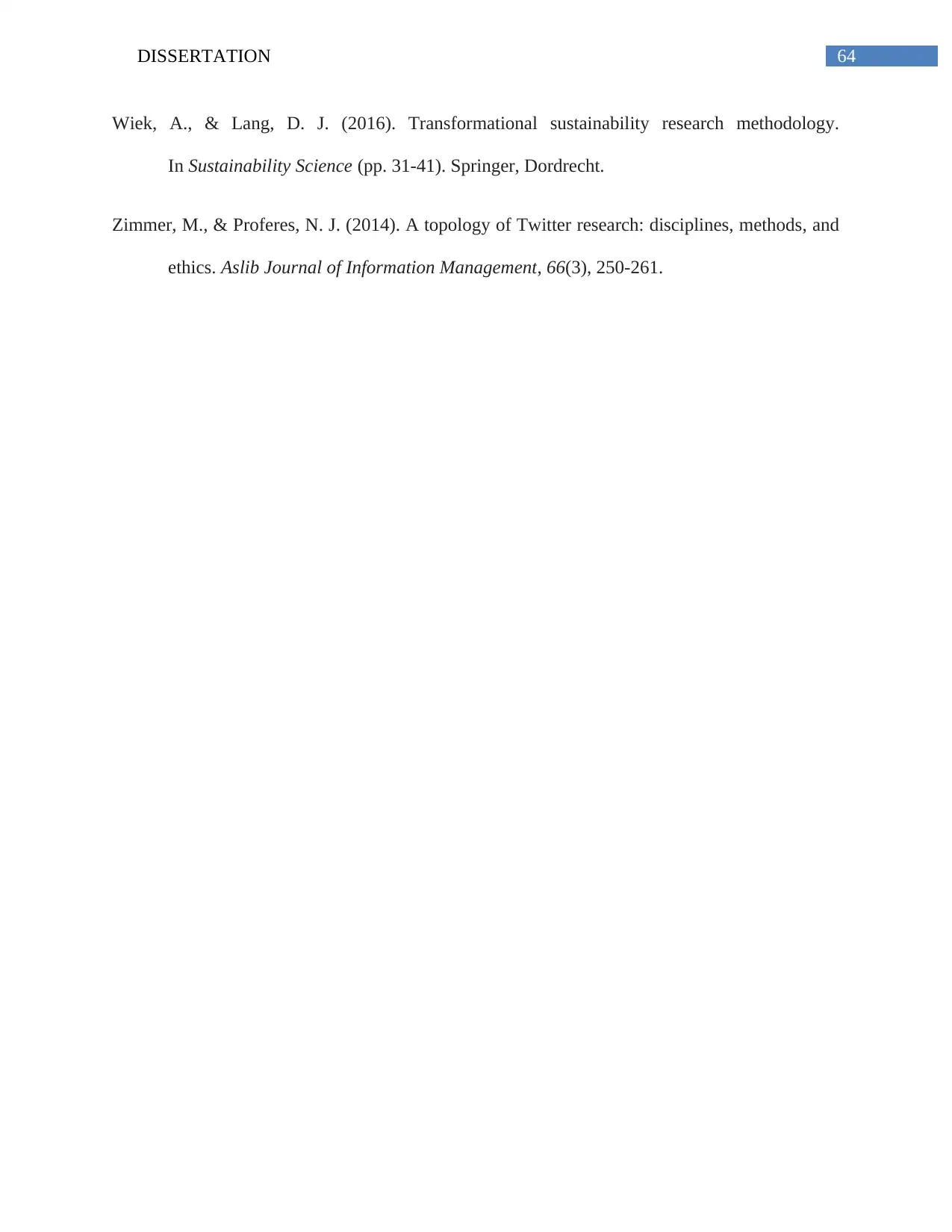
64DISSERTATION
Wiek, A., & Lang, D. J. (2016). Transformational sustainability research methodology.
In Sustainability Science (pp. 31-41). Springer, Dordrecht.
Zimmer, M., & Proferes, N. J. (2014). A topology of Twitter research: disciplines, methods, and
ethics. Aslib Journal of Information Management, 66(3), 250-261.
Wiek, A., & Lang, D. J. (2016). Transformational sustainability research methodology.
In Sustainability Science (pp. 31-41). Springer, Dordrecht.
Zimmer, M., & Proferes, N. J. (2014). A topology of Twitter research: disciplines, methods, and
ethics. Aslib Journal of Information Management, 66(3), 250-261.
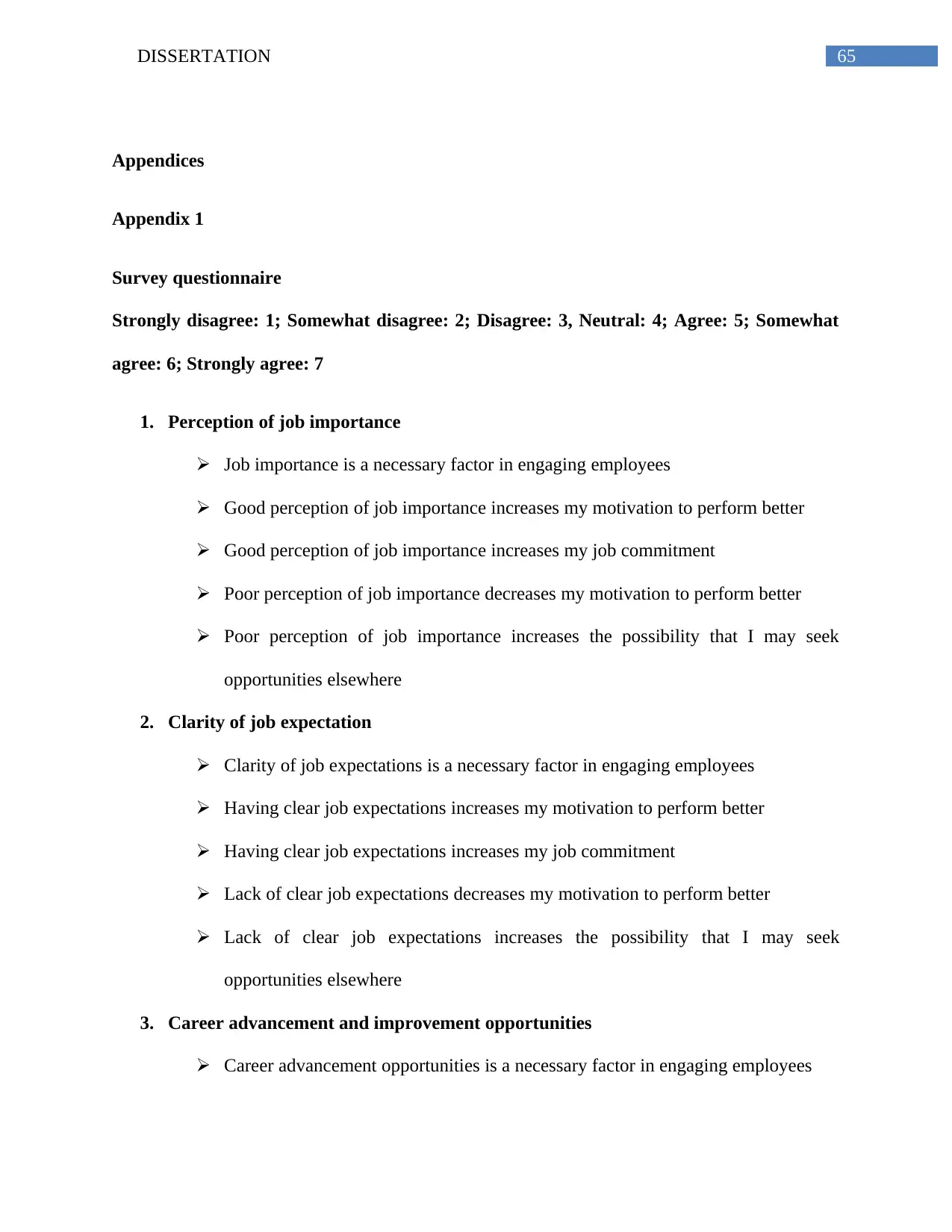
65DISSERTATION
Appendices
Appendix 1
Survey questionnaire
Strongly disagree: 1; Somewhat disagree: 2; Disagree: 3, Neutral: 4; Agree: 5; Somewhat
agree: 6; Strongly agree: 7
1. Perception of job importance
Job importance is a necessary factor in engaging employees
Good perception of job importance increases my motivation to perform better
Good perception of job importance increases my job commitment
Poor perception of job importance decreases my motivation to perform better
Poor perception of job importance increases the possibility that I may seek
opportunities elsewhere
2. Clarity of job expectation
Clarity of job expectations is a necessary factor in engaging employees
Having clear job expectations increases my motivation to perform better
Having clear job expectations increases my job commitment
Lack of clear job expectations decreases my motivation to perform better
Lack of clear job expectations increases the possibility that I may seek
opportunities elsewhere
3. Career advancement and improvement opportunities
Career advancement opportunities is a necessary factor in engaging employees
Appendices
Appendix 1
Survey questionnaire
Strongly disagree: 1; Somewhat disagree: 2; Disagree: 3, Neutral: 4; Agree: 5; Somewhat
agree: 6; Strongly agree: 7
1. Perception of job importance
Job importance is a necessary factor in engaging employees
Good perception of job importance increases my motivation to perform better
Good perception of job importance increases my job commitment
Poor perception of job importance decreases my motivation to perform better
Poor perception of job importance increases the possibility that I may seek
opportunities elsewhere
2. Clarity of job expectation
Clarity of job expectations is a necessary factor in engaging employees
Having clear job expectations increases my motivation to perform better
Having clear job expectations increases my job commitment
Lack of clear job expectations decreases my motivation to perform better
Lack of clear job expectations increases the possibility that I may seek
opportunities elsewhere
3. Career advancement and improvement opportunities
Career advancement opportunities is a necessary factor in engaging employees
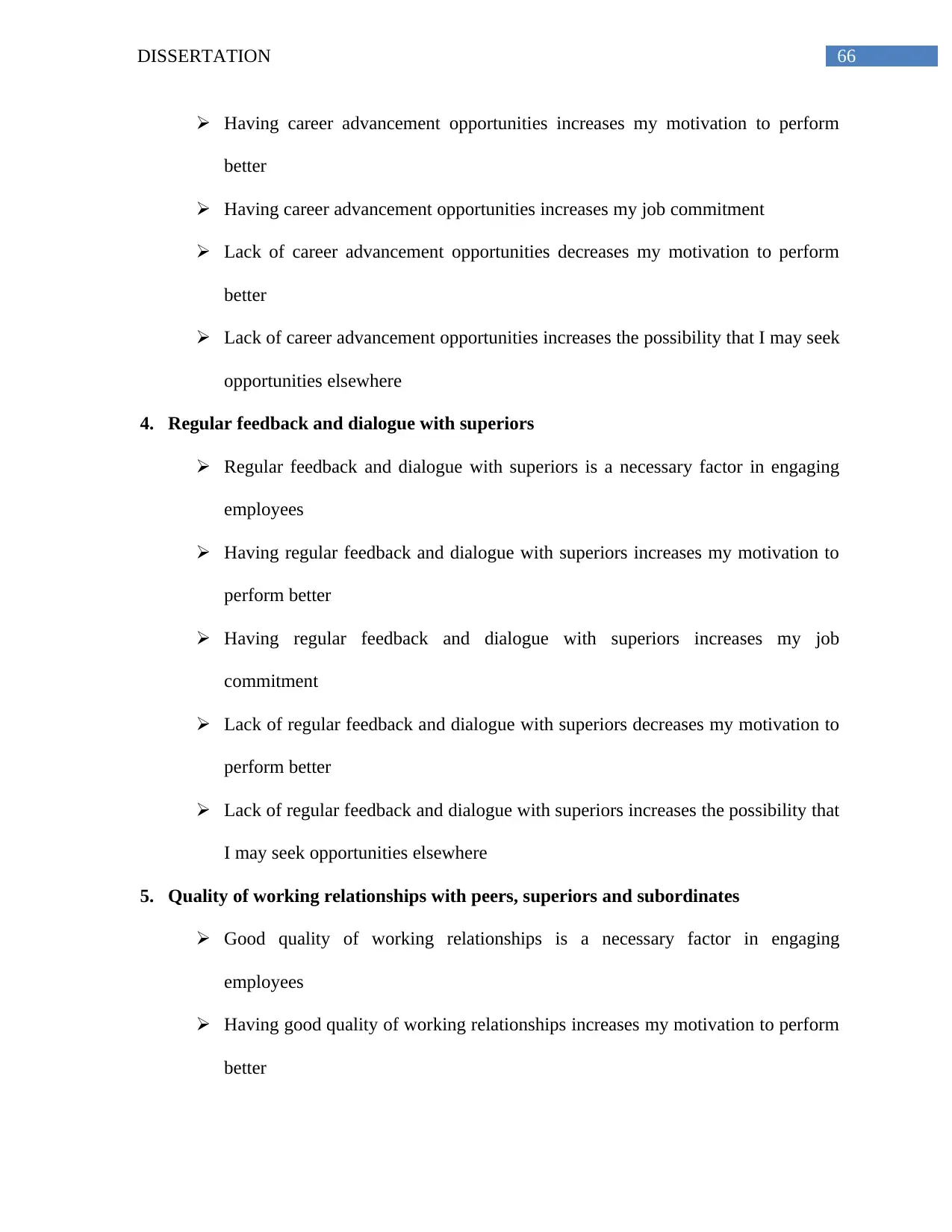
66DISSERTATION
Having career advancement opportunities increases my motivation to perform
better
Having career advancement opportunities increases my job commitment
Lack of career advancement opportunities decreases my motivation to perform
better
Lack of career advancement opportunities increases the possibility that I may seek
opportunities elsewhere
4. Regular feedback and dialogue with superiors
Regular feedback and dialogue with superiors is a necessary factor in engaging
employees
Having regular feedback and dialogue with superiors increases my motivation to
perform better
Having regular feedback and dialogue with superiors increases my job
commitment
Lack of regular feedback and dialogue with superiors decreases my motivation to
perform better
Lack of regular feedback and dialogue with superiors increases the possibility that
I may seek opportunities elsewhere
5. Quality of working relationships with peers, superiors and subordinates
Good quality of working relationships is a necessary factor in engaging
employees
Having good quality of working relationships increases my motivation to perform
better
Having career advancement opportunities increases my motivation to perform
better
Having career advancement opportunities increases my job commitment
Lack of career advancement opportunities decreases my motivation to perform
better
Lack of career advancement opportunities increases the possibility that I may seek
opportunities elsewhere
4. Regular feedback and dialogue with superiors
Regular feedback and dialogue with superiors is a necessary factor in engaging
employees
Having regular feedback and dialogue with superiors increases my motivation to
perform better
Having regular feedback and dialogue with superiors increases my job
commitment
Lack of regular feedback and dialogue with superiors decreases my motivation to
perform better
Lack of regular feedback and dialogue with superiors increases the possibility that
I may seek opportunities elsewhere
5. Quality of working relationships with peers, superiors and subordinates
Good quality of working relationships is a necessary factor in engaging
employees
Having good quality of working relationships increases my motivation to perform
better
Paraphrase This Document
Need a fresh take? Get an instant paraphrase of this document with our AI Paraphraser
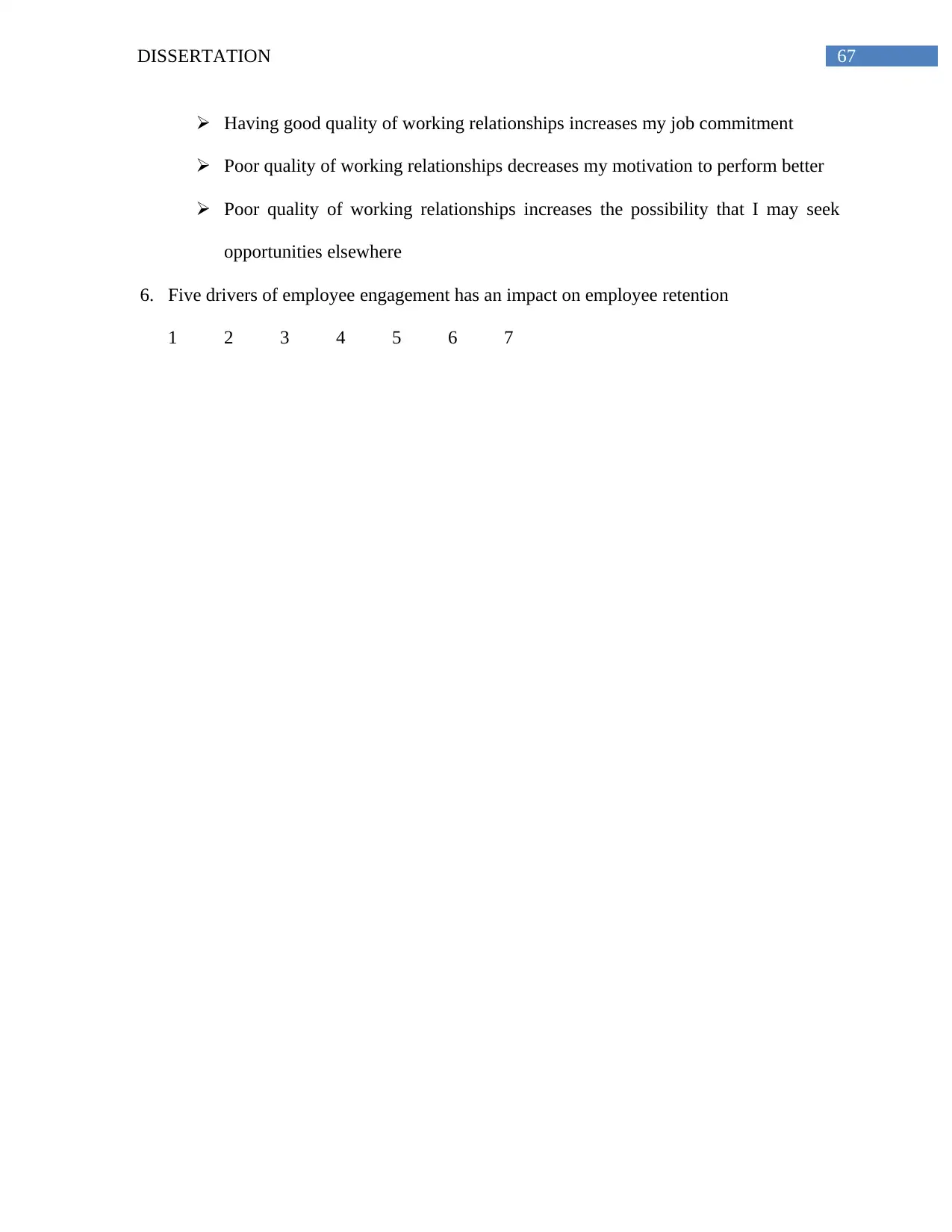
67DISSERTATION
Having good quality of working relationships increases my job commitment
Poor quality of working relationships decreases my motivation to perform better
Poor quality of working relationships increases the possibility that I may seek
opportunities elsewhere
6. Five drivers of employee engagement has an impact on employee retention
1 2 3 4 5 6 7
Having good quality of working relationships increases my job commitment
Poor quality of working relationships decreases my motivation to perform better
Poor quality of working relationships increases the possibility that I may seek
opportunities elsewhere
6. Five drivers of employee engagement has an impact on employee retention
1 2 3 4 5 6 7
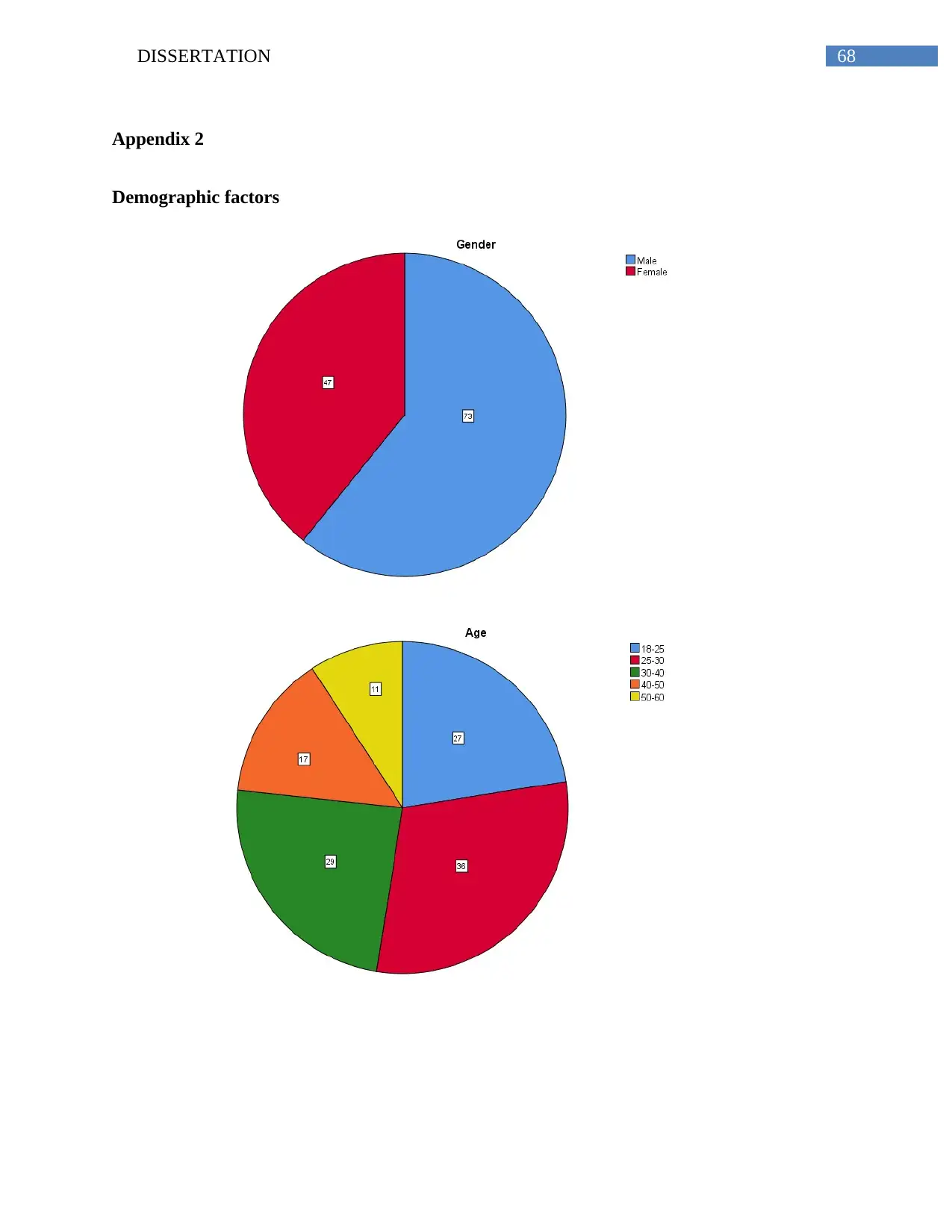
68DISSERTATION
Appendix 2
Demographic factors
Appendix 2
Demographic factors
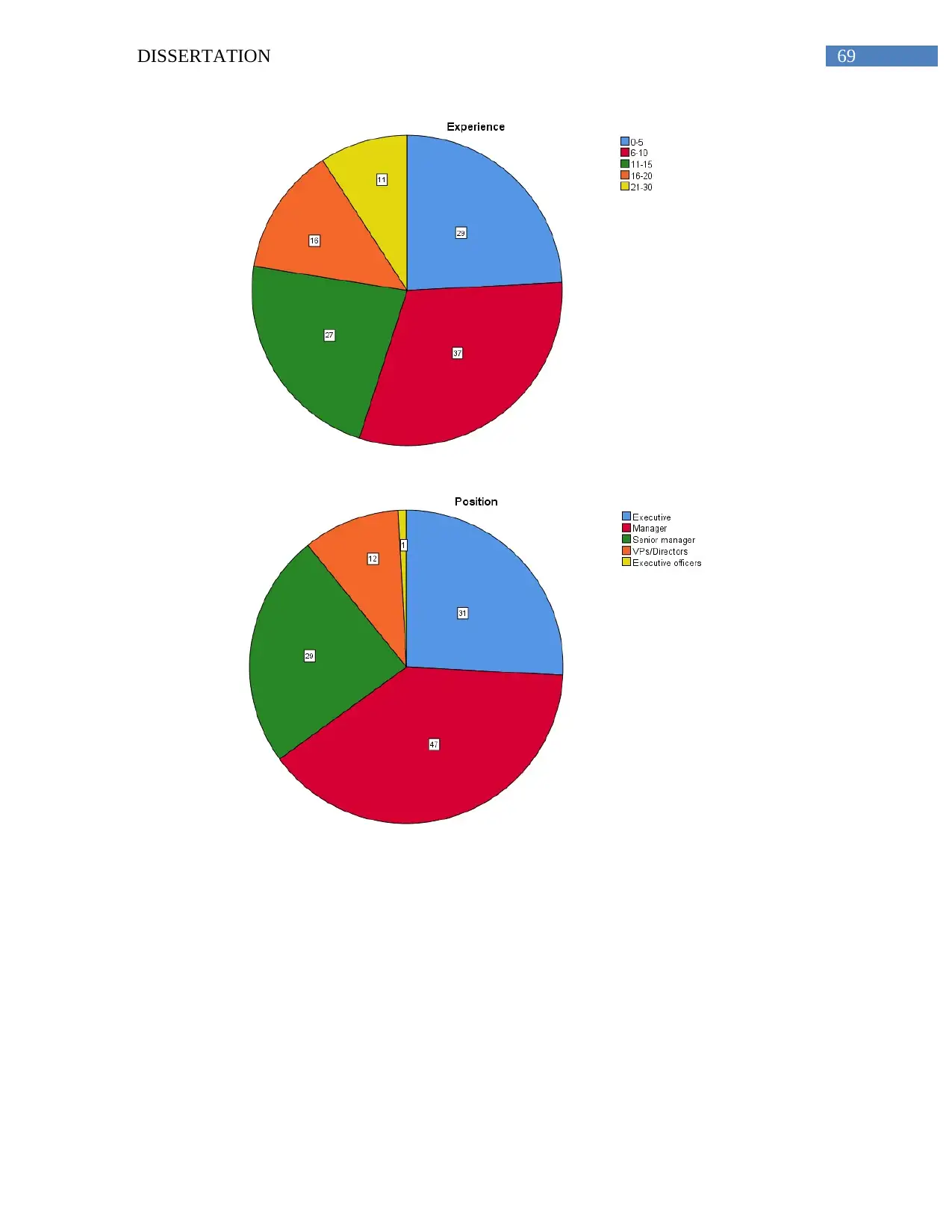
69DISSERTATION
1 out of 70
Related Documents
Your All-in-One AI-Powered Toolkit for Academic Success.
+13062052269
info@desklib.com
Available 24*7 on WhatsApp / Email
![[object Object]](/_next/static/media/star-bottom.7253800d.svg)
Unlock your academic potential
© 2024 | Zucol Services PVT LTD | All rights reserved.





